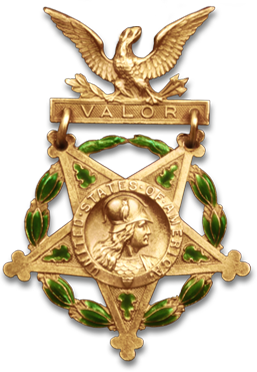
/arc-anglerfish-arc2-prod-mco.s3.amazonaws.com/public/RYSETL5FM5DJXA3ADKTAU3KDFQ.jpg)
by
President Joseph Biden Jr.
Transcript of Helicopter Extraction Tape Recording
(thebattleofkontum.com in the audio section.}
The Senior General Officer Board recommended approval of the Medal of Honor
The President must sign off on the Boards recommendation as the final authority in the approval process.
The Medal of Honor was presented on July 5, 2022 by President Joseph Biden Jr. at a White House ceremony.
The Secretary of the Army's Board for Correction of Military Records rendered a decision in January, 2014 to allow a board of officers to review/render a recommendation for the upgrade to the Medal of Honor for Major (retired) John J. Duffy. The recommendation was made after extensive and careful review of new evidence including a tape recording of events and five new eyewitnesses, all highly decorated combat veterans.
General Frederick C. Weyand initiated this action through the office of Senator Inouye (HI).
An additional witness statement, from the senior General officer in the region directing the battle has been presented. BG George E. Wear extract: The 11th Airborne Battalion was placed on Firebase Charlie, the most significant terrain between the enemy and Kontum. That 470-man force held their blocking position for two weeks against intense attacks by multiple North Vietnamese Army (NVA) battalions.
Major John Duffy, the sole American advisor with the 11th Battalion distinguished himself conspicuously by his gallantry and intrepididity at the risk of his life above and beyond the call of duty while engaged in action against the attacking North Vietnamese Army's 320th Division at Firebase Charlie. His bravery and most significantly, his self sacrifice were unyielding in the face of a determined enemy....
Major Duffy suffered five wounds and refused to be medically evacuated twice. He performed as an air controller placing numerous attack aircraft and helicopter gunships on enemy positions and formations. He volunteered to be the rear guard and was instrumental in the escape of the remnants of the battalion from "Charlie". His counterpart, wounded while fighting in the rear guard action, turned over command of the battalion to Major Duffy. Their night escape through the jungle was hit by friendly artillery fire (7 WIA and 3 KIA). Major Duffy promptly gave the "Check Fire" order, stopping what was a deadly barrage. The group was ambushed the next morning by another NVA battalion. Major Duffy led the break-out force, secured a Landing Zone, and requested emergency extraction, all while fighting off the pursuing enemy for an hour. When asked to board the first extraction helicopter, he refused, "I will be the last man out". The last helicopter lifted off under fire. Major Duffy, standing on the skid, caught a wounded Vietnamese officer falling from the aircraft and threw him back into the ship, saving his life. He then proceeded to treat the wounded helicopter crew chief who died in his arms.
Significant new evidence expounds on his actions significantly beyond the information available immediately following the action. The significance of the new evidence was confirmed by the recent decision of Army Review Board Agency.
I personally debriefed Major Duffy on April 16, 1972, the day following his extraction. I positively endorse the award recommendation for the upgrade of his award to the Medal of Honor for his actions on Fire Support Base "Charlie" during April, 1972 and I strongly recommend approval.
Excerpt from (9 page) FINDING:
January 29, 2014
DA, Board for Correction of Military Records
Renderered in the interest of "fairness and justice",
Binding and final on all Army personnel and staff.
Full relief to your request was granted.
The applicants valor and courage in April 1972 under extreme hazardous conditions is acknowledged and applauded; he is truly an American hero. Therefore, the documents he submitted are deserving of a thorough review by HRC. Therefore, his case should be forwarded to HRC for review of all material information pertinent to the case and further processing of the nomination in accordance with the decorations board standards.
Note: The Board FINDING, all witness statements/recommendations/tape recording transcript are available for detailed review below, including an extensive correspondence file.


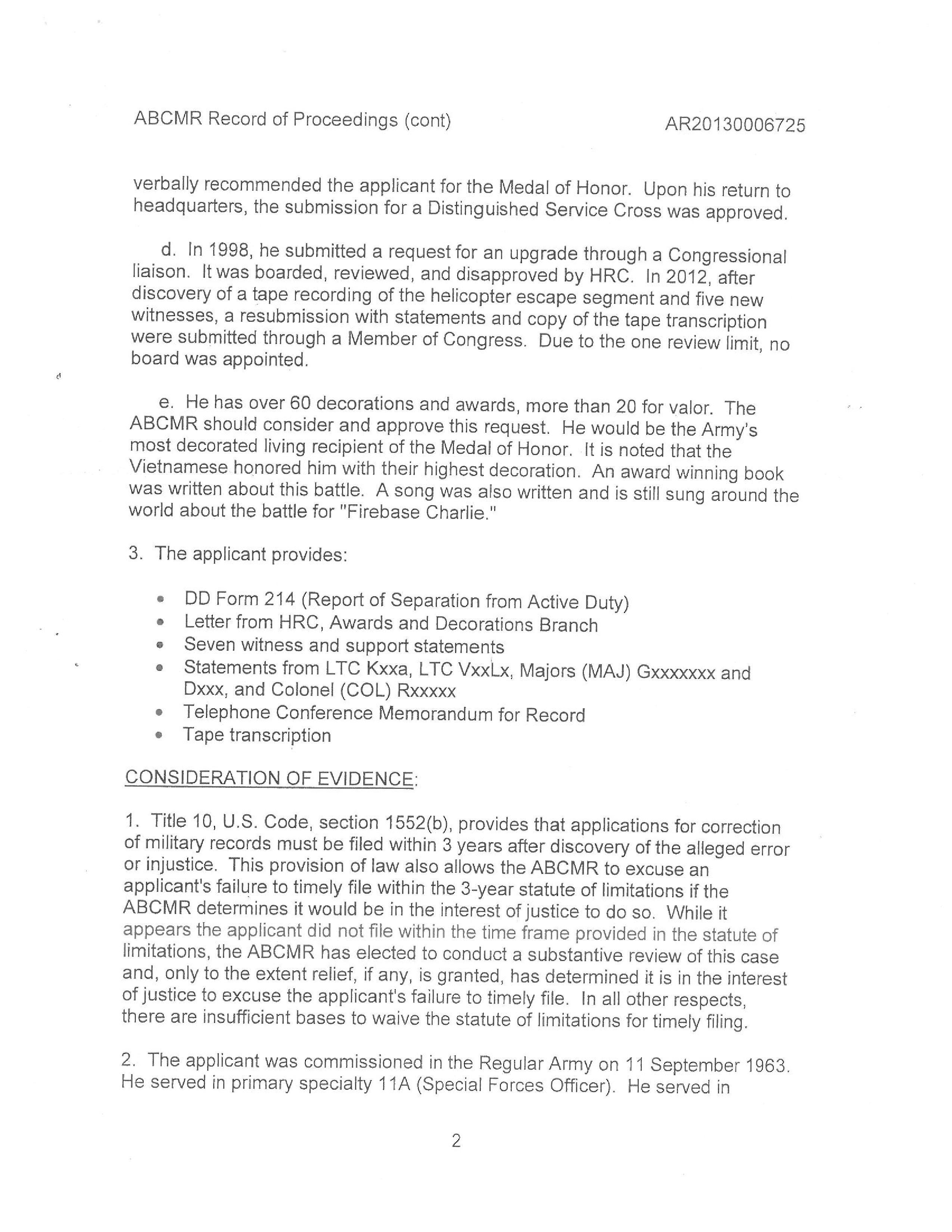
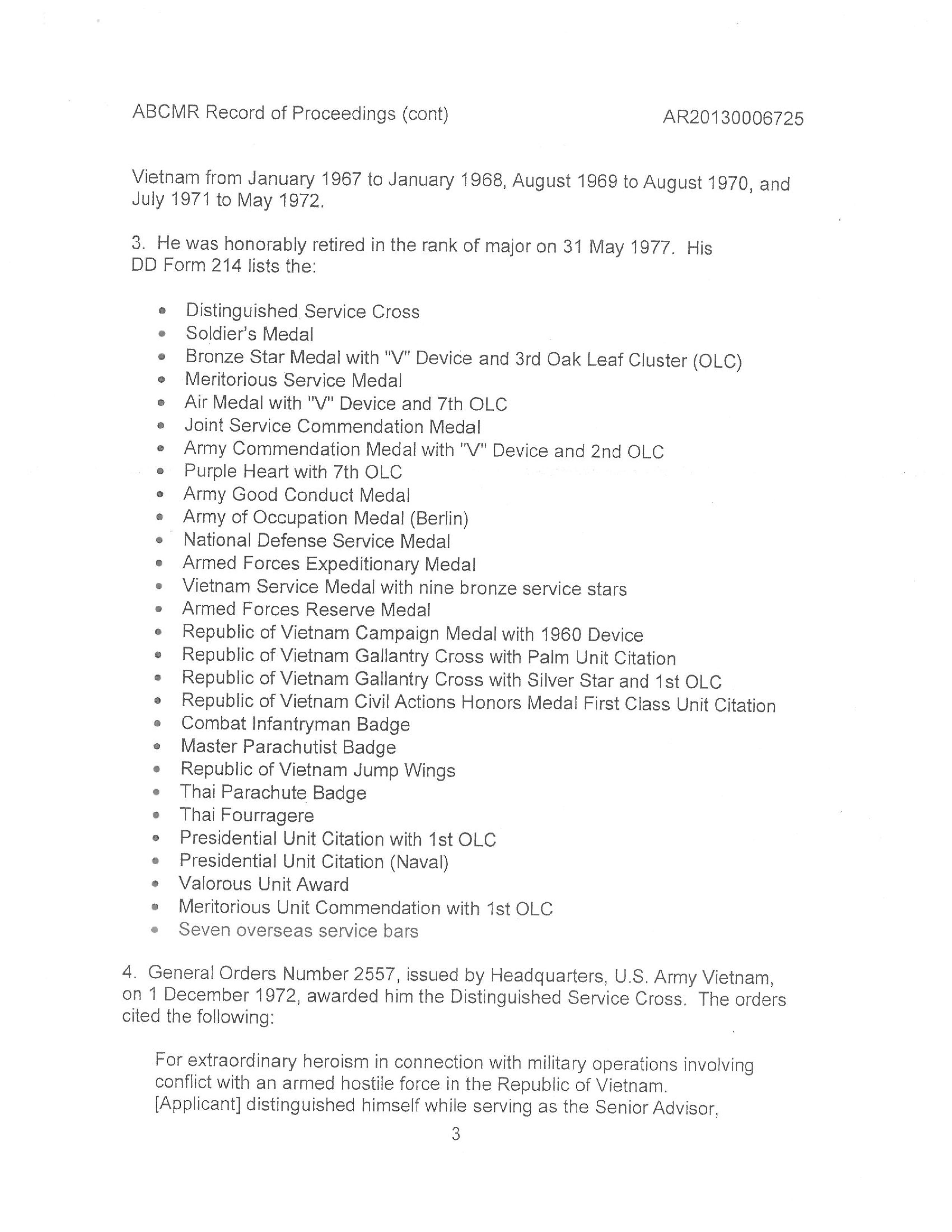

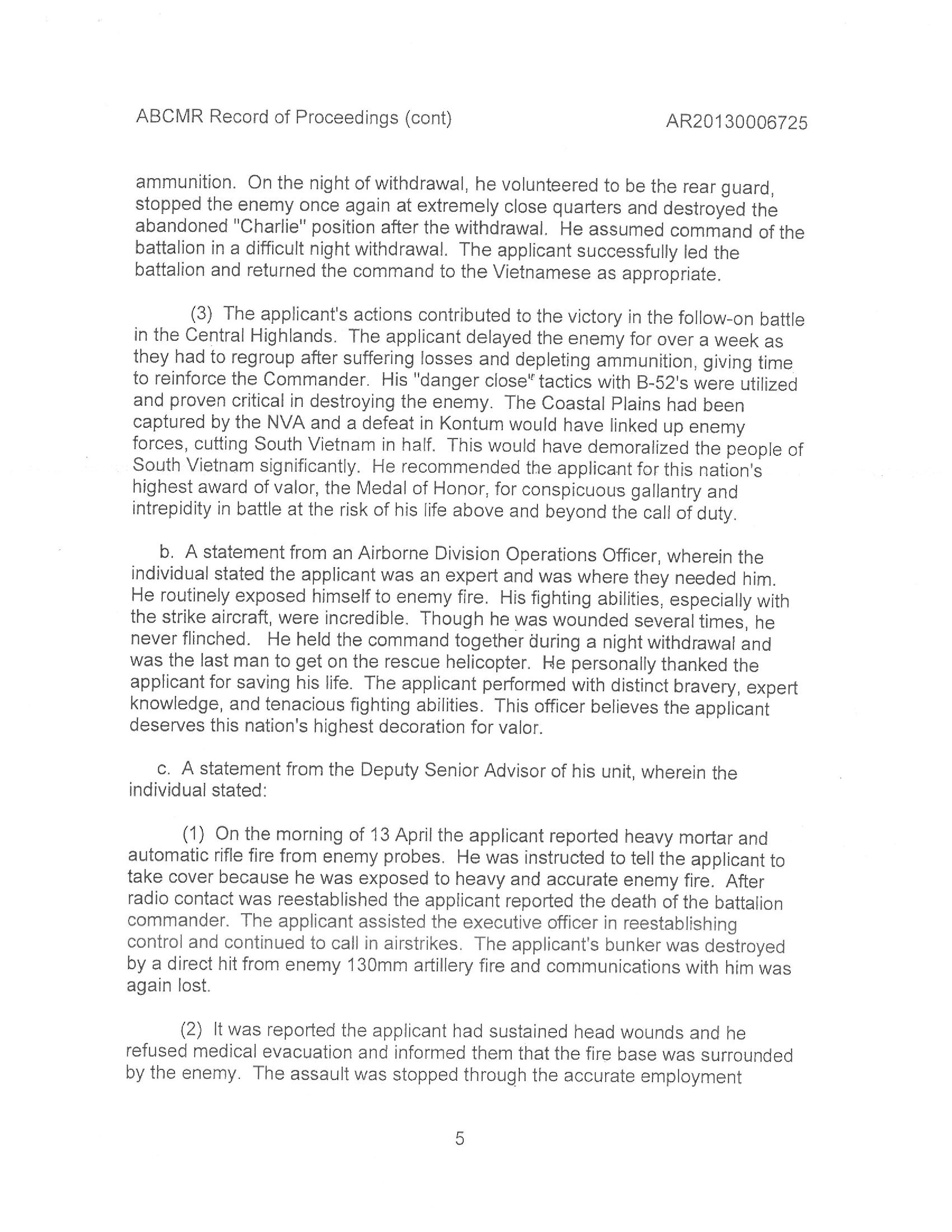
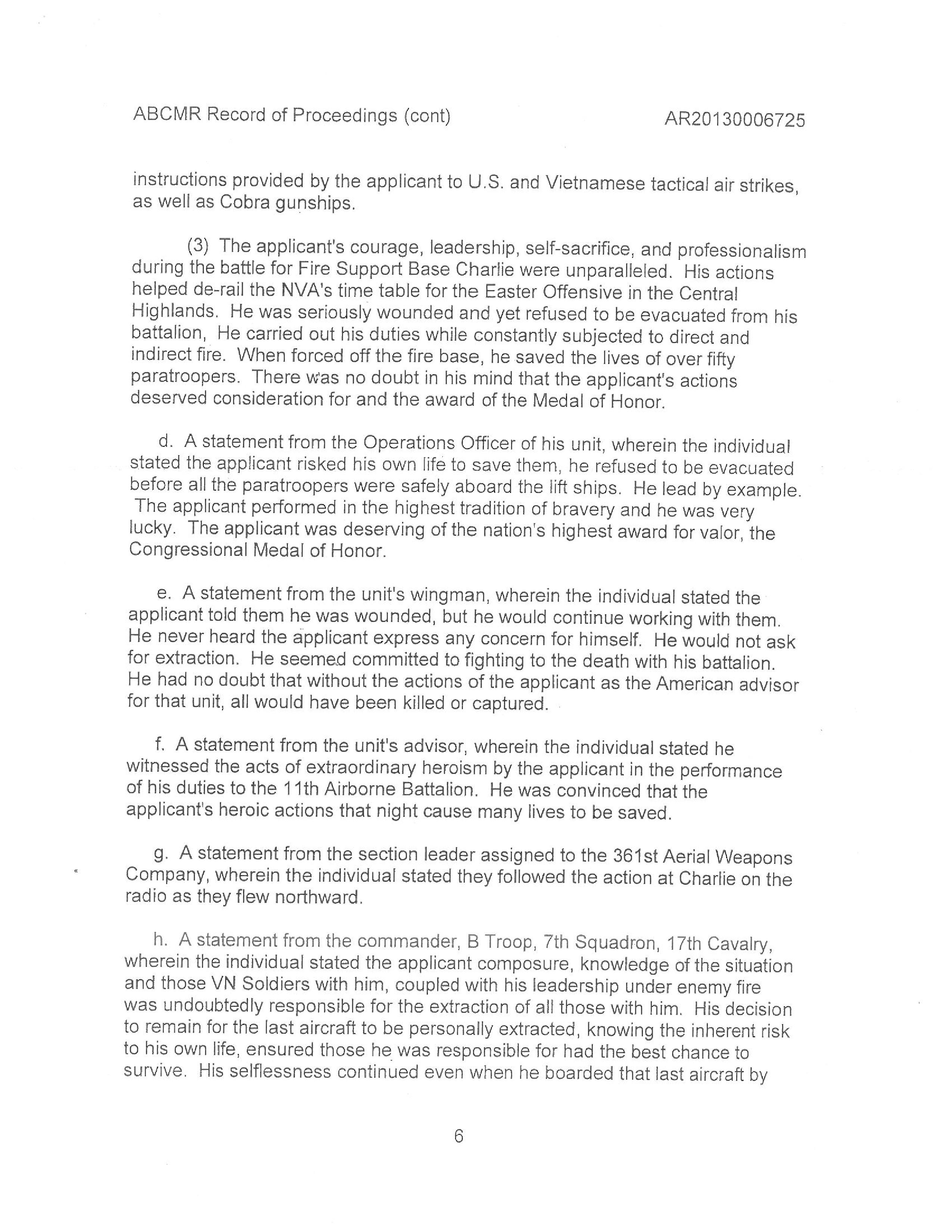
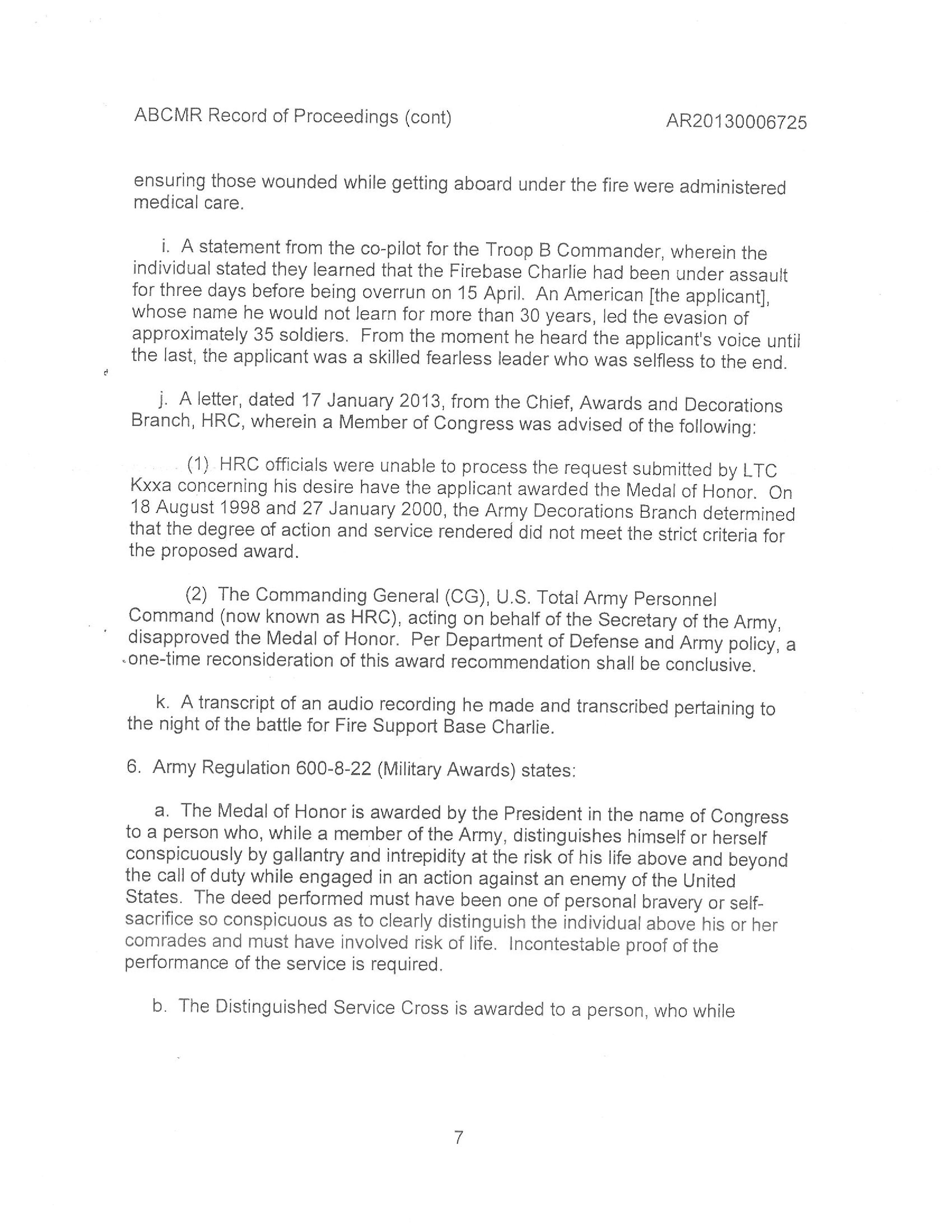
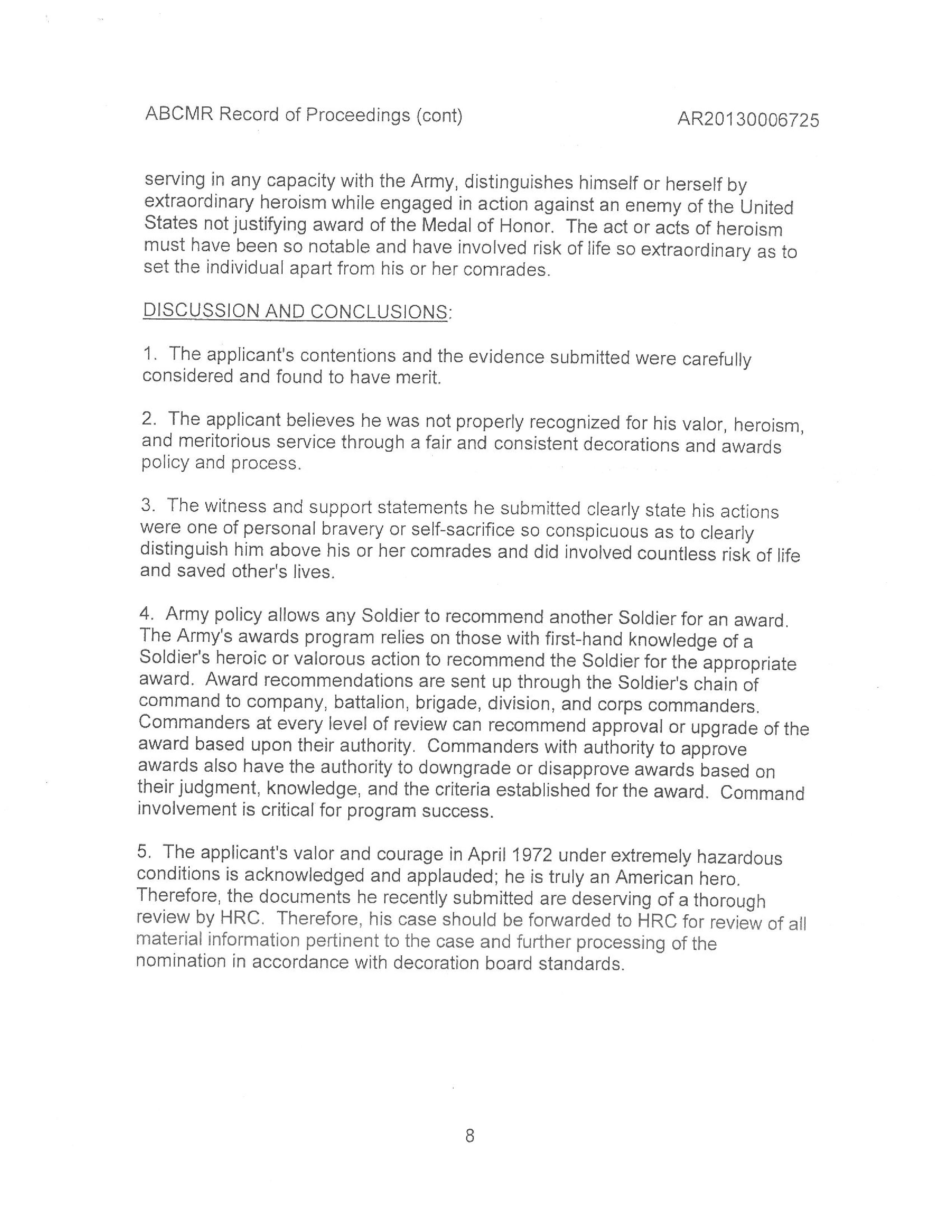

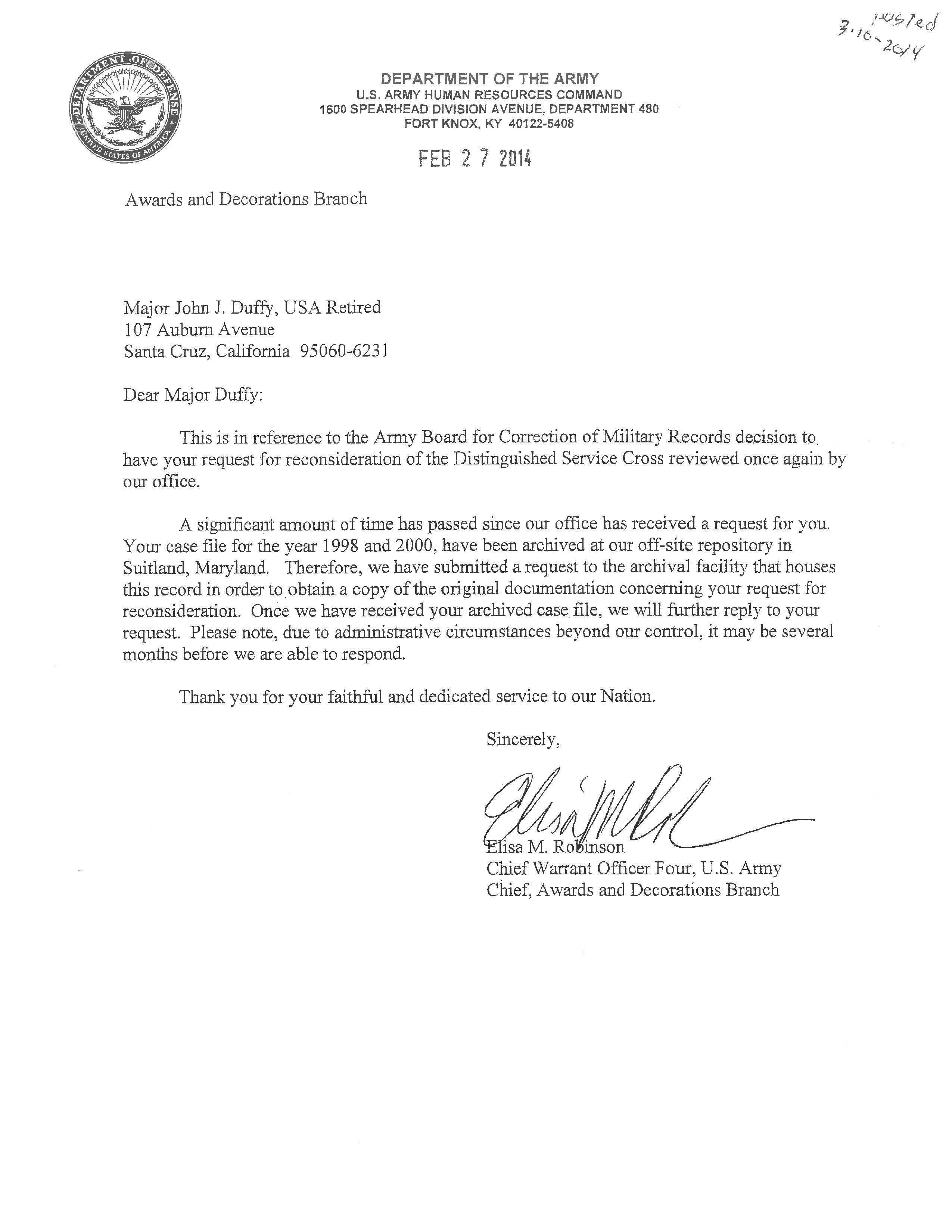
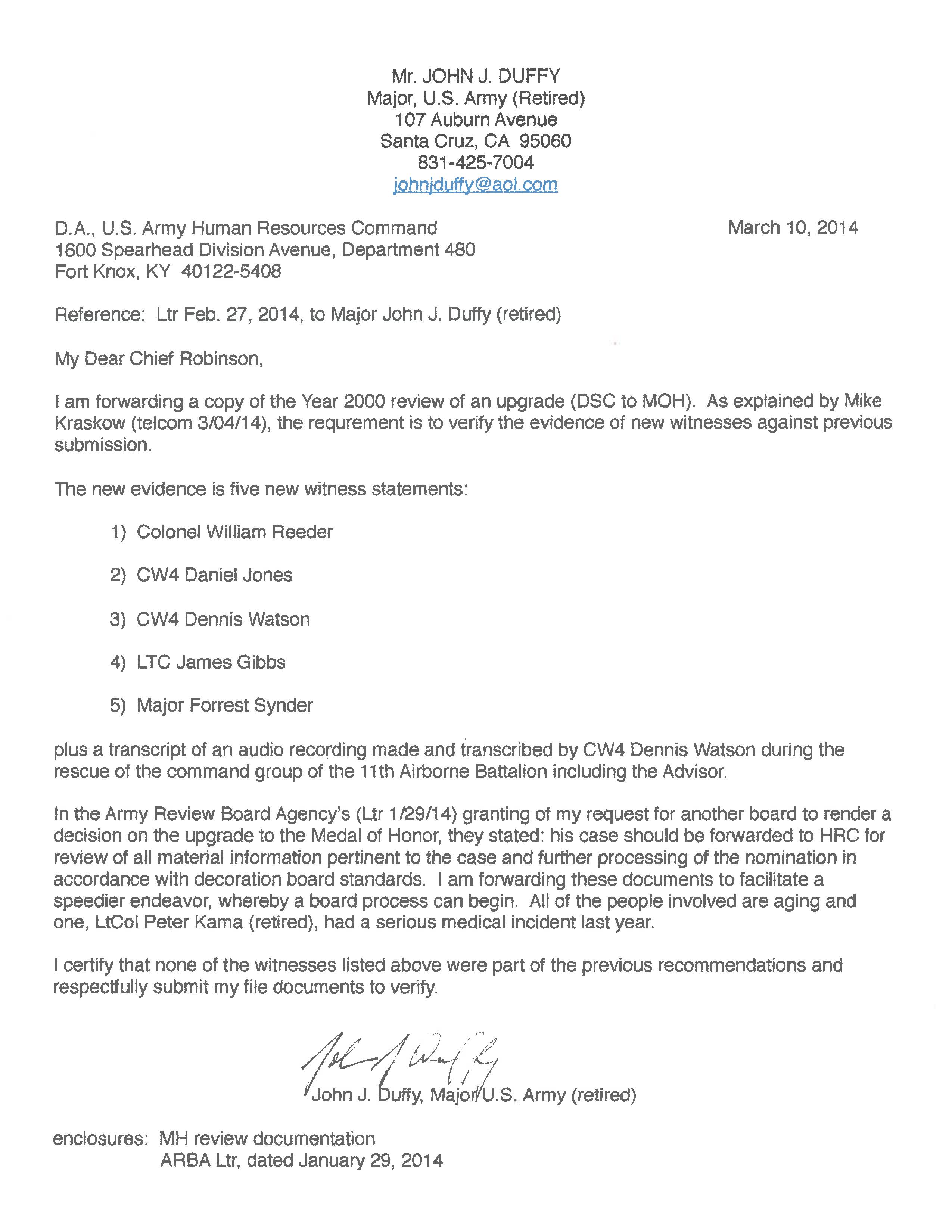
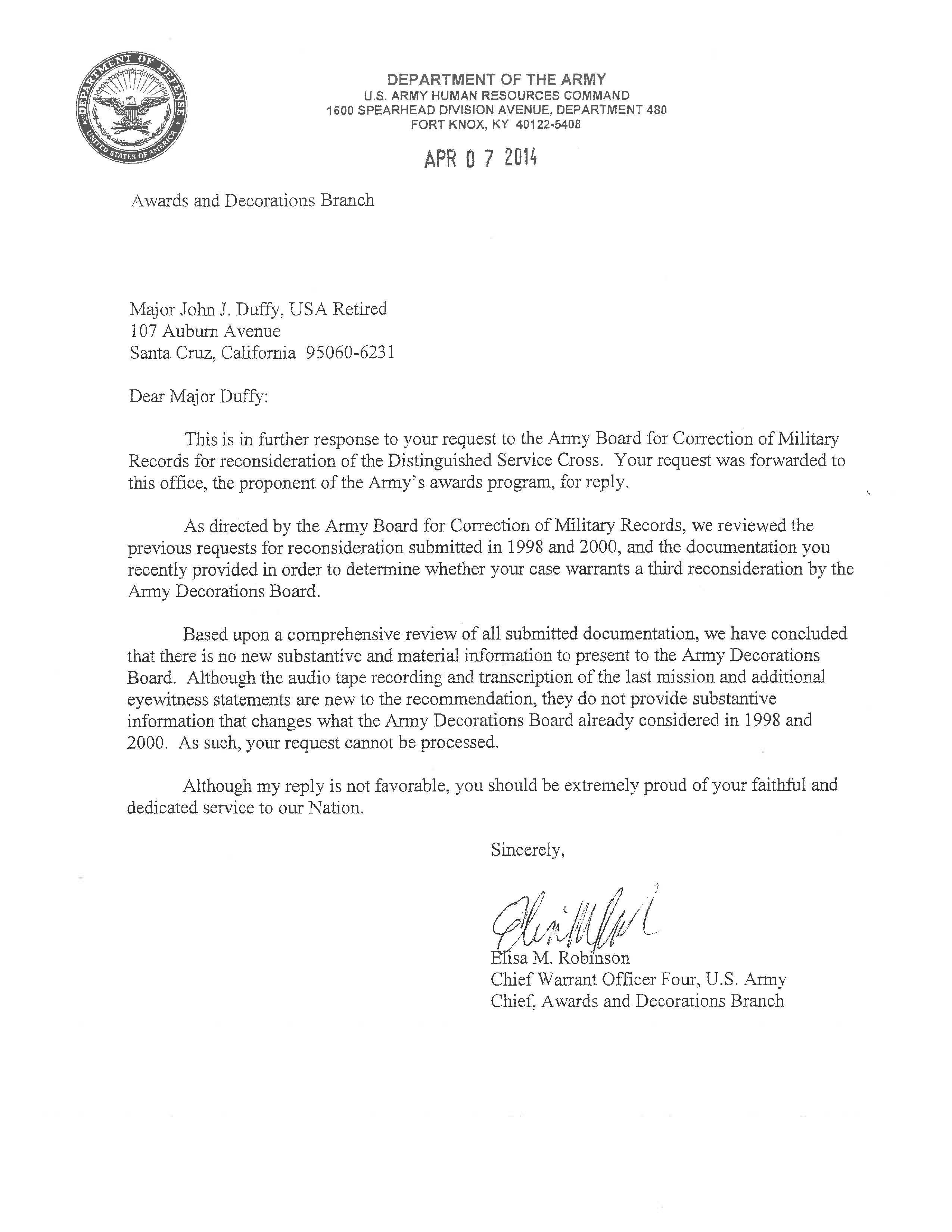
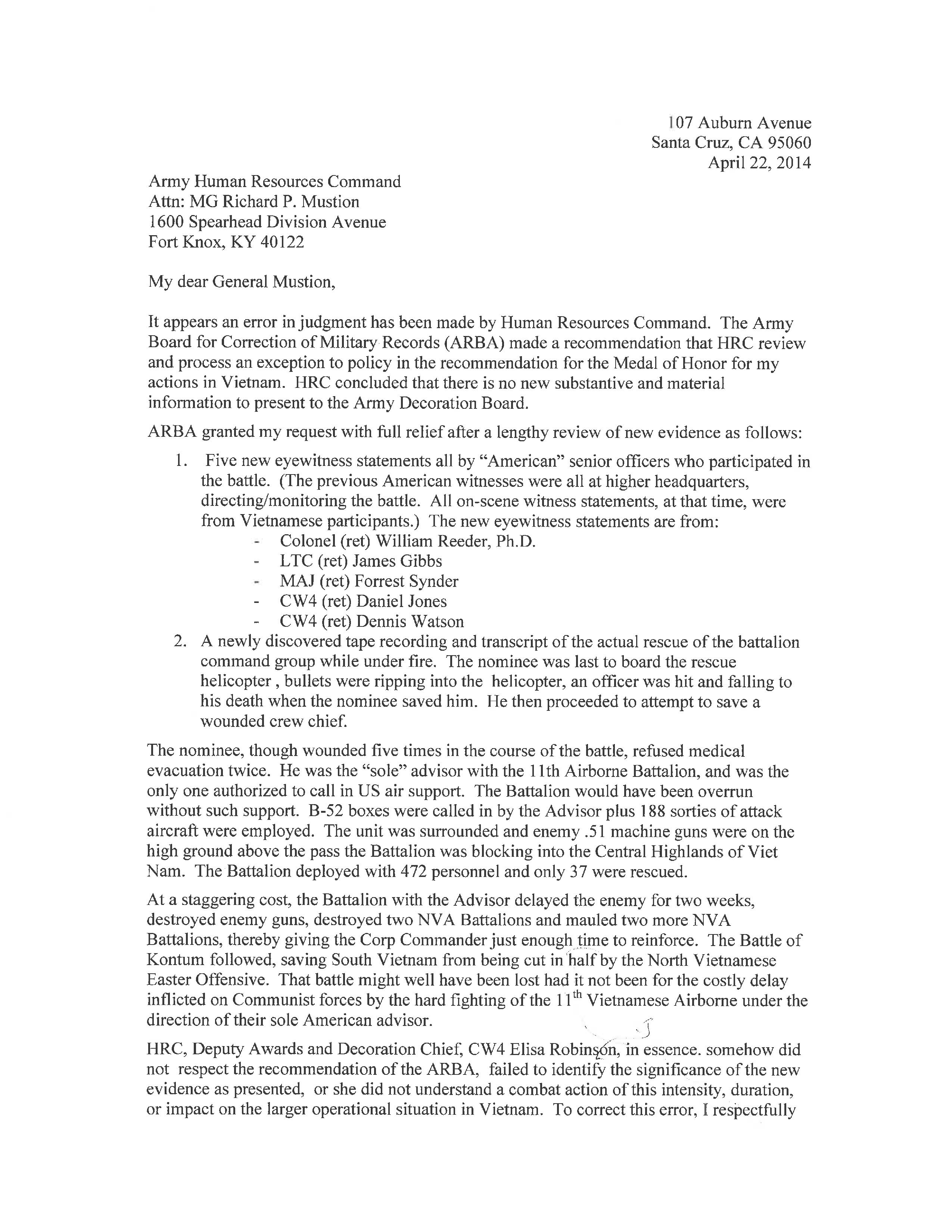
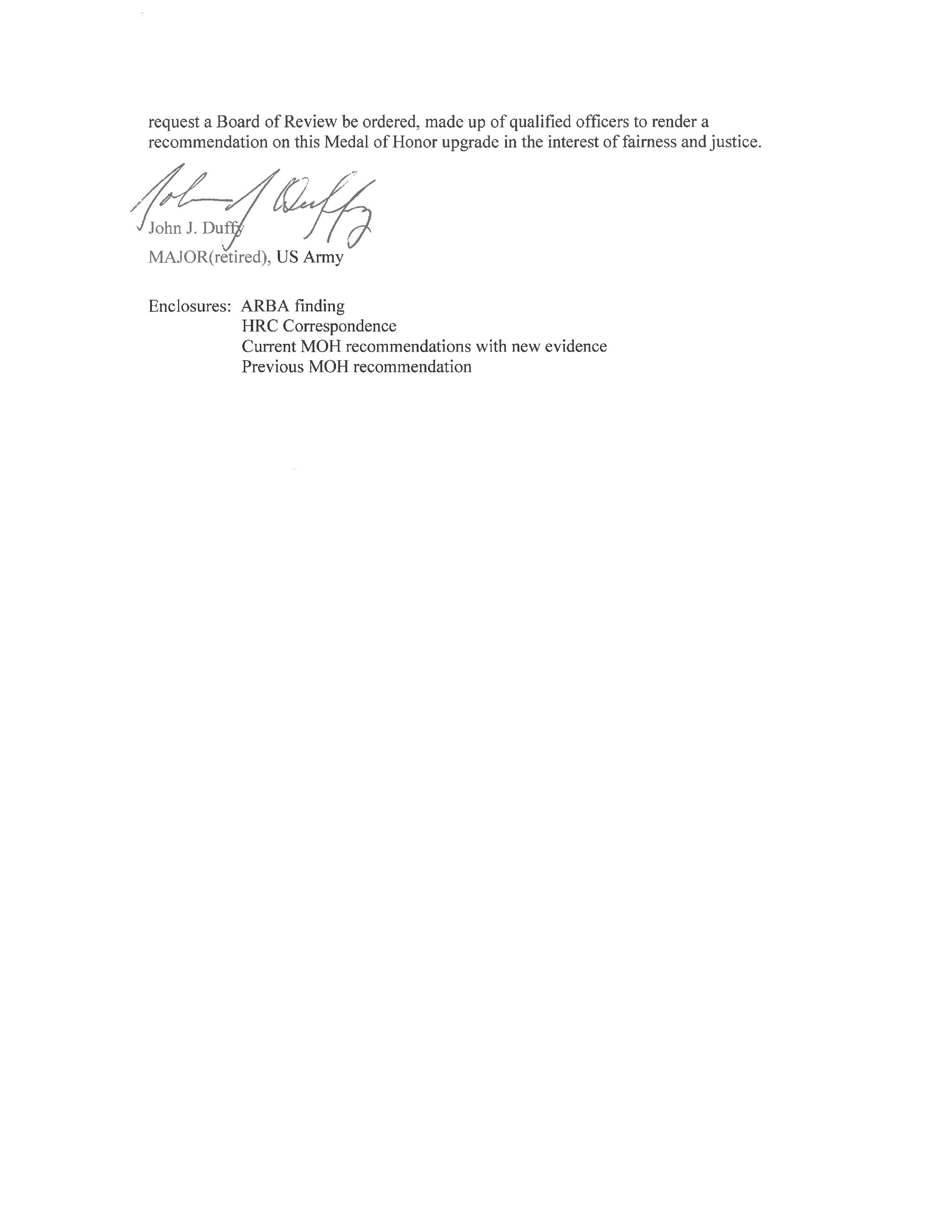
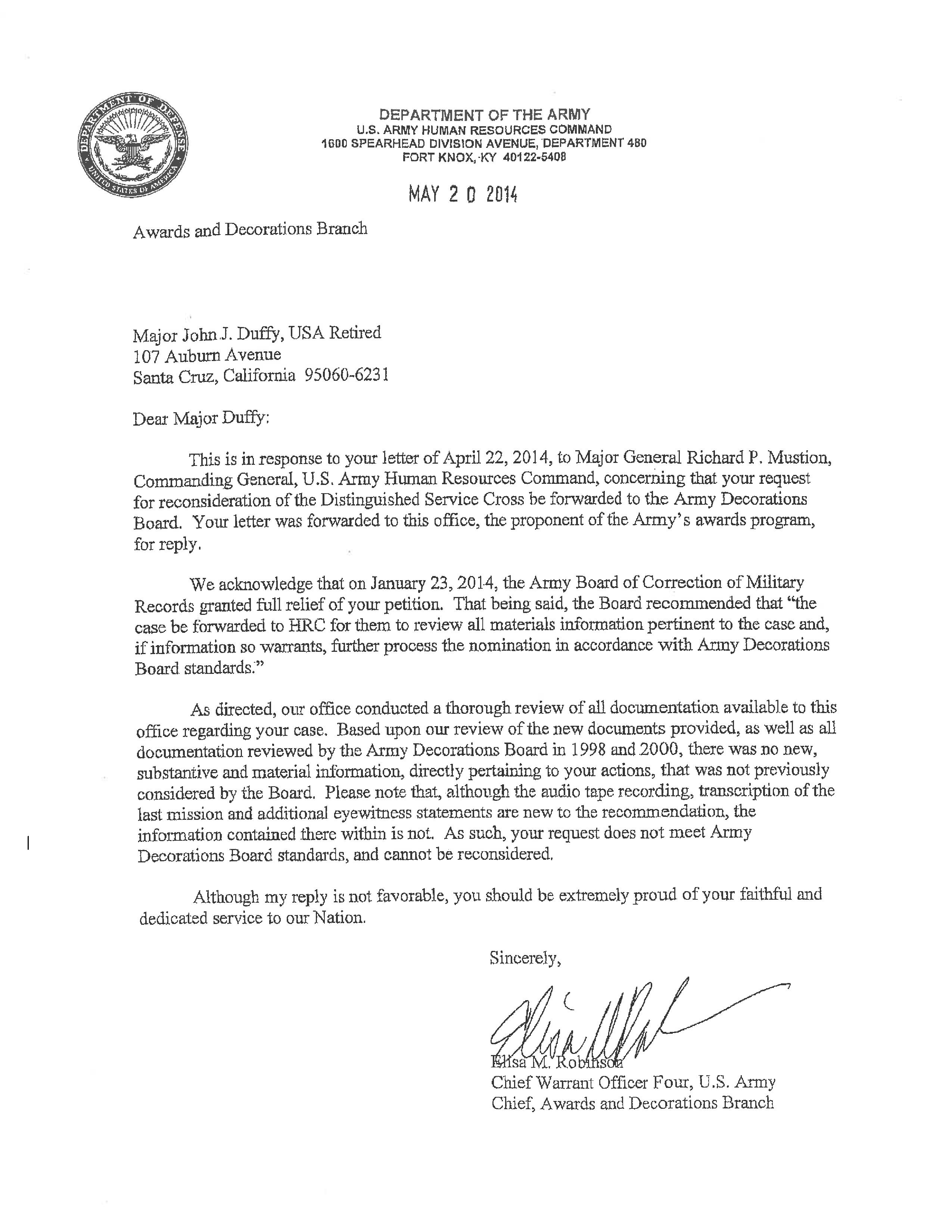


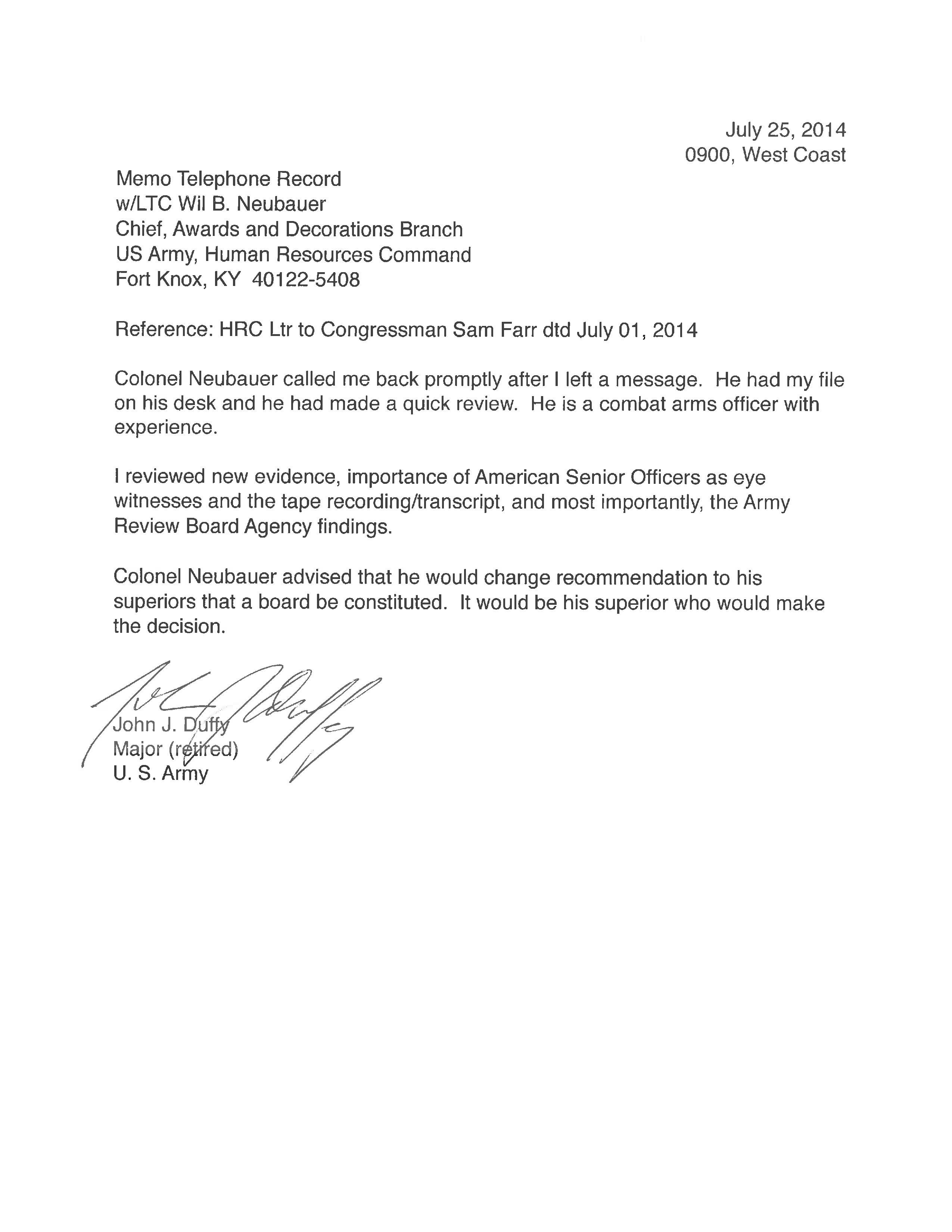

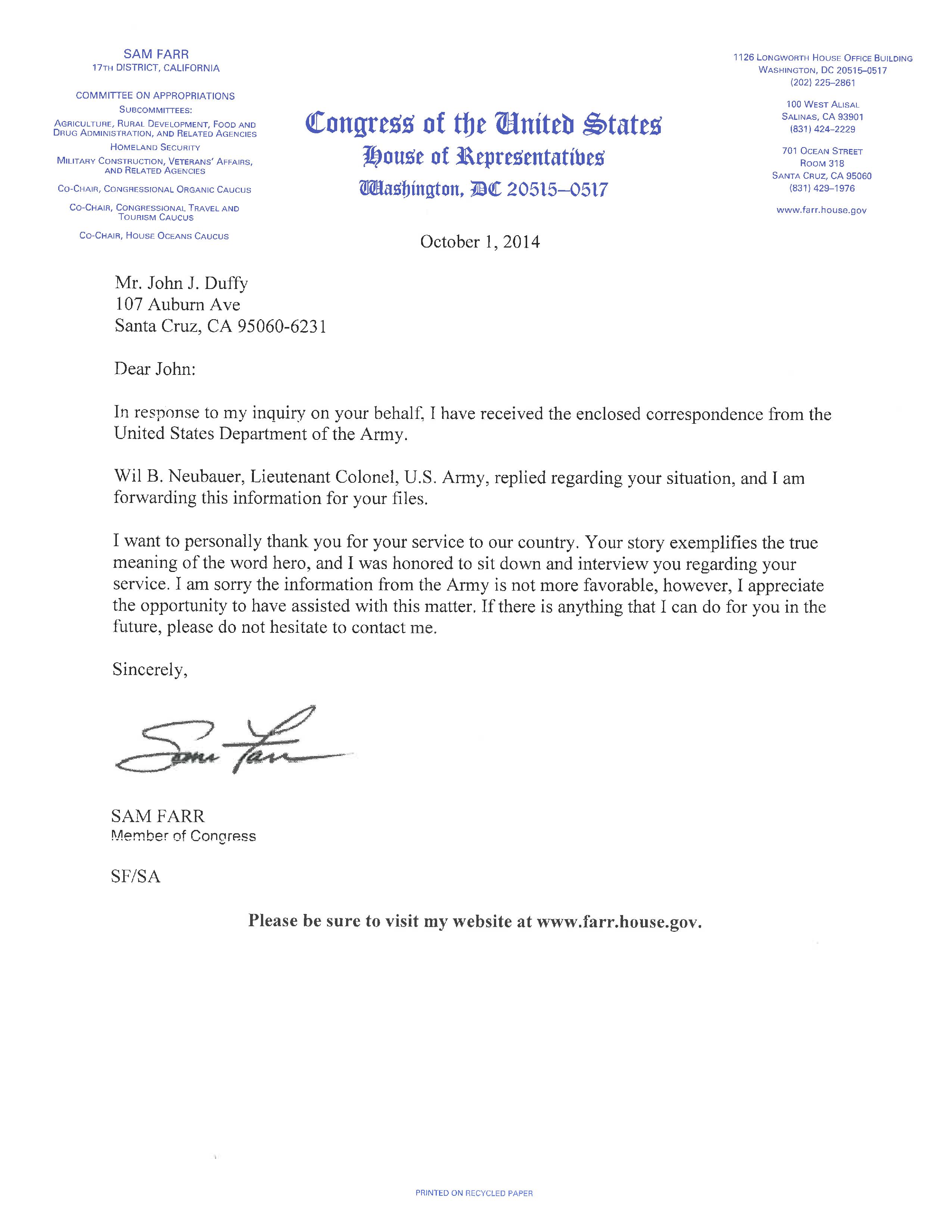
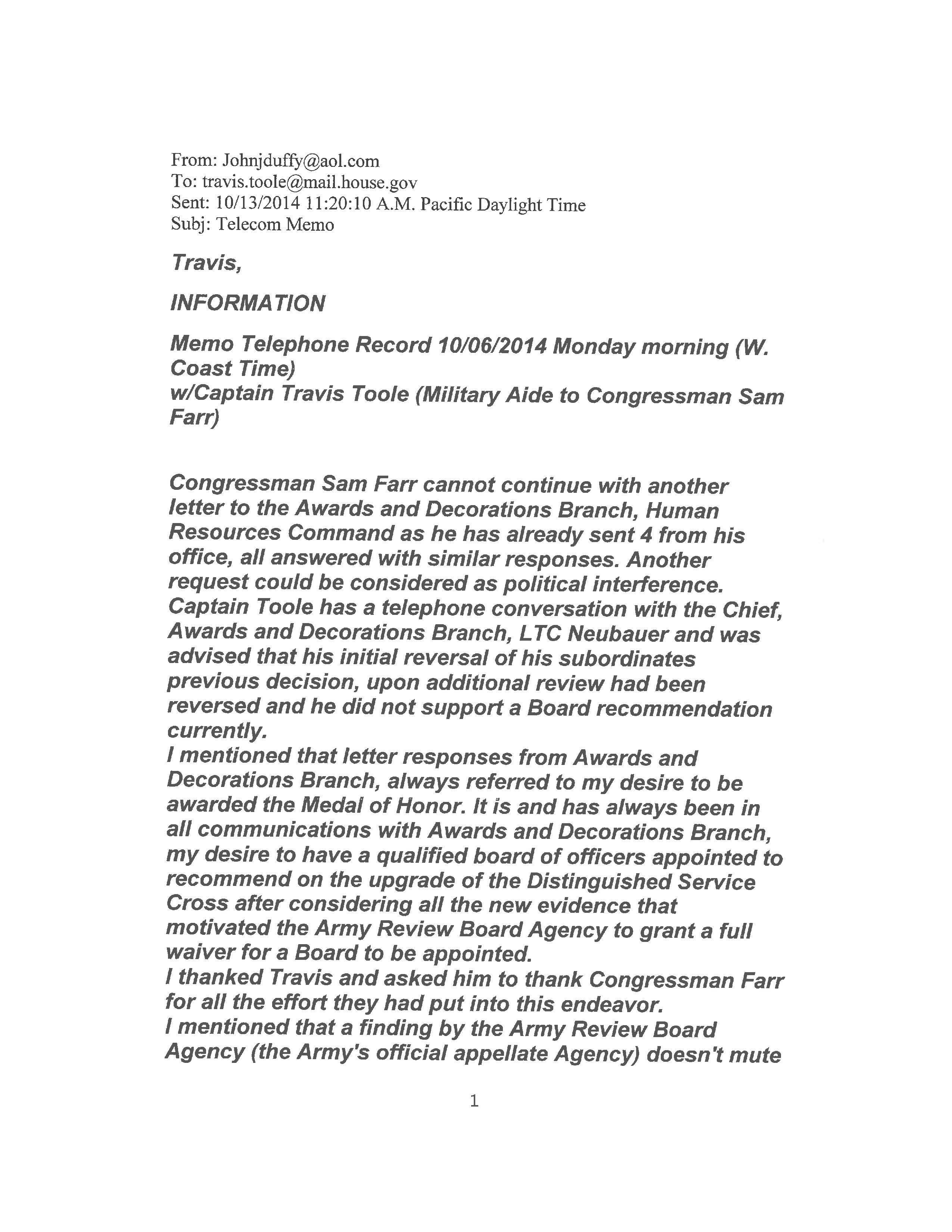
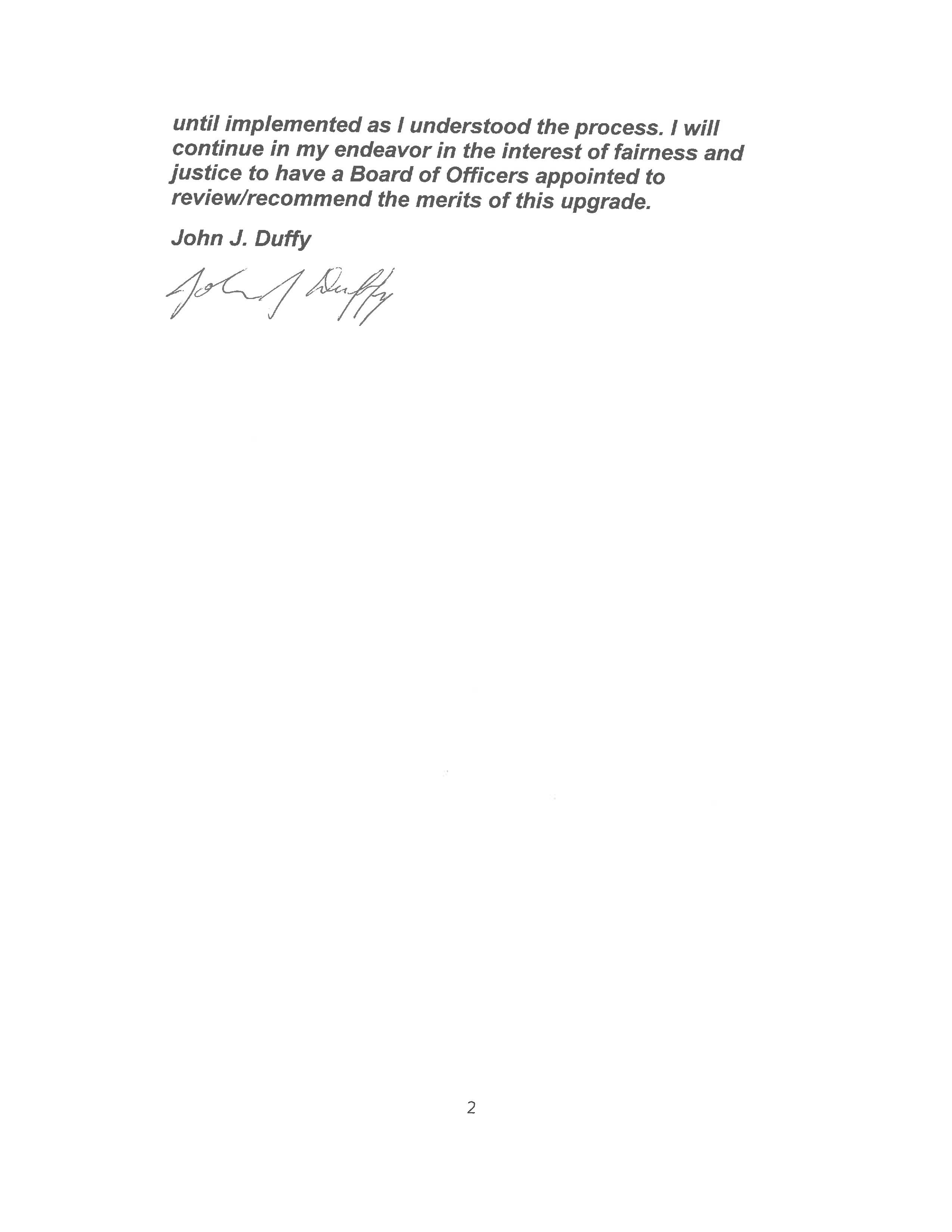
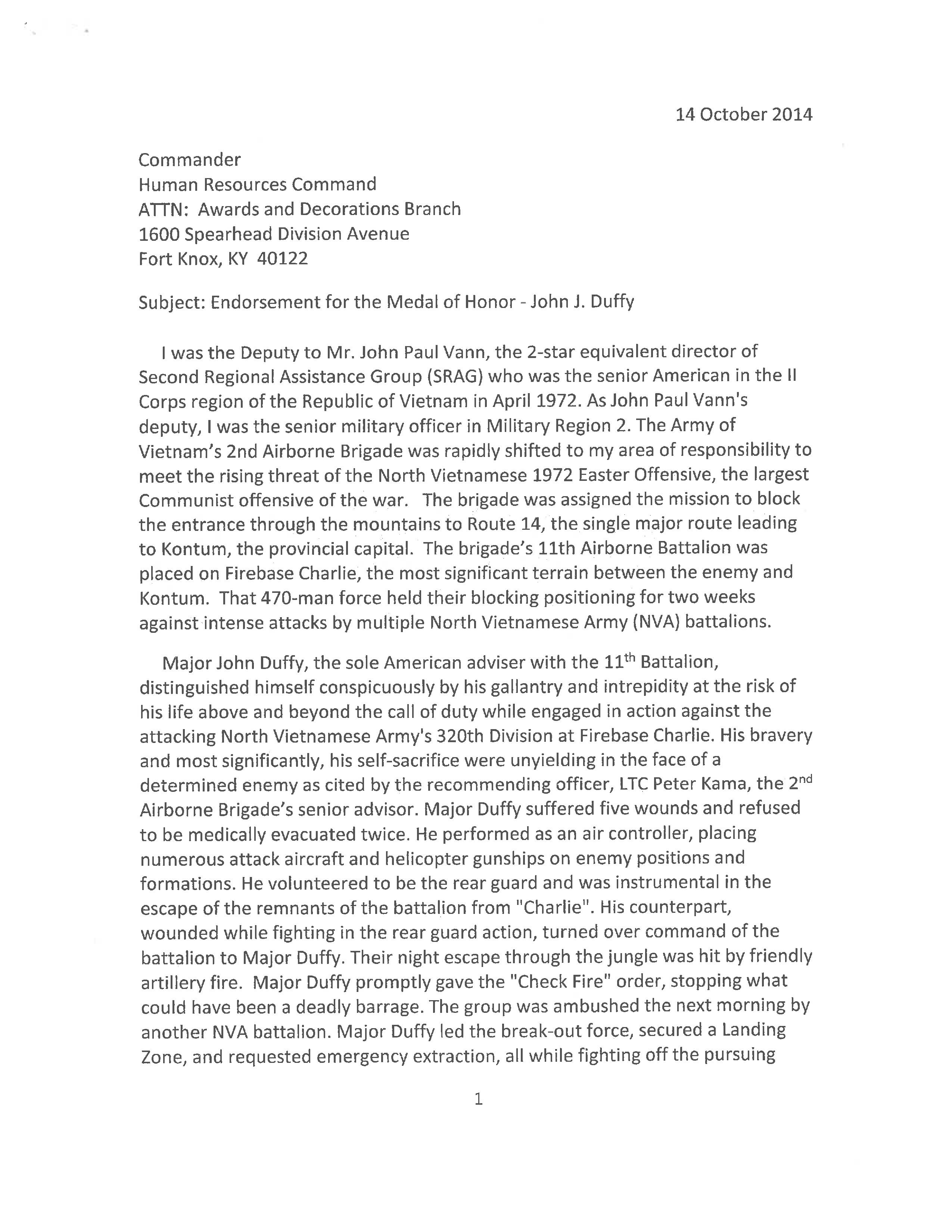
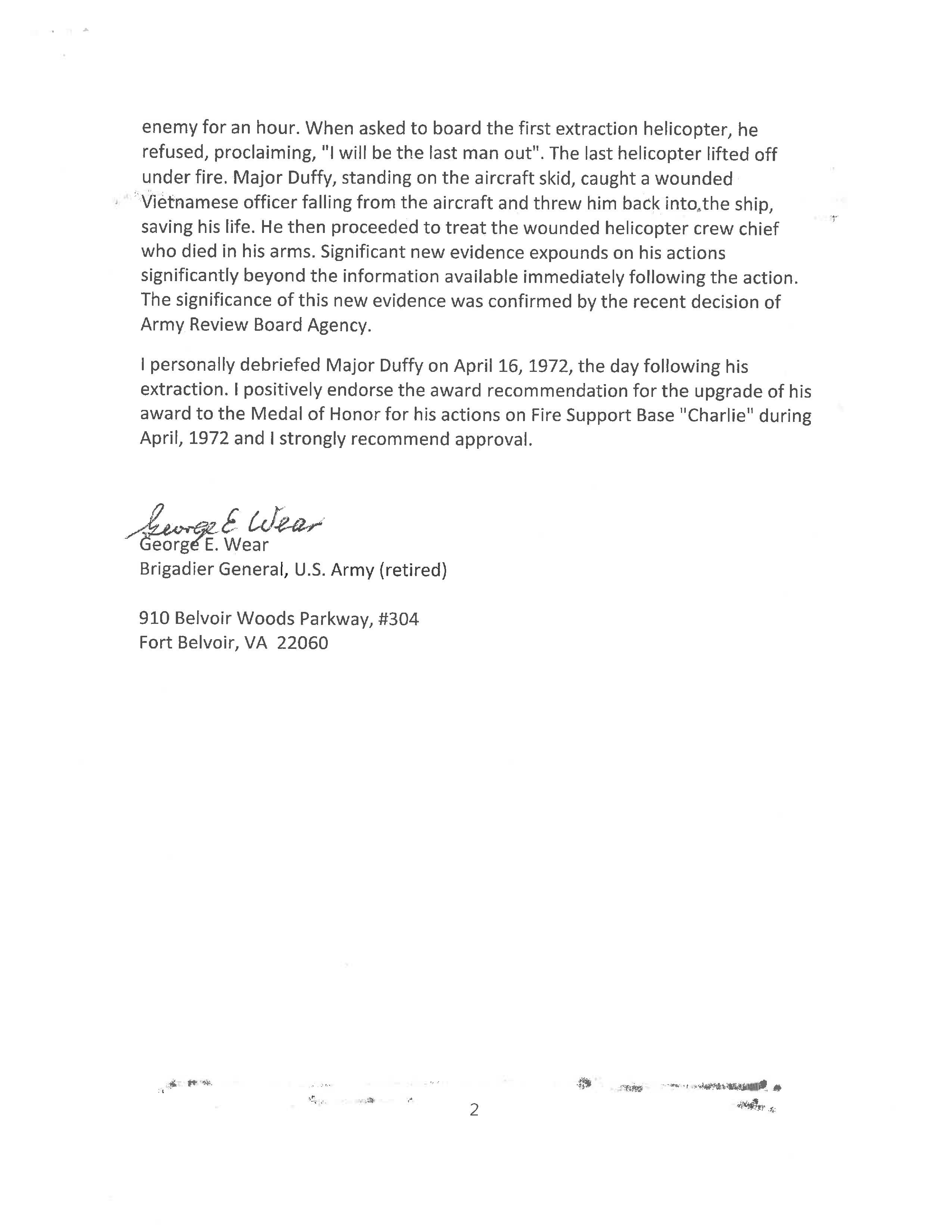
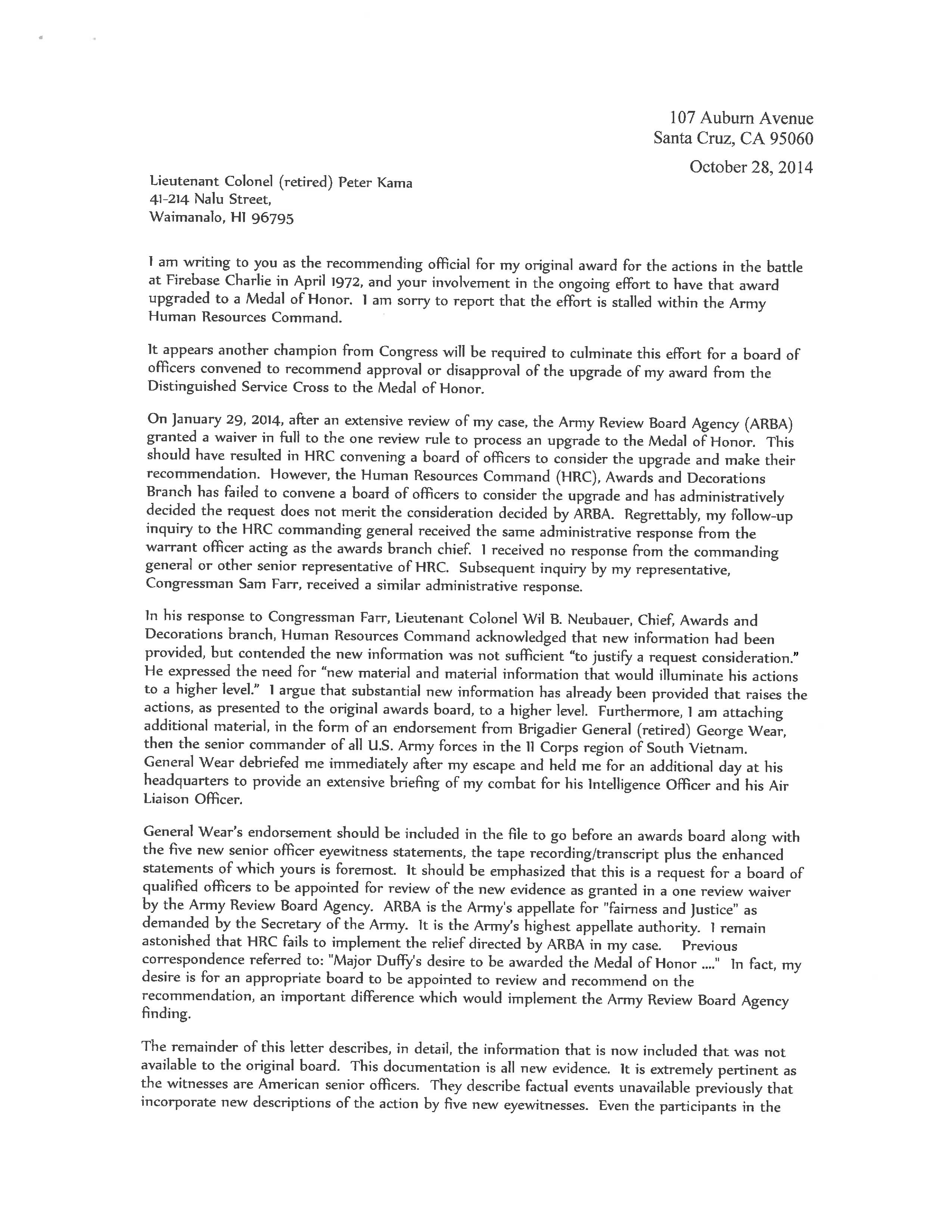
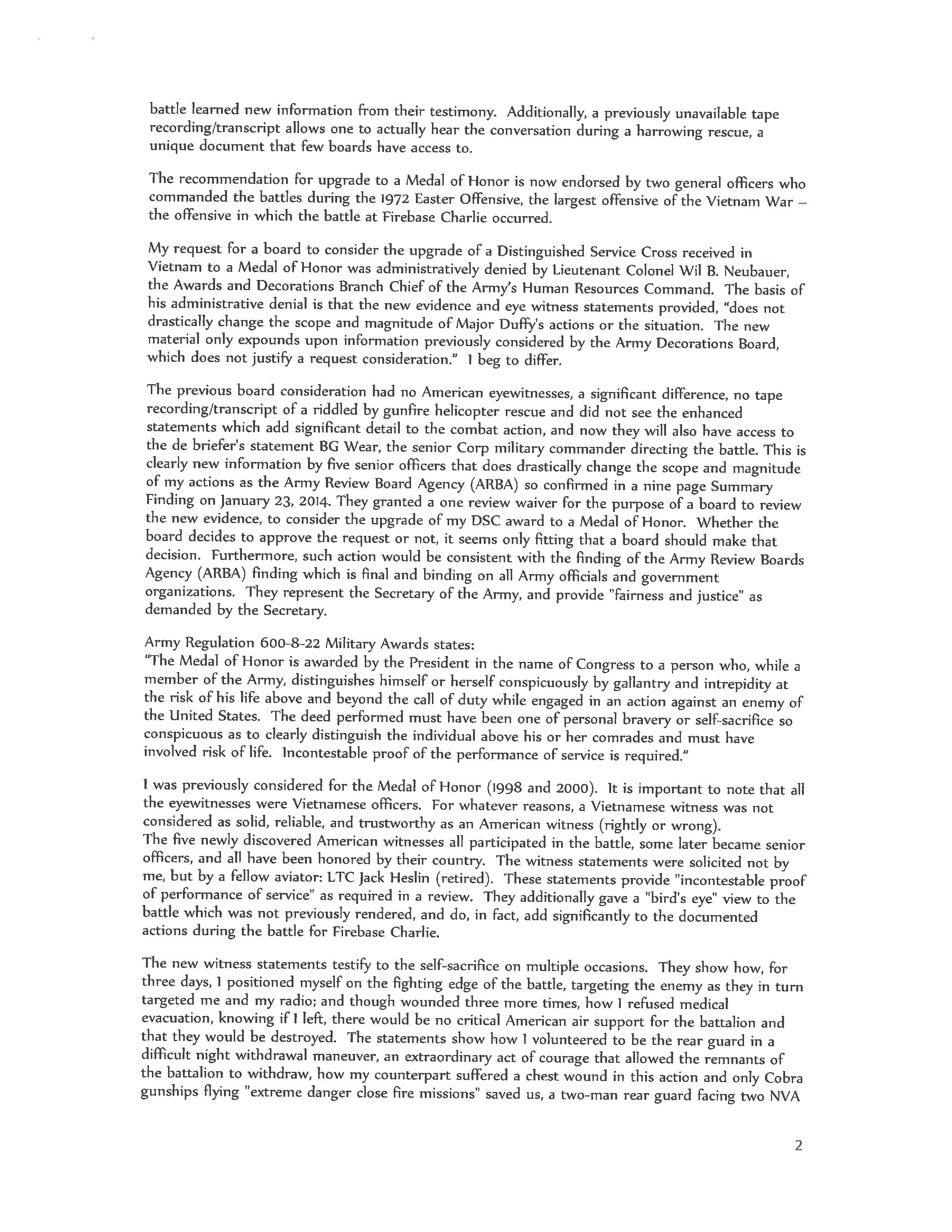
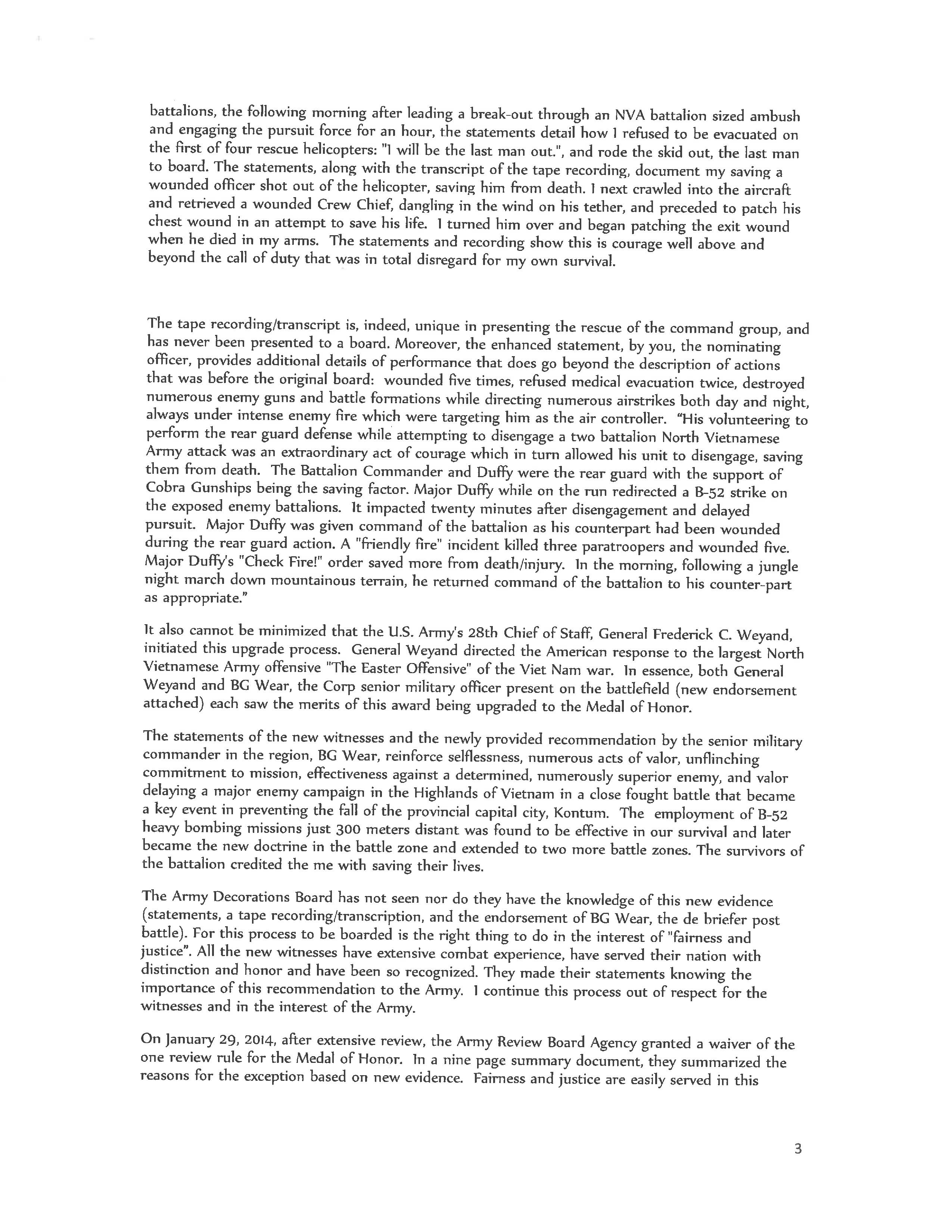
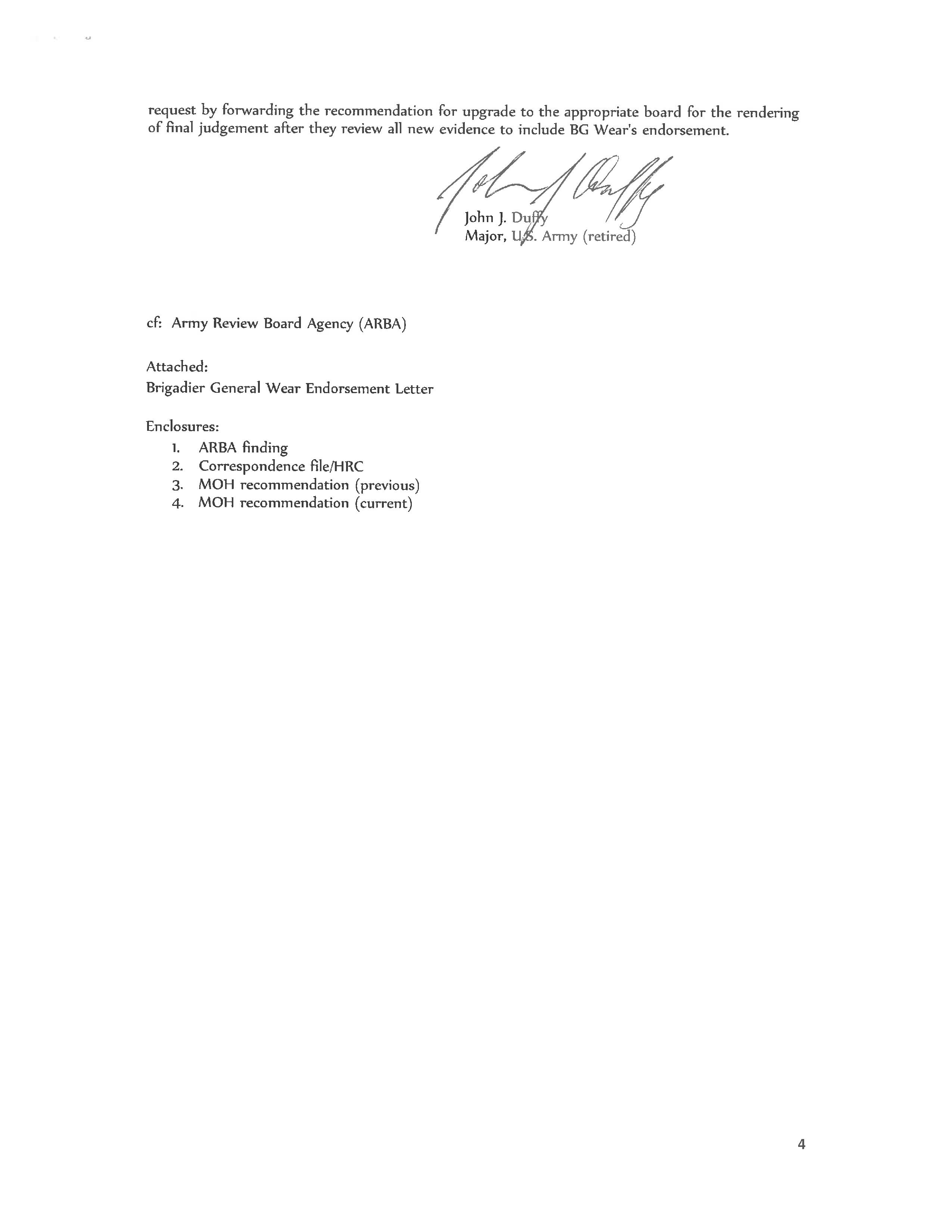
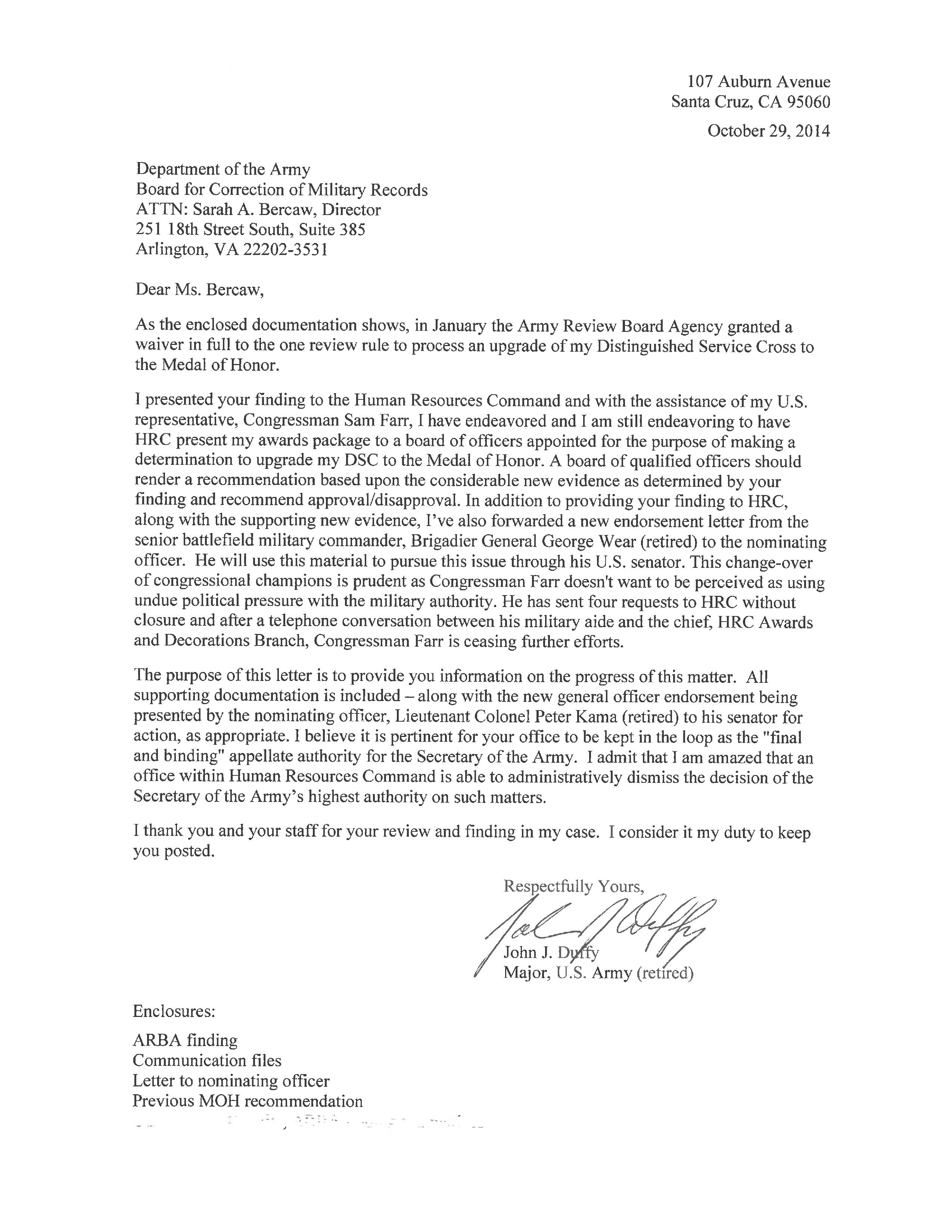
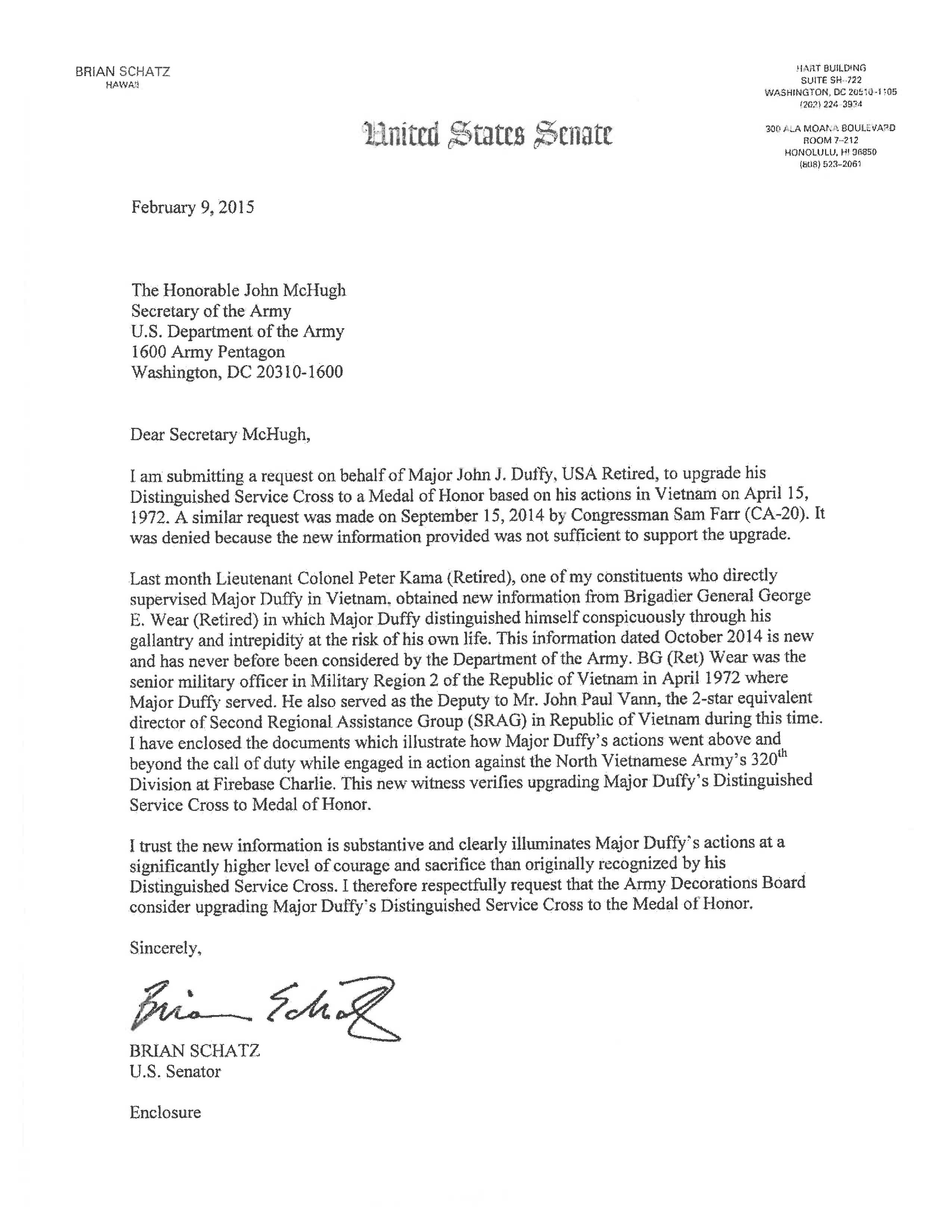
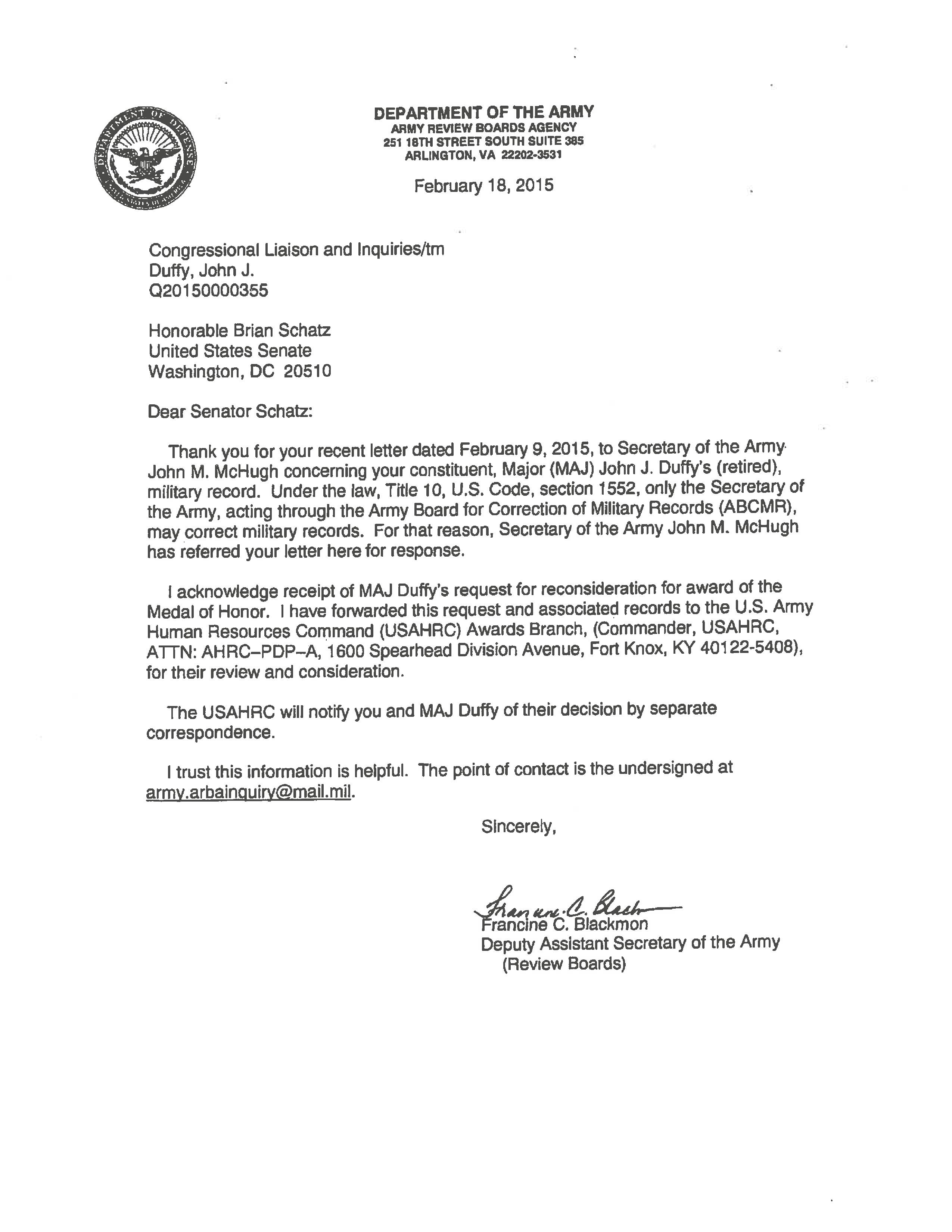


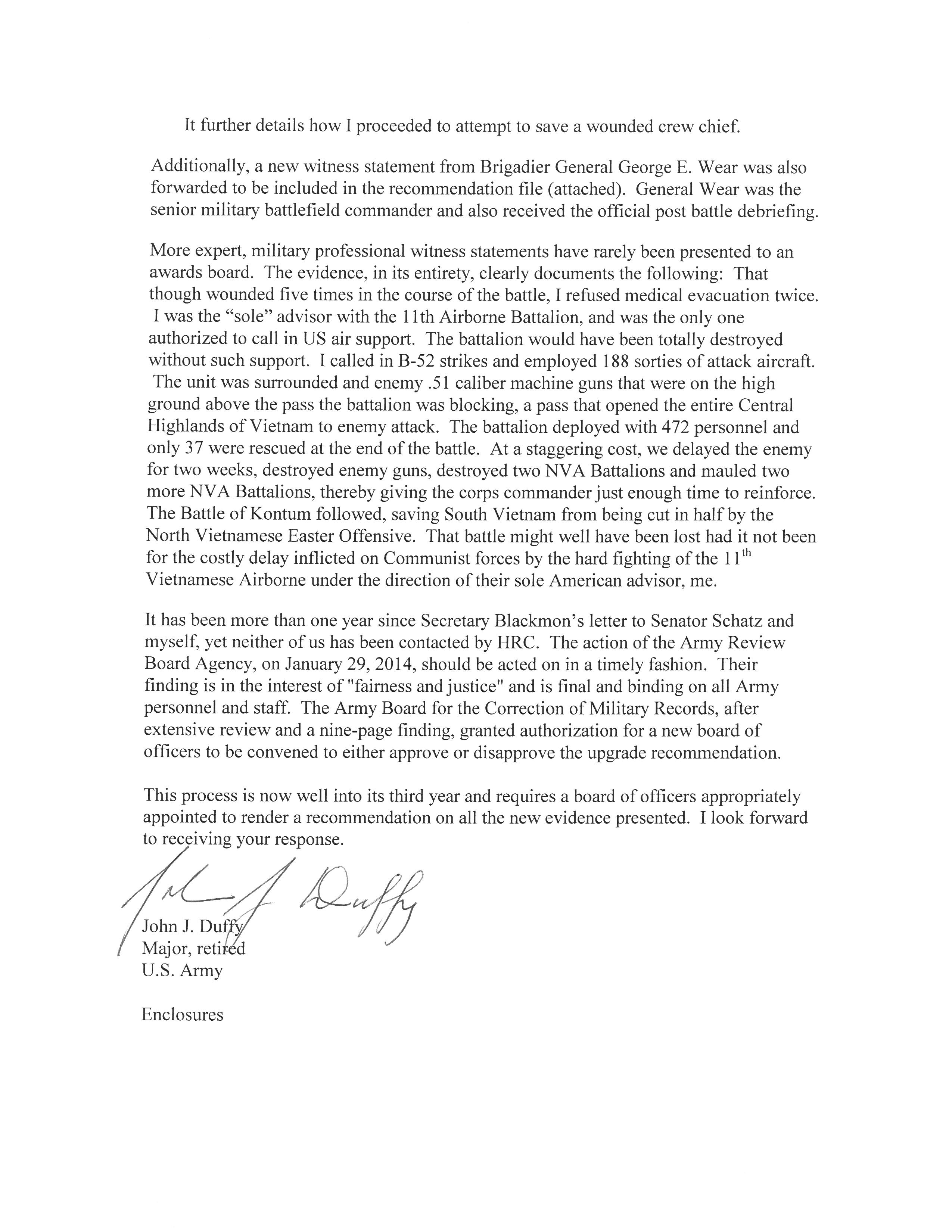


John Joseph Duffy
Major, Retired
107 Auburn Avenue
Santa Cruz, CA 95060
831-425-7004
johnduffy@aol.com
May 30, 2016
Army Human Resources Command
Attn: Awards and Decorations Branch, AHRC-PDP-A, Dept 480
1600 Spearhead Division Avenue
Fort Knox, KY 40122-5408
LTC Wil B. Neubauer
The purpose of this letter is to express my disappointment and dissatisfaction at your treatment of a highly decorated and aging Vietnam veteran by the Human Resources Command (HRC). After receiving multiple requests from Congressman Farr, Senator Schatz, and myself in addition to a Department of Army inquiry, your office has finally and very tardily responded by referencing a letter dated April 7, 2014, signed by CW4 Eliza M. Robinson. Your response failed to acknowledge the subsequent additional factual testimony of an Army general officer, failed to explain how the Human Resources Command made an arbitrary administrative determination in contradiction to the findings of the Army Review Boards Agency (ARBA) in spite of the additional evidence that they found compelling, and failed to explain the disregard over a prolonged time of the inquires made by a United States congressman and a United States Senator.
The Army Review Boards Agency made a finding that there was sufficient new evidence to warrant consideration of a recommendation for my Distinguished Service Cross to be upgraded to the Medal of Honor. This new evidence was not deemed worthy of consideration by Human Resources Command, which failed to duly appoint a board of combat experienced officers. Rather, the ARBA findings were dealt with summarily by a review by an administrative warrant officer. Furthermore, upon the submission of even additional significant new evidence by Brigadier General George E. Wear, there was no review of that new evidence or even the acknowledgement of General Wear’s statement, which had been requested by your office. That statement, by the senior military officer conducting the battle and the official debriefing officer after the “Battle for Charlie”, should now be part of the file that now needs to be reviewed by an authorized Board of Officers.
CW4 Robinson is an officer, certainly expert in administration, who was appointed to temporarily fill in for the Chief, Awards and Decorations Branch, a lieutenant colonel (LTC) position. She was neither qualified, trained, nor experienced in combat/tactics and most likely overwhelmed by the requirements of a short staff without proper guidance. This was pointed out to the Commanding General of Human Resources Command in a letter dated April 22, 2014.
You will recall that on January 29, 2014 the Army Review Boards Agency (ARBA) found in my favor, allowing the Army to convene a board of officers to consider the upgrade to the Medal of Honor based on new evidence that was not available at the time of the original award. That new evidence included:
1. Five new eyewitness statements all by American senior officers who participated in the battle. (The previous American witnesses were all at higher headquarters, directing/monitoring the battle. All on-scene witness statements, at that time, were from Vietnamese participants.) The new eyewitness statements are from:
- Colonel (ret) William Reeder, Ph.D.
- LTC (ret) James Gibbs
- MAJ (ret) Forrest Synder
- CW4 (ret) Daniel Jones
- CW4 (ret) Dennis Watson
2. A newly discovered tape recording and transcript of the actual rescue of the battalion command group while under fire. This newly discovered evidence showed that I was last to board the rescue helicopter and as bullets were ripping into the helicopter, an officer was hit and falling to his death when I saved him. It further details how I proceeded to attempt to save a wounded crew chief.
Additionally, a new witness statement from Brigadier General George E. Wear was also forwarded to be included in the recommendation file (attached). General Wear was the senior military battlefield commander and also received the official post-battle debriefing.
More expert, military professional witness statements have rarely been presented to an awards board. The evidence, in its entirety, clearly documents the following: That though wounded five times in the course of the battle, I refused medical evacuation twice. I was the “sole” advisor with the 11th Airborne Battalion, and was the only one authorized to call in US air support. The battalion would have been totally destroyed without such support. I called in B-52 strikes and employed 188 sorties of attack aircraft. The unit was surrounded and enemy .51 caliber machine guns that were on the high ground above the pass the battalion was blocking, a pass that opened the entire Central Highlands of Vietnam to enemy attack. The battalion deployed with 472 personnel and only 37 were rescued at the end of the battle. At a staggering cost, we delayed the enemy for two weeks, destroyed enemy guns, destroyed two NVA Battalions and mauled two more NVA Battalions, thereby giving the corps commander just enough time to reinforce. The Battle of Kontum followed, saving South Vietnam from being cut in half by the North Vietnamese Easter Offensive. That battle might well have been lost had it not been for the costly delay inflicted on Communist forces by the hard fighting of the 11th Vietnamese Airborne under the direction of their sole American advisor, me.
LTC (retired) Peter Kama expanded his statement to add further detail on the tactical situation and focus on my contribution to the battlefield as singled out by the senior general officer commanding the theatre, General Frederick Weyand. I utilized close-in B-52 (Arc-Light) strikes at 300 meters. This required special emergency authorization because the existing safety zone was 500 meters. The effectiveness was devastating on the enemy. Because of the experience in supporting me in the battle for Firebase Charlie, henceforth this new reduced safety zone was used with extreme effectiveness, disrupting the enemy in all three battle zones, Quang Tri, An Loc and Kontum. The enemy tactics directed hugging the enemy at 300 meters to avoid B-52 strikes. All three fronts were hard fought over extended periods while the American forces were in process of withdrawing from Viet Nam. 150,000 North Vietnamese Army (NVA) forces were used in the attacks of this 1972 Easter Offensive. More than half of them were killed, 90% of NVA tanks were destroyed plus anti-aircraft guns, and both long-range and short-range artillery pieces. U.S air support, both Army and Air Force was critical to success on the battlefield and it was controlled for the most part by American Advisors on the ground assisting our Vietnamese allies.
BG Wear’s debriefing of me after the battle focused on the employment of B-52’s in the battle. He held me over another day to debrief his Air Liaison Officer and his Corps Intelligence Officer. It is important that your office acknowledge receipt of his statement and inclusion in the file for Board review.
HRC Awards and Decorations Branch is required to process and review this recommendation for an upgrade of the Distinguished Service Cross to the Medal of Honor by a qualified senior officer. You, LTC Wilbauer, are a qualified combat arms officer with combat experience. In your initial 10-minute review on July 1, 2014, you advised me that you would recommend approval to convene a qualified board to review the recommendation based on evidence in the file. That never happened. In a follow- up telephone conversation requesting status of the recommendation, you advised, without explanation that, “I changed my mind“ and reversed your decision. You then dispatched a letter to me, requesting additional information which was sent to your office (BG Wear’s statement).
New evidence also testifies to my refusal to be med-evacuated twice (although seriously wounded and suffering from a concussion) as leaving my post would have proved fatal to the battalion. American air support was essential to survival and only an American could authorize and direct such strikes (188 sorties authorized and directed by me, plus B-52 Arc-Lights).
I destroyed numerous enemy artillery, mortar, and anti-aircraft guns, plus the 1250 enemy soldiers killed as confirmed in the official reports of the battle.
The Vietnamese airborne battalion I was advising was declared “combat ineffective”, without water, food, medical supplies and ammunition and ordered to “Break-out”. I volunteered to be the “rear guard” during this most critical and dangerous disengagement.
The new battalion commander (the previous had been killed in the battle the day before) volunteered to join me as a two man “rear guard”. He understood that we needed to block the enemy pursuit as long as we could. We both understood that our survival was doubtful. This two-man “rear guard” held off the enemy for 20 minutes. We were within a minute of being overrun and killed by the enemy when saved by two attack helicopters in a targeting engagement that broke the enemy attack within ten meters of us, the “rear guard”. Both members of the rear guard were wounded while holding the enemy at bay.
On the run, after disengaging, I ordered a B-52 strike on the enemy battalions that had just overrun “Charlie”. The bombs struck the enemy 20 minutes later, delaying their pursuit.
Upon rejoining the battalion, as the new battalion commander was suffering from a “sucking chest wound” received during the rear guard action, the battalion command was given to me.
I ordered a night march link-up with a subordinate unit and advised brigade of our night withdrawal. During the night march, friendly fire hit the unit inflicting 5 KIA and 3 WIA, I ordered the “Check Fire!” before more friendly troopers were killed.
The following morning, after returning command to my Vietnamese commander, the remnants of the battalion were ambushed by an enemy battalion. The unit fragmented. I led the command group plus all that could be gathered, through the ambush, located a Landing Zone, redistributed ammunition as available, set up a defensive perimeter, had the surgeon treat the wounded and declared an emergency. I requested a four-ship lift package for 37 survivors and support attack aircraft to fight the enemy pursuit force. I engaged the enemy for over an hour with A1-E and Cobra gunship support taking out two enemy machine gun positions plus numerous enemy soldiers.
The lift package upon approach requested that I board first as Americans had priority. (This is detailed in the new evidence provided in the form of a tape recording and transcript of the conversations among the crew in the helicopter. This new evidence was provided to HRC.) I refused and advised: “I will be the last man out.” Under fire, three lifts picked up survivors and lifted off. The last lift ship came in and was heavily engaged. It did a fly round and came back in at lower level, but was still riddled with raking fire that hit the helicopter eleven times. As we boarded the aircraft and lifted off, another round hit an officer and he fell from the aircraft. I was still on the strut and I caught the falling Vietnamese officer by his web gear and threw him back in the aircraft.
This recommendation for an upgrade of a Distinguished Service Cross to the Medal of Honor, after a Finding by the Army Review Boards Agency and with more “new” evidence by senior officers than has ever been presented to any board, needs to be properly reviewed by a qualified senior officer, boarded, and recommended for upgrade or denied based on the evidence that has been assembled. There can be no other appropriate action than to put this in the hands of a duly appointed board of officers to determine a recommendation of approval or disapproval. Now forty-four years after the battle, with the last three years stuck in “bureaucratic limbo” in spite of a positive finding by ARBA, the ultimate authority in the Army, it is time to convene a qualified Board to render a recommendation in order to realize “fairness and justice” as mandated by the Army and bring this matter to a close.
DUTY HONOR COUNTRY
signature: John J Duffy
John J. Duffy
Major, US Army (Retired)
Copies furnished
Secretary of the Army
Chief of Staff, US Army
CG, HRC
Senator Brian Schatz
Congressman Sam Farr
Army Times
Washington Post
New York Times



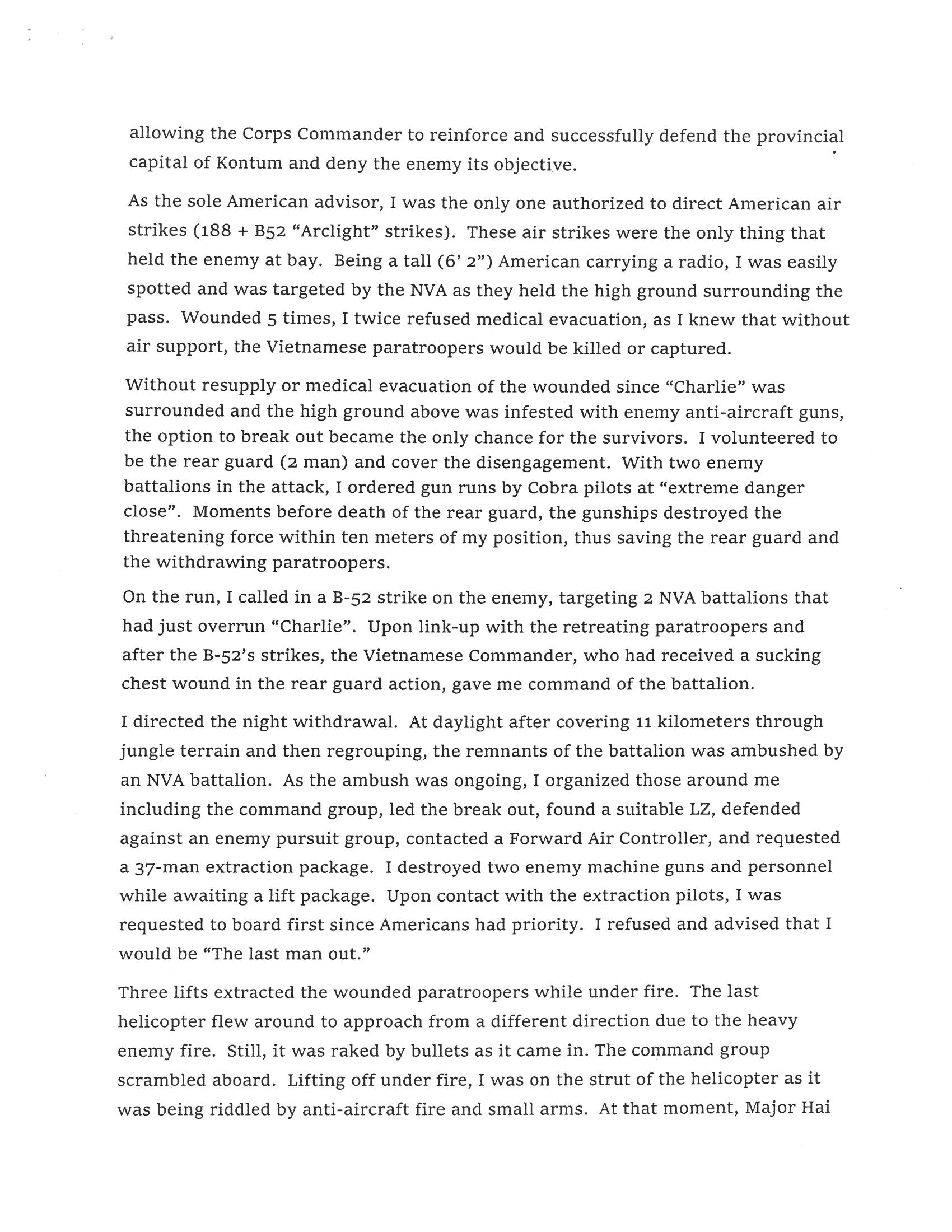
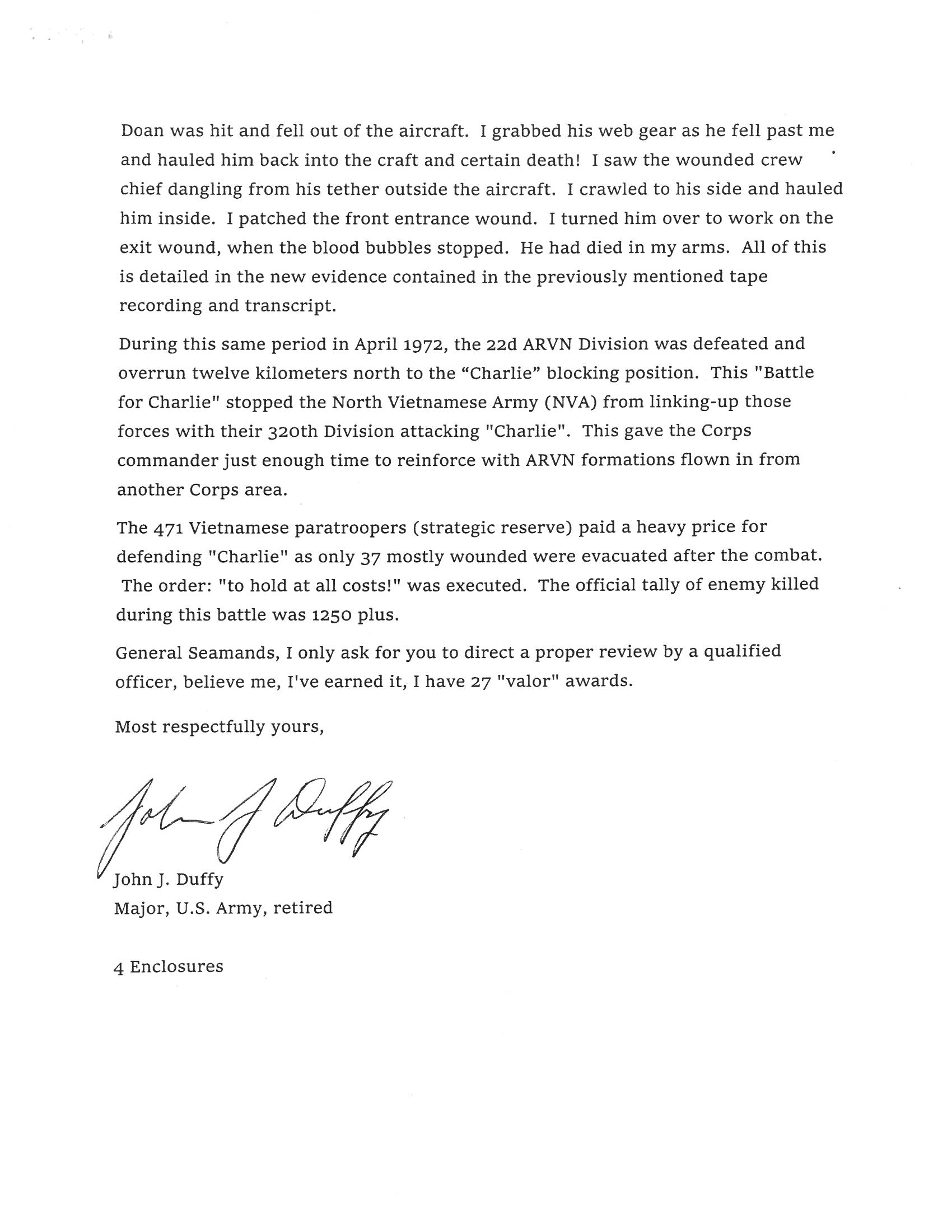
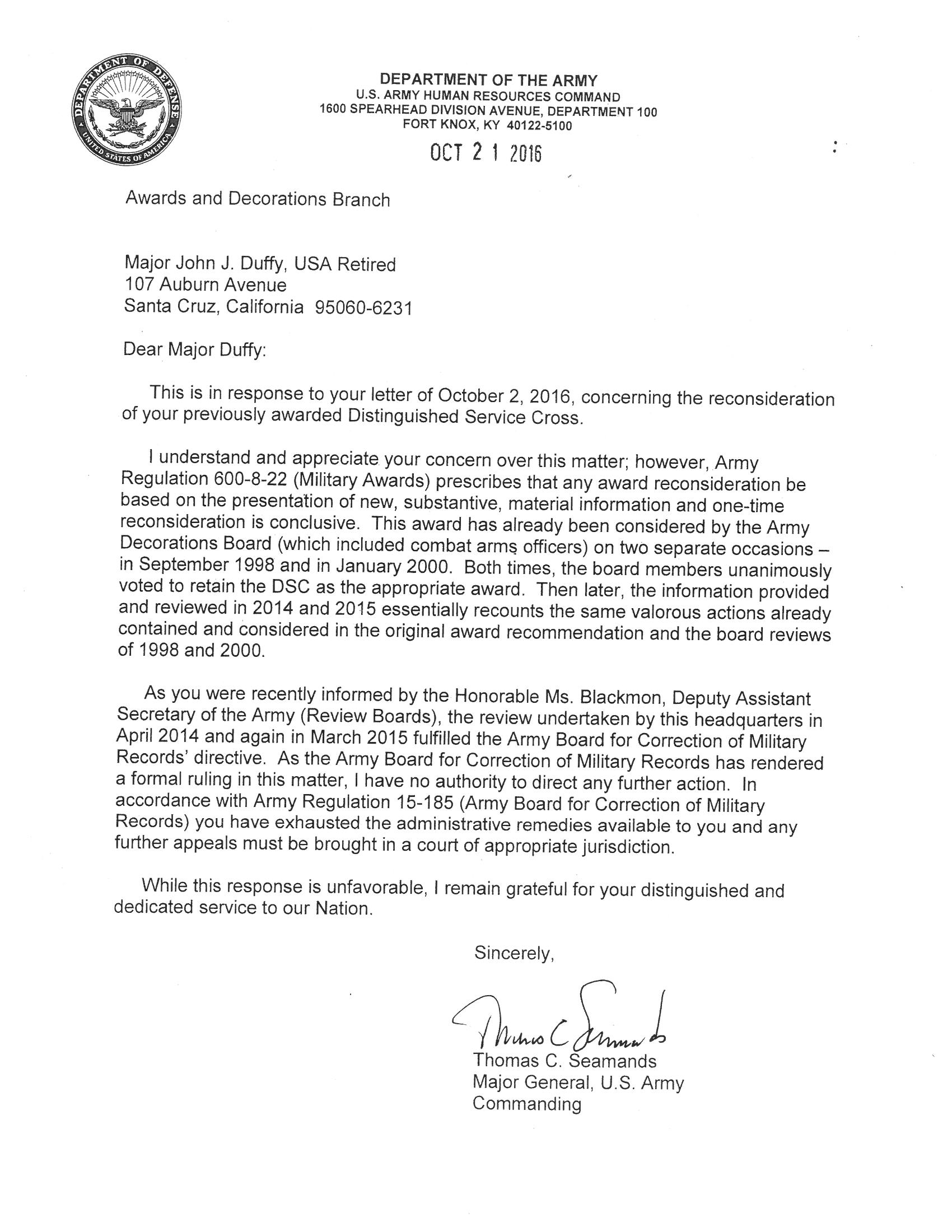
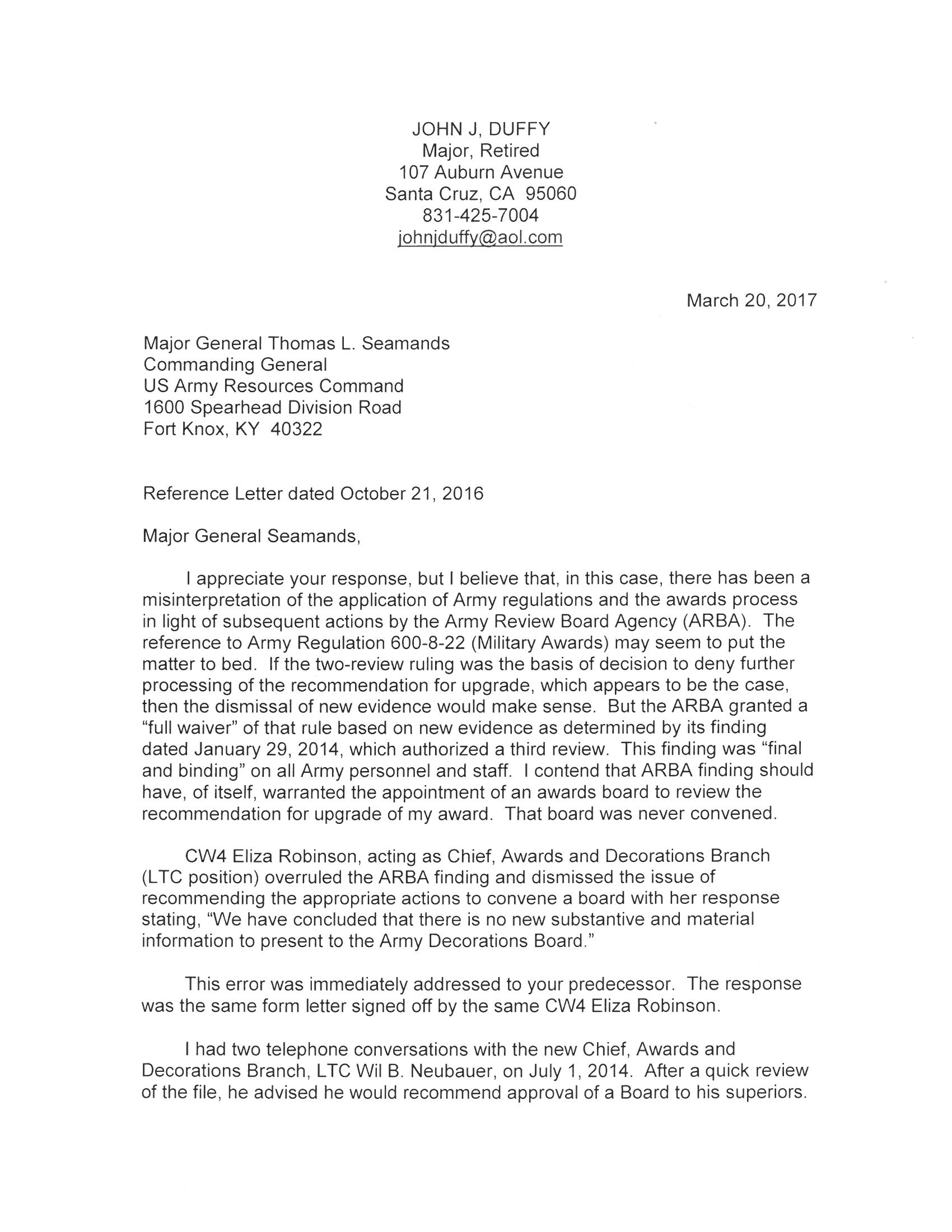
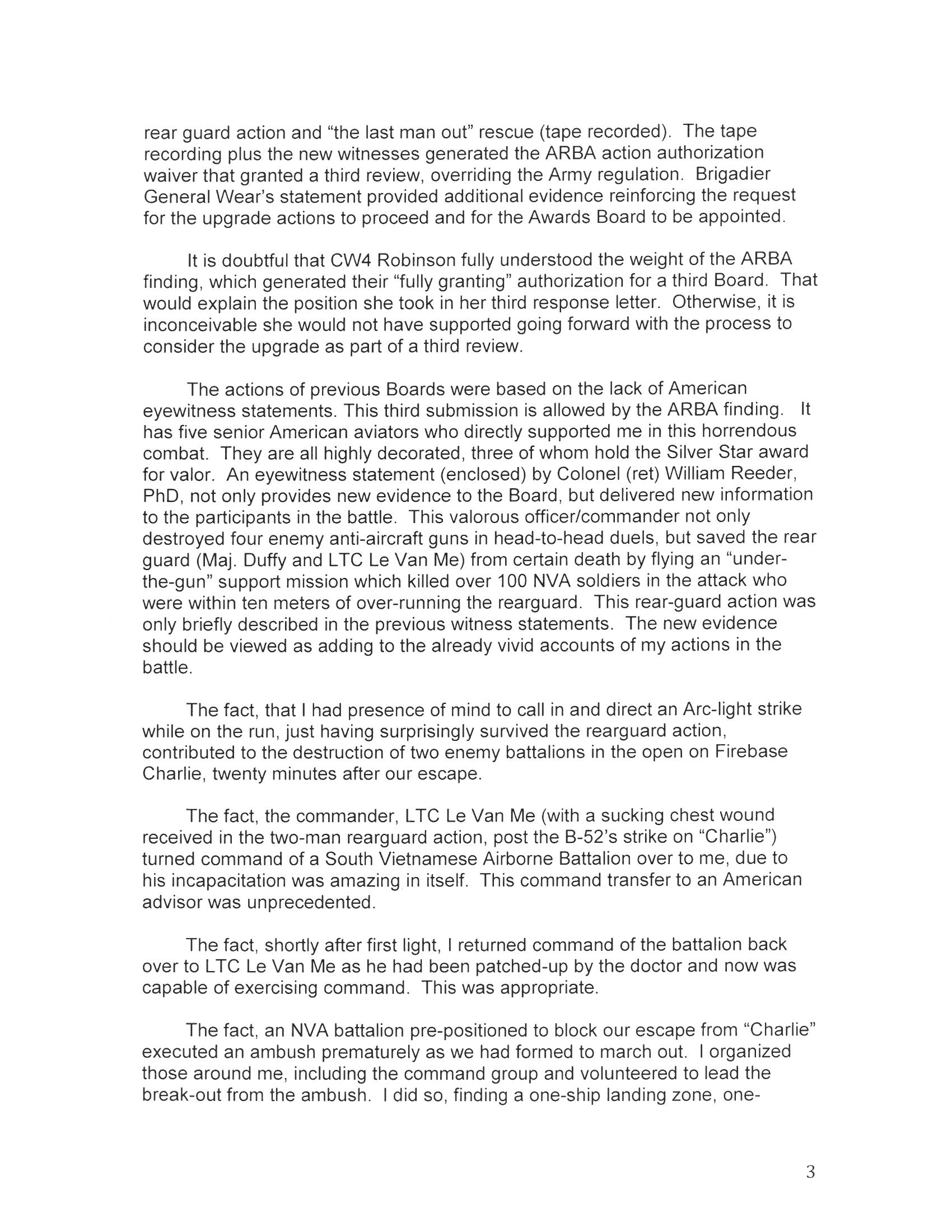

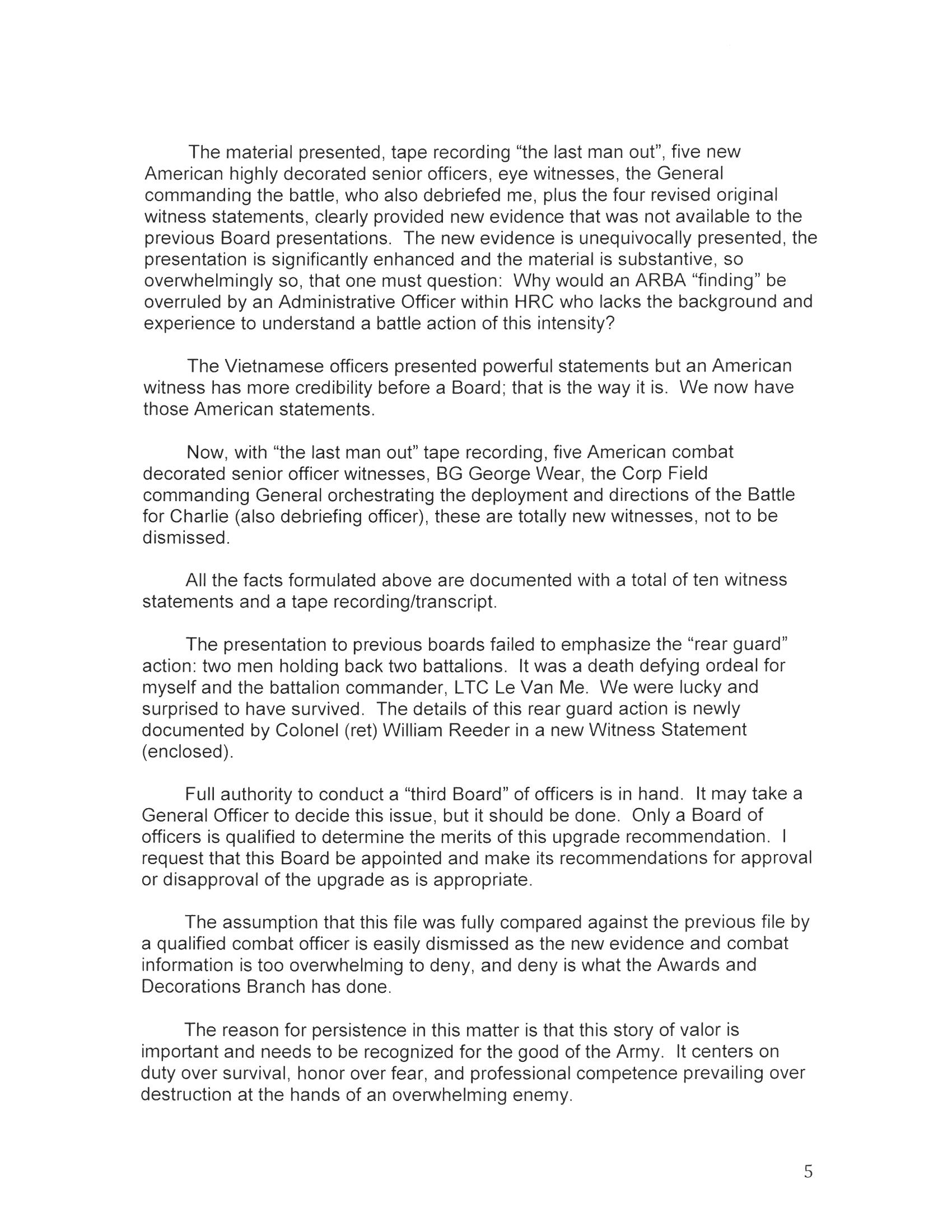
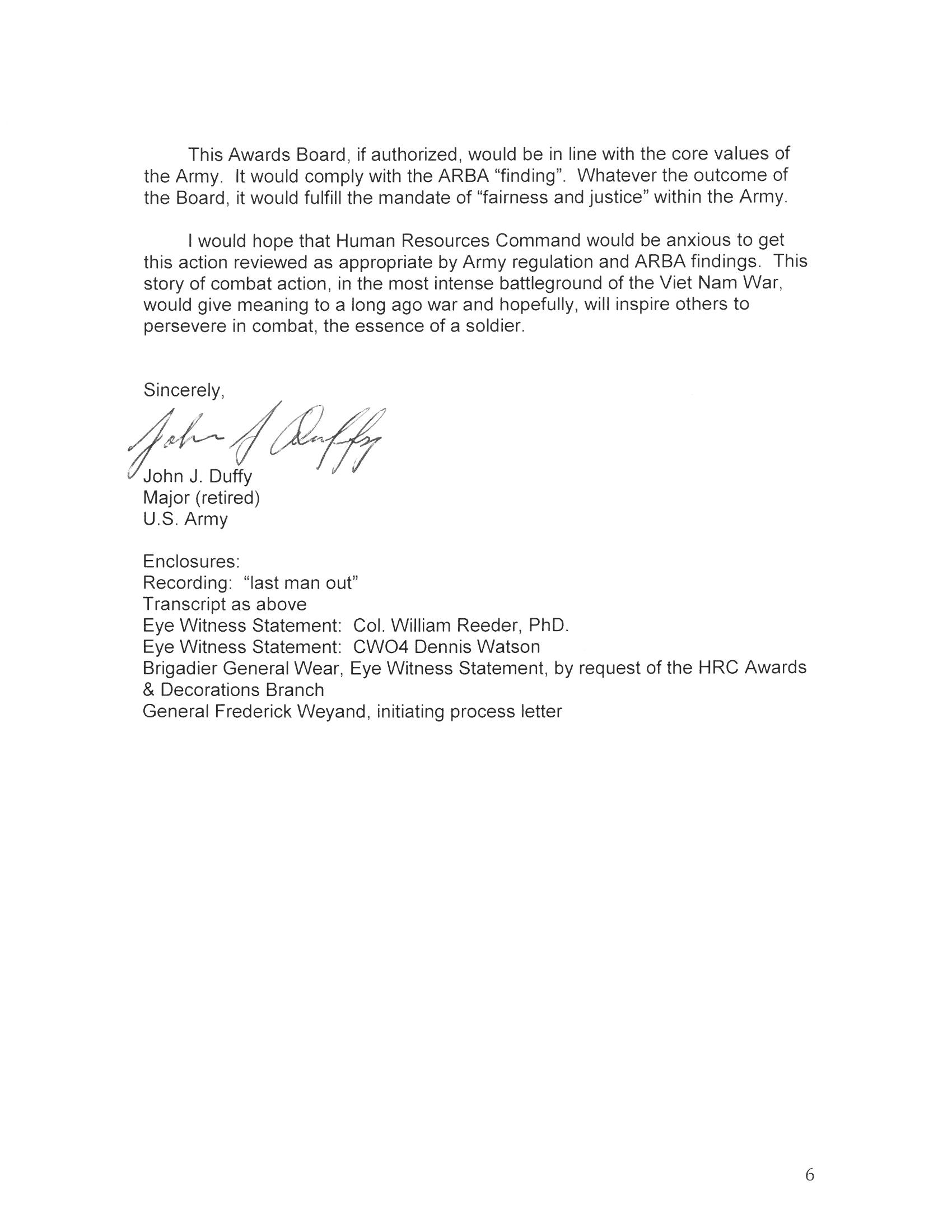


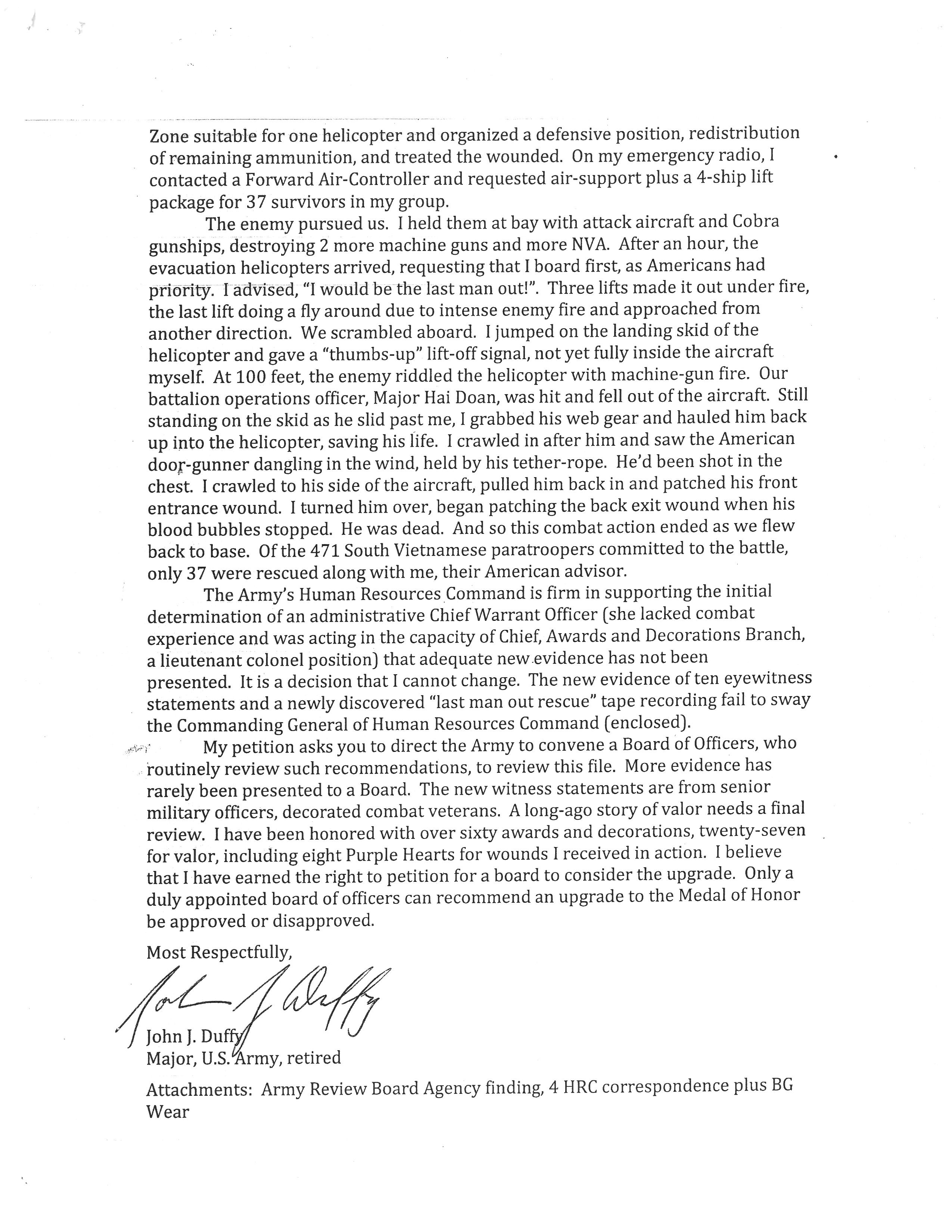
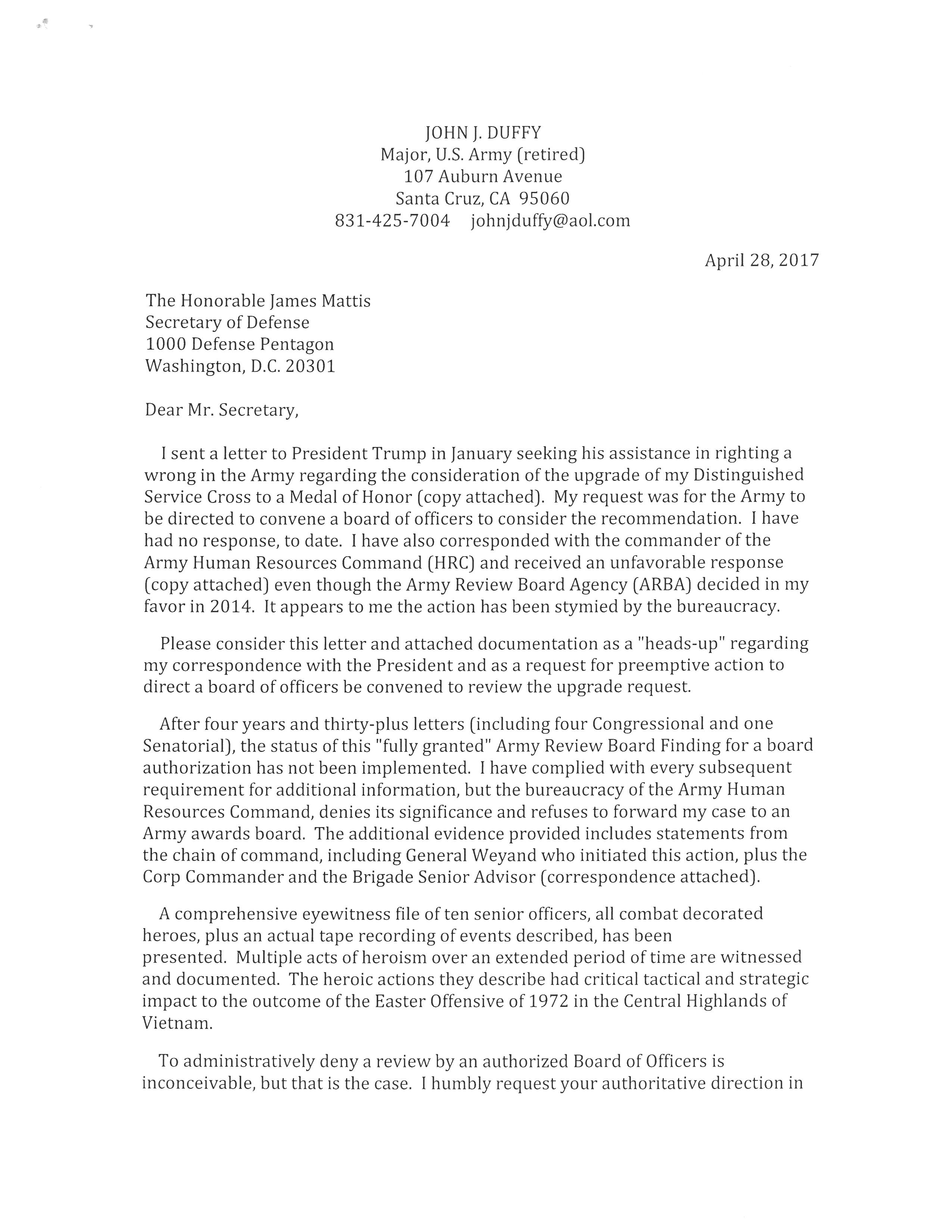
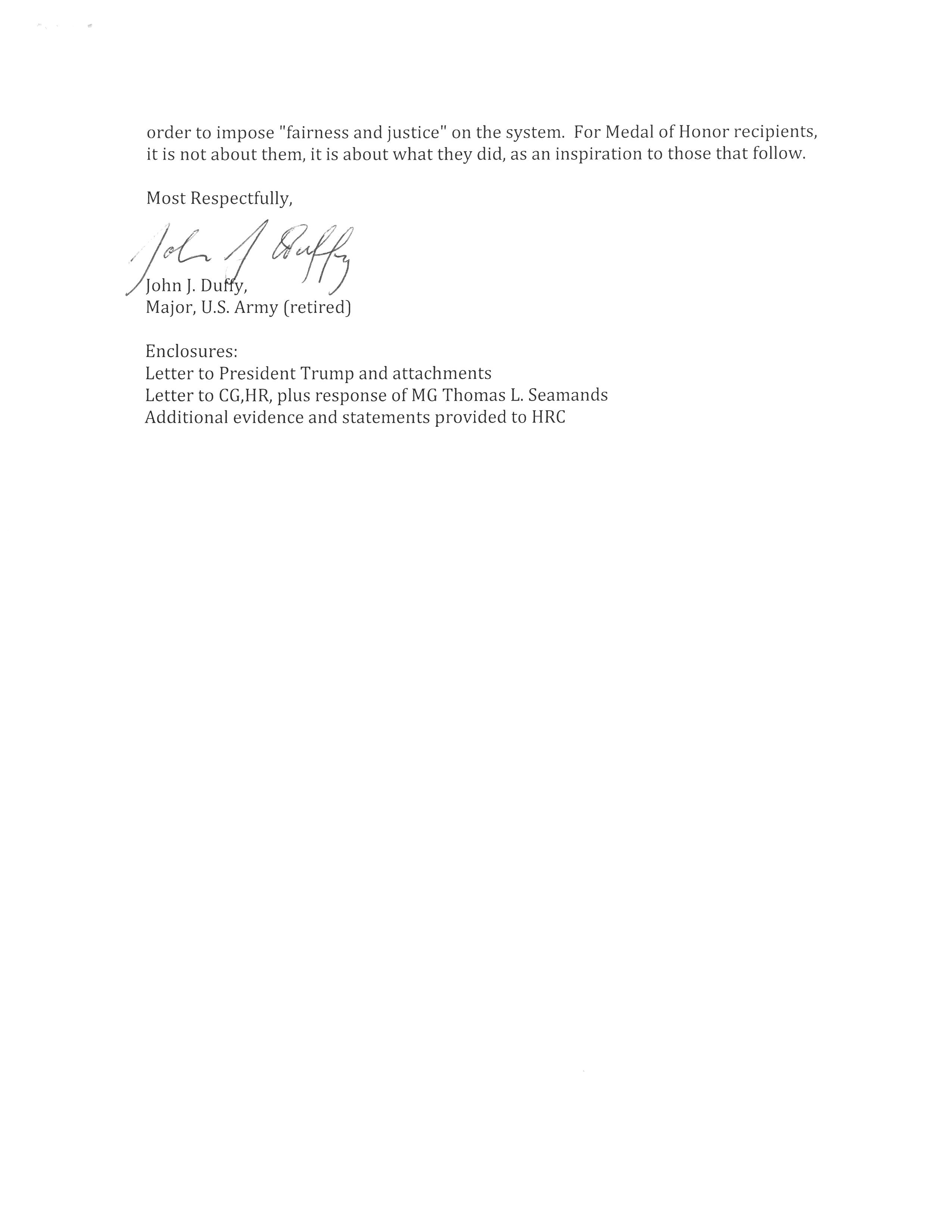
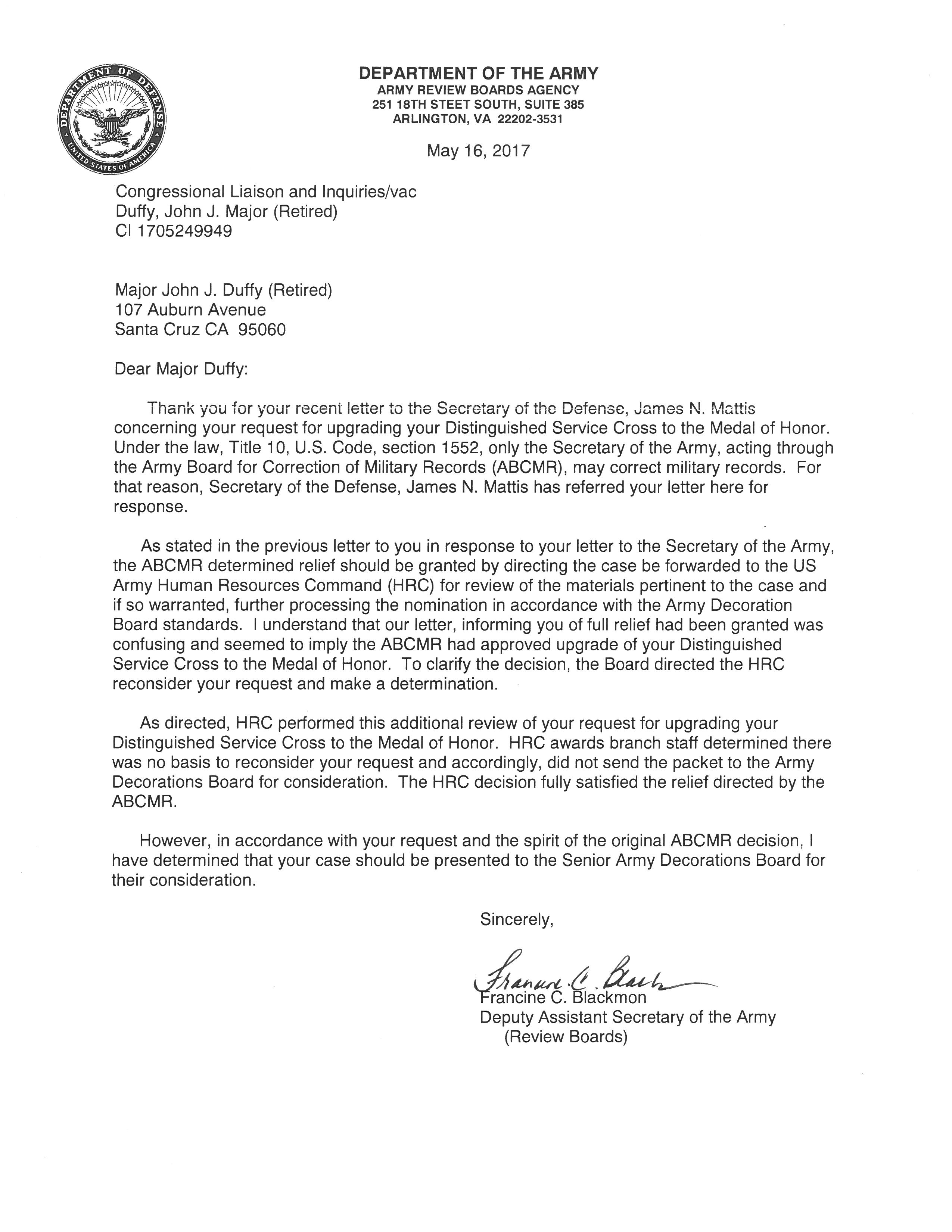

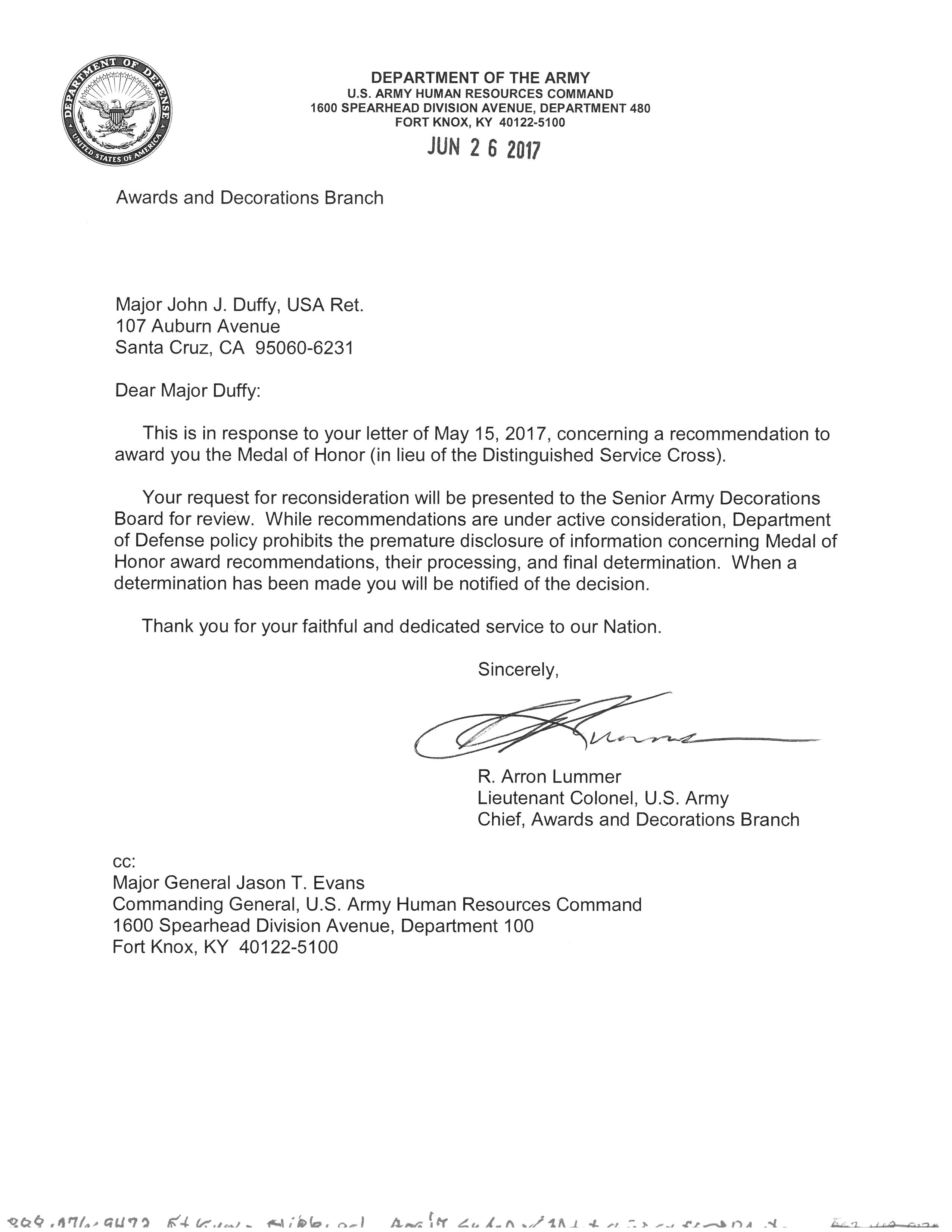
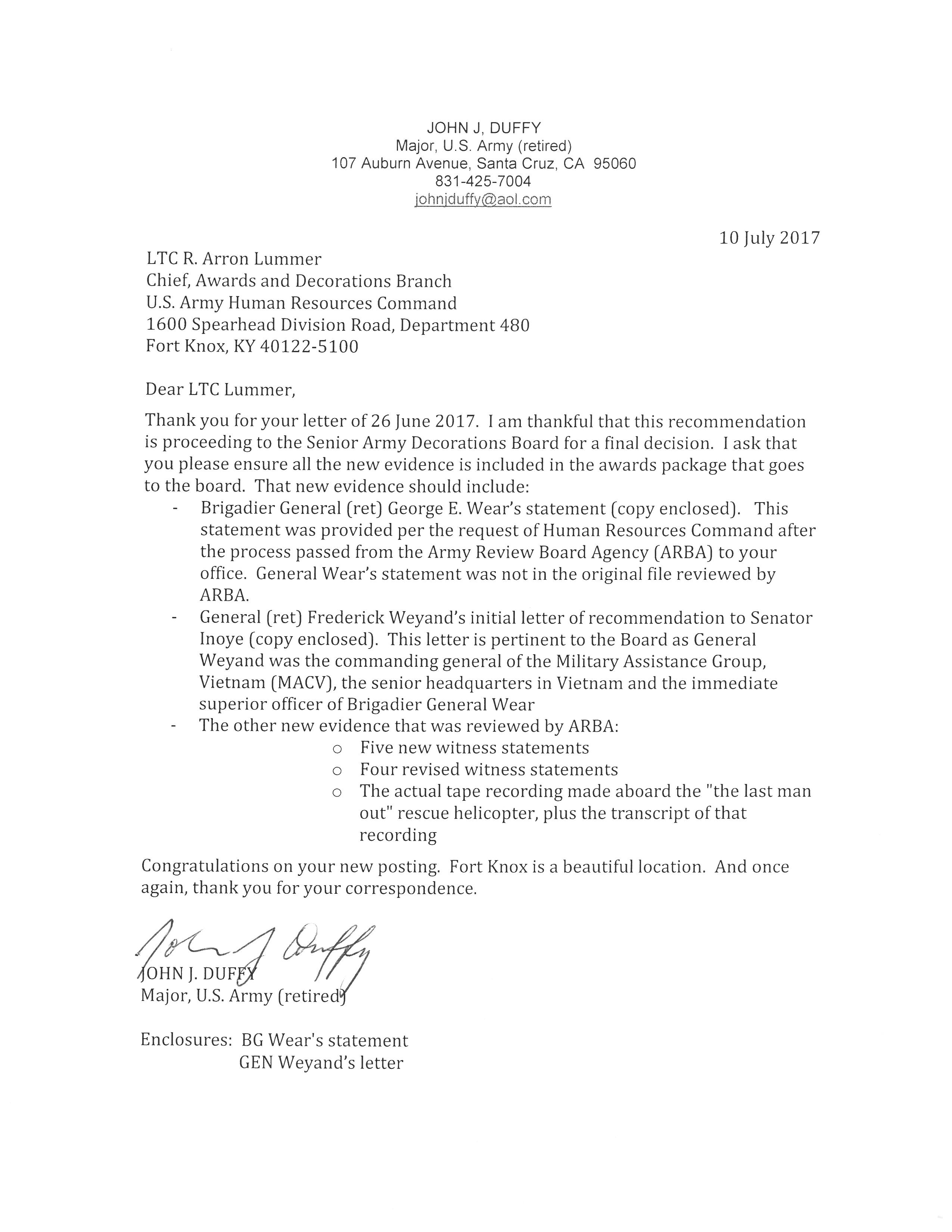
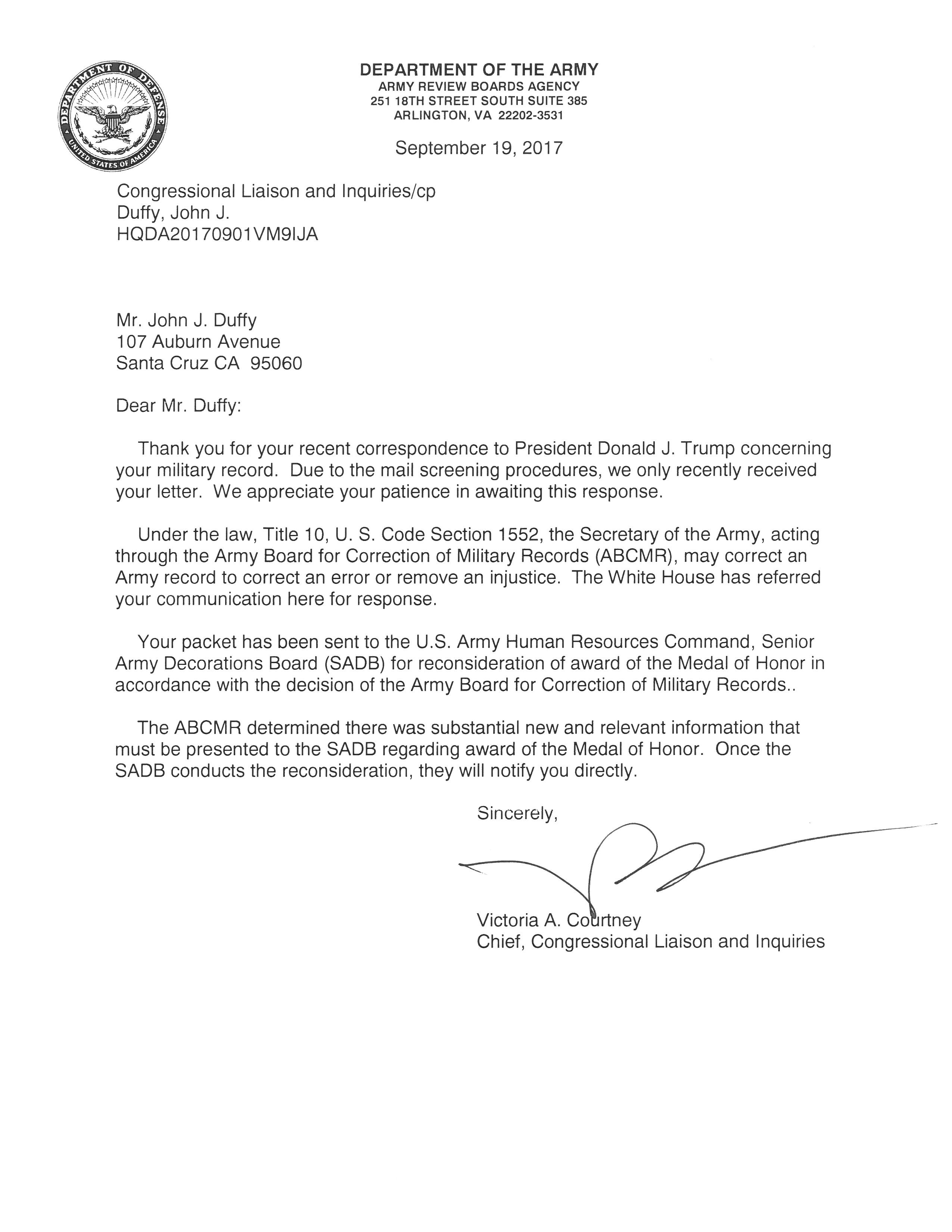
SUBMISSION
LTC PETER KAMA, US ARMY (RETIRED)
RESUBMITTED THROUGH THE OFFICE OF
SENATOR INOUYE OF HAWAII
MEDAL OF HONOR RECOMMENDATION:
Guest Book entries by helicopter pilots started this upgrade process. Forrest Snyder's entry on the 40th anniversity of the "Battle for Charlie" sparked the endeavor. Dennis Watson's entries were paramount as he had a tape of the rescue.
All documents are posted that are pertinent to the submission. GEN Weyand and LTC Peter Kama initiated this process throught the office of Senator Inouye (HI), Medal of Honor recipient.
For all those contributing to the effort, thank you.
Recommendation upgrade to Medal of Honor information/documentation
"Easter Offensive" Spring 1972
North Vietnamese Army order of battle:
14 NVA Divisions
26 (separate) NVA regiments
1200 armored vehicles and tanks
artillery support at Division, 105mm and 130mm
Total NVA: 150,000 officers and men
Northern Battle Force, Route 1 (Quang Tri-Hue-South to Coastal Plains)
Southern Battle Force, Route 18 (An Loc-Saigon)
Central Highlands Battle Force, (Route 14-Kontom-Coastal link-up with Northern NVA Battle Force)
The "Battle for Charlie" took place in the Central Highlands
The coastal zone of Central South Viet Nam had been captured by the NVA. The 320th was the lead Division tasked to break through the only mountain pass and defeat Kontum defensive forces. The pass was defended by the 11th ARVN (Airborne) Battalion. Post defeat of the ARVN defensive forces, link-up with NVA Coastal Force. The link-up would severe internal lines of communication and divide South Viet Nam into two separate segments, stageing for a piece meal defeat.
Order of Battle:
3 Divisions
estimate: 5-6 (separate) regiments
approximately 300 plus armored vehicles and tanks
Supporting 105mm, 122mm and 130mm artillery plus specialized anti-aircraft units
Approximately 35,000 NVA
Battlefield: "Charlie" or "Hill 1015"
North Vietnamese Army (NVA) Order of Battle:
320th North Vietnamese Army Division:
Division:
Reconnaissance Battalion 19,
Regiment 64;
Battalion 7
Battalion 8
Battalion 9
Regiment 52;
Battalion 4
Regiment 48;
Battalion 2,
Battalion 3,
Attachments:
D74 122mm howitzer Battalion (reinforced during the battle)
105mm and 130mm artillery batteries (Div.)
12.7 (anti-aircraft) Machine Gun Company
Army Republic Of Viet Nam (ARVN) Order of Battle:
11th Airborne Battalion, one American advisor
ARVN Artillery Support, 105mm and 155mm
TACAIR (American ground control required)
Corbra gunship (American ground control required)
VNAF (A-1e) support
On April 2, 1972, 471 paratroopers including one Advisor combat assaulted by helicopter into a pass below Hill 1015 designated "Charlie" with mission to block entrance to Route 14 which led to Kontom City. The Battalion Advisor Team is normally a four man team, 2 officers and 2 NCO's. Major Duffy was committed as the only advisor, this breached doctrine of a minimum of two US personel deploy together. No one else was available as the team was short one, another had hepatitis and the back-up officer was on R&R. Major Duffy advised it was not a problem and volunteered to deploy as a one-man team.
GENERAL FRED C. WEYAND
(Commander, MACV)
( 37th Chief of Staff, United States Army)
July 7, 1998
Honorable Daniel K. Inouye
Prince Kuhio Federal Building
300 Ala Moana Boulevard Suite 7-212
Honolulu, Hawaii 96850
Dear Senator Inouye:
This correspondence is to support the efforts of Peter Kama in his quest to recognize valor in combat of the highest order for John Duffy, a courageous American soldier, who served under Major Kama during some of the toughest fighting in the Vietnam War.
Peter served as my Aide de Camp in Vietnam from November 1970 to December 1971. He volunteered to return to combat duty advising the 2nd Vietnamese Airborne Brigade. This was during the final period of the exodus for our ground troops (January 1972 - July 1972) and many support units as well. The Vietnamese were in the offense responding to heavy losses in the Northern and Western regions.
Many advisors were alone with their counterparts, and as happened with the 442nd Regimental Combat Team many years before, there were many valorous actions that went unrecorded or were not accorded the official recognition that they deserved.
Hopefully, this submission will be favorable received and reviewed.
Sincerely,
signed
Fred C. Weyand
General, U.S. Army, Retired
October 15, 2014
Commander
Human Resources Command
ATTN: Awards and Decorations Branch
1600 Spearhead Division Avenue
Fort Knox, Ky 40122
Subject: Endorsement for the Medal of Honor - John J. Duffy
I was the Deputy to Mr. John Paul Vann, the 2-star equivalent director of Second Regional Assistance Group (SRAG) who was the senior American in the II Corps region of the Republic of Vietnam in April 1972. As John Paul Vann's deputy. I was the senior military officer in Military Region 2. The Army of Vietnam's 2d Airborne Brigade (RVN) was rapidly shifted to my area of responsibility to meet the rising threat of the North Vietnamese 1972 Easter Offensive, the largest Communist offensive of the war. The Brigade was assigned the mission to block the entrance through the mountains to Route 14, the single major route leading to Kontum, the provincial capital. The brigade's 11th Airborne Battalion was placed on Firebase Charlie, the most significant terrain feature between the enemy and Kontum. That 470-man force held their blocking position for two weeks against intense attacks by multiple North Vietnamese Army (NVA) battalions.
Major John Duffy, the sole American advisor with the 11th Battalion distinguished himself conspicuously by his gallantry and intrepidity at the risk of his life above and beyond the call of duty while engaged in action against the attacking North Vietnamese Army's 320th Division at Firebase Charlie. His bravery and most significantly, his self sacrifice were consistent in the face of a determined enemy as cited by the recommending officer, LTC Peter Kama, the 2nd Airborne Brigade's senior advisor. Major Duffy suffered five wounds and refused to be medically evacuated twice. He performed as an air controller, placing numerous attack aircraft and helicopter gunships on enemy positions and formations. He volunteered to be the rear guard and was instrumental in the escape of the remnants of the Battalion from "Charlie". His counterpart, wounded while fighting in the rear guard action turned over command of the Battalion to Major Duffy. Their night escape throught the jungle was hit by friendly artillery fire, Major Duffy promply gave the "Check Fire" order, stopping what could have been a deadly barrage. The group was ambushed the next morning by a NVA battalion. Major Duffy led the break-out force, secured a Landing Zone, requested emergency extraction, all while fighting off the pursuing enemy for an hour. When asked to board the first extraction helicopter, he refused, proclaiming, "I will be the last man out".
The last helicopter lifted off under fire. Major Duffy, standing on the aircraft skid, caught a wounded Vietnamese Officer falling from the aircraft and threw him back into the ship. He then proceeded to treat the wounded helicopter crew chief who died in his arms.
I personally debriefed Major Duffy extensively on April 16, 1972, the day following his extraction. I positively endorse the award recommendation for the upgrade of his award to the Medal of Honor for his actions on Fire Support Base "Charlie" during April, 1972 and I strongly recommend approval.
signed
George E. Wear
Brigadier General, U.S. Army (retired)
9100 Belvoir Woods Parkway, #304
Fort Belvoir, VA 22060
S-T-A-T-E-M-E-N-T
July 27, 2012
As Senior Advisor to the 2nd Airborne Brigade during the Easter Offensive of 1972, I was directly senior to Major John J Duffy, the Senior Advisor to the 11th Airborne Battalion. His unit was posted to my Brigade on April 1, 1972.
Peter Kama
LTC US Army
(retired)
notarized
EYEWITNESS STATEMENT
August 1, 2012
Me Van Le LTC, Army of the Republic of Vietnam
Last active duty position: Airborne Division Operations Officer, G-3, 1975
Position during statement: Executive Officer and Commanding Officer, 11th Airborne Battalion
Current Residence: San Jose CA 95136
Occupation: Retired Senior Engineering Manager, Samsung Information Systems,
Citizen: USA
Major Duffy was the senior advisor to the 11th Airborne Battalion. We had previously campaigned with the battalion in the Tay Ninh Area of Operations and during the Cambodian Incursion, before the Easter Offensive campaign. However, during the two-week campaign at Kontum in April of 1972, Major Duffy was the finest combat officer that I have ever met.
The 11th Battalion of the Airborne Division of the Republic of Vietnam (470 men and officers) combat
assaulted on April 2, 1972 into Fire Support Base Charlie in an effort to stem or contain the offensive actions of the North Vietnamese 320th Division. We initially placed our units in the best defensive positions possible, taking maximum advantage of the terrain and the anticipated direction of attack by the North Vietnamese Army (NVA). Our position was located on Rocket Ridge north of Kontum and was designated Fire Support Base (FSB) Charlie. The initial contacts were with probing enemy forces and the battalion also received considerable enemy artillery, mortar, recoilless rifle, and rocket fire.
On April 11, 1972, while our battalion command post was under heavy incoming 130mm enemy artillery, Major Duffy bravely left the safety of our bunker to direct the friendly air strikes effectively enough to knock out one of the 130mm artillery pieces. He also directed friendly aircraft onto the massing enemy infantry positions. Risking his life and exposing himself to direct airstrikes was an extreme act of bravery.
On April 12, 1972, three of our four command bunkers took direct 130mm artillery hits within a few minutes of each other. LTC Bao, our Airborne Battalion commander, was mortally wounded. I assumed command of the battalion after he died. My bunker and Major Duffy's bunker both were destroyed.
During this entire engagement, even as he was the only one to survive from his bunker, Major Duffy appeared to be fearless, he calmly moved around the perimeter and directed airstrikes and automatic weapons fire on the approaching NVA Infantry to protect the battalion. He knew without his direction, critical American air support would not be available. He directed the aircraft and friendly artillery onto the NVA AA .51MGs knocking out four of them in order for us to get our last resupply of ammunition, water and rations. He even refused medical evacuation, insisting that he had to protect the battalion. His courageous actions saved our ability to continue to fight by getting us the needed supplies.
In the early hours of the 13th, the NVA attacked one of our company positions, Major Duffy, who passed out from a concussion with his radio in hand, was awoken. He directed a Spectre C-123 gun platform fires onto the attacking NVA force, killing and disrupting their night attack. He stayed awake the rest of the night directing flare ship support.
On the 13th , I continued to coordinate fires with Major Duffy, taking out enemy targets between us. We targeted our artillery, Vietnamese Air Force strike aircraft, both US Air Force and US Army attack aircraft and B-52 strikes against the NVA. The coordination was very effective and the
enemy suffered heavy casualties. Both Major Duffy and I continually exposed ourselves in order to effectively direct fire on the enemy positions. We both suffered wounds, but these were not serious.
On April 14, 1972, our situation became extremely critical. FSB Charlie was ringed by .51 caliber AA machine guns, denying us any further resupply. With the ammunition running out, I ordered a breakout from FSB Charlie. Major Duffy volunteered to cover the withdrawal with gunships, and I stayed with him at this critical maneuver. During this battle of the rear guard, both of us were wounded as Major Duffy was forced to work the gunships ever closer. On the last enemy assault, the NVA were within a few meters of our position, only his fire disrupted the attack. His efforts were instrumental in inflicting heavy casualties on the enemy and in saving the battalion during this phase of the withdrawal. Major Duffy and myself were the last two to leave the perimeter. As we broke contact, Major Duffy directed B-52 strikes on our former positions and the positions of the North Vietnamese.
I had sustained a sucking chest wound and I was incapacitated and Major Duffy temporarily assumed command of the battalion and led us out of the danger zone. Major Duffy then ordered Company 113 to link-up with the remainder of the battalion at first light, where we could reorganize and redistribute ammo and conduct a successful retrograde operation.
On the morning of April 15, 1972, Major Duffy returned command of the battalion to me and briefed me before daylight on the actions that he had taken during the night. At first light, I ordered a halt in order to reorganize and to await the link-up with Company 113. It was determined that Company 113 was unable to break out and link-up was not imminent. I gave the order for the Companies to move out, concerned that we had remained too long in one location.
As the surviving 170 paratroopers were moving from our night defensive positions, the NVA initiated a battalion size plus ambush with small arms, 60mm mortars, and automatic weapons. Our unit was devastated and scattered. Major Duffy and I organized the Command Group and Major Duffy led the breakout through the killing zone. Leading the way through the jungle, ignoring enemy fire, he found a LZ (landing zone). Major Duffy quickly organized the defense of the LZ with the 36 men that were left from our battalion, and utilized his emergency radio, quickly established communications with a FAC (Forward Air Controller). He requested an immediate helicopter exfiltration and many covering air strikes.
The NVA were oblivious to tremendous losses that they were sustaining and continued to close in and placed effective fire on the first extraction helicopter. Major Duffy immediately placed suppressive fire on the enemy gunners who were in a stream bed. He worked two sets of A-Is and two sets of Cobras. The second and third lifts got out without taking as much fire. At this point, there were only five of us remaining on the ground, including Major Duffy who refused to leave before everyone was out safely. Even though Americans had priority in evacuations, Major Duffy advised he would be "the last man out." The NVA regrouped and stormed the Landing Zone. As we drove for the aircraft, my S-3 Captain Hai was hit in the foot and was knocked out of the aircraft. Major Duffy, who was standing on the skid directing airstrikes, reached out and caught him and threw him back into the helicopter. Major Duffy continued to ride the skid until we cleared the LZ. The aircraft took numerous hits and the left side door gunner was hit in the chest. Major Duffy immediately jumped in and grabbed him and began to perform mouth to mouth resuscitation as he applied pressure bandages. The young door gunner died in Major Duffy's arms.
We rode to the Medical Evacuation facility. Major Duffy had been wounded six times over the last three days.
Major Duffy was an expert. He was where we needed him. He routinely exposed himself to enemy fire. He was fearless and a real leader for the paratroopers. His fighting abilities, especially with the strike aircraft, was incredible. His unselfish devotion to his duty and the men he commanded not only saved the 11th Airborne Battalion but also the destruction of two complete battalions of the NVA's 320th Division. His ability to coordinate and advise was paramount to the survival of the command. Though Major Duffy was wounded several times, he never flinched. He was the last to leave the FSB Charlie, and he took command in the moment of need. He held the command together during a night withdrawal, and was the last man to get on a rescue helicopter. Major Duffy trusted the ARVN paratroopers and they trusted him. I personally thank Major Duffy for saving my life. Without him, I could not imagine how and what my life would be. As a counterpart and on the behalf of all of my surviving paratroopers, I deeply thank him. He is my hero and I respect him as one of the greatest soldiers of all time.
Major Duffy performed with distinct bravery, expert knowledge, and tenacious fighting abilities. He deserves this nation's highest decoration for valor.
August 1, 2012
Me Van Le
WITNESS STATEMENT of Terry A. Griswold, Major,USA RET, Lansing, Ks. 66043
REFERENCE: DAK TO Map Sheet, 653811, series L7014.
BACKGROUND
In March, 1972, the 2nd Airborne Brigade (ARVN), was deployed to the area north of the city of Kontum, in Viet Nam's Central Highlands. This was in response to the North Vietnamese Army's (NVA) build up in Base Area 609, and along the major NVA supply route commonly referred to as the HO CHI MINH TRAIL. Ground combat had been light but constant during the month of March. In my capacity as Deputy Senior Advisor, I was operations officer at the 2nd Brigade Tactical Operations Center (TOC), located at Vo Dinh. I was a witness, through communications with/and debriefing of Major Duffy. The following is the account of the actions of Major John J. Duffy, Senior Advisor, 11th Airborne Battalion during the period 12 - 15 April 1972. This account is based on information from my notebooks, and my own personal knowledge of that battle for FSB Charlie
The 11th Airborne Battalion had been relocated from Red Hat Hill near Long Binh to Vo Dinh. On 2 April 1972. the battalion conducted a combat assault by helicopter onto Fire Support Base (FSB) Charlie (vic 009108). The enemy situation around FSB Charlie was active with several .51 cal. heavy machine guns active near the fire base. NVA recon teams and platoon size units had been conducting operations against FSB Charlie's defensive perimeters. From 3 April until 10 April 1972, the NVA continued to develop the tactical situation.
On 11 April, FSB Charlie. and the 11th Airborne Battalion received over three hundred rounds of 130mm artillery fire. US and ARVN intelligence sources warned of a full scale assault against the line of FSBs along the mountain spine commonly referred to as Rocket Ridge. Numerous intelligence reports were received reporting NVA forces moving into staging areas west of Rocket Ridge (vic 990100).
At 0700 hours on 12 April, I relieved the night shift operations officer, and was immediately involved in supporting combat operations on and around FSB Charlie. According to the Staff Officer Journal (DA Form 1594) / radio log, Major Duffy reported at 0655 hours, heavy mortar, RPG, and automatic rifle fire from enemy probes. These probes had evolved into a full scale assault, and the enemy force was estimated to be a re-enforced NVA infantry battalion. NVA 105mm and130mm artillery fire was supporting the attack, and at 0745 hours, Major Duffy reported that a position designated as Charlie One had been overrun by the NVA after several attempts. The US Air Force forward Air Controller(FAC), call sign COVEY 580, was cleared to use airstrikes on/around FSB Charlie under the direction of Major Duffy. The FAC immediately began to vector US Air Force airstrikes against the NVA. At this time, my Vietnamese counterpart ask that I instruct Major Duffy to use caution, and take cover because his battalion commander was concerned that Major Duffy was exposed to heavy and accurate enemy fire. The request was passed to Major Duffy.
At approximately 1100 hours, a replacement FAC, call sign COVEY 565 reported in, and control was passed to Major Duffy. At 1130 hours, radio contact with Major Duffy was lost. My Vietnamese counterpart reported that 3 of the 4 command group bunkers had been knocked out by enemy artillery, and the battalion commander was seriously wounded. Radio contact was re-established at 1150 hours, and Major Duffy reported the death of the battalion commander. Major Duffy assisted the executive officer in re-establishing control and continued to call in airstrikes. He provided instructions to Cobra gunships, call sign PANTHER, and COUGAR, and after moving to an exposed position, directed the supporting gunships against targets along the battalion perimeter. At 1600 hours, Major Duffy's bunker was destroyed by a direct hit from enemy 130mm artillery fire. Communications with Major Duffy was again lost.
On the morning of 13 April, I relieved the night shift operations officer, and according to the operations log, Major Duffy spent the remainder of the previous night and early morning of the 13th directing airstrikes against enemy staging areas, and against enemy activity on Charlie One. At 1300 hours, enemy artillery fire increased against the fire base, and Major Duffy was wounded a second time in the left shoulder by shrapnel. His analysis of the LZ's critical situation was confirmed at 1645 hours when two VNAF A-1E aircraft were shot down by .51 cal. AAA fire over Charlie One. At approximately 1445 hrs. Major Duffy declared the LZ untenable for use, and that helicopter survivability was zero. . He stated that the LZ was no longer operational and closed. By closing the LZ, Major Duffy saved countless lives and helicopters. For the remainder of the evening, Major Duffy used artillery, tactical air force strikes, and helicopter gunships to repel enemy probes.
The situation on 14 April continued to deteriorate. An airborne company, of the 11th Airborne Battalion, was directed to find and secure an alternate evacuation LZ East of the fire base. The unit made contact with a strong NVA force, and after a sharp fight, the company was forced to withdraw to the fire base. Enemy 105mm artillery fire increased against the firebase, and while directing airstrikes under the control of a FAC call sign COVEY 537, Major Duffy was wounded a third time by shrapnel in the left arm. At 1500 hours, Major Duffy sent a message to the Brigade Senior Advisor, Major Kama, informing him that a major attack was forming, and requested demolitions be airdropped in support of the battalion's efforts to cut LZs for ammunition resupply, and evacuation of wounded.
Major Duffy, disregarding his painful wounds, consolidated the surviving personnel, and moved out through the darkness into the dense jungle. The survivors covered several kilometers through the night and into the next morning. During this time, Major Duffy coordinated AC-130 SPECTRE gunship support and through the FAC directed B-52 bomber strikes against pursuing NVA units. At 0600 hours, Major Duffy halted the group and consolidated defensive positions 300 meters from the Krong River. The group was attacked by pursuing NVA units at 0700 hours. The attack caused the group to disperse, and Major Duffy led the command group out of the killing zone. He coordinated with COVEY 555 for air support and helicopter extraction, and led the command group away from several ambush sites, which he detected. The extraction LZ was under direct fire and observation. The NVA continued to chase the evading survivors onto the LZ. Major Duffy guided the rescue helicopters into the LZ and was exposed to intense direct fire. As the helicopters left the LZ, the lead helicopter pilot reported that Major Duffy had been the last individual to leave the area. The exfiltration was completed at 1000 hours.
Major John J. Duffy's courage, leadership, self-sacrifice, and professionalism during the battle for Fire Support Base Charlie was un-paralleled. His actions helped de-railed the NVA's time table for the Easter Offensive in the Central Highlands. He was wounded seriously, and refused to be evacuated from his battalion. He carried out his duties while constantly subjected to direct and indirect fire. When forced off the fire base, he saved the lives of over fifty paratroopers. There is no doubt in my mind that Major Duffy's actions deserve consideration for, and the award of the Medal of Honor.
I was present in the 2nd Airborne Brigade TOC during the battle for Fire Base Charlie, and the information provided is true and correct to the best of my knowledge.
Terry A. Griswold
Major, US Army, retired
1 September, 2012
Eyewitness Statement
Re: Combat Actions of the 11th Airborne Battalion in the Central Highlands at the Fire Support Base Charlie and vicinity March 30 through April 16, 1972.
Major Hai P. Doan: position at the time: Operations Officer 11th Airborne Battalion. Army of the Republic of Vietnam.
Current Residence: Milpitas, CA 95035
Citizen: USA
I was the Operations Officer of the 11th Airborne Battalion of the Army of the Republic of Vietnam. Major Duffy was the Senior Advisor to the 11th Airborne Battalion. He had campaigned with us previously and was nearing the completion of his tour. He was a very experienced advisor.
The 470 officers and men of the 11th Airborne Battalion and one American Advisor (Major Duffy) were alerted on March 30, 1972 for combat operations in the Central Highlands of Vietnam. We moved initially by aircraft to Kontum, and were then trucked north. On April 2, 1972, we combat assaulted onto Fire Support Base Charlie. Over the next seven days and nights, the enemy contacts were with the probing enemy forces during the evenings and our positions was subjected to ever increasing enemy bombardments from heavy artillery, to include NVA 105mm and 130mm fire.
On the 12th of April, several command bunkers were hit by enemy artillery fire, the Battalion Commander, LTC Bao was mortally wounded, Major Me V. Le assumed command of the Battalion.
During the battle, I coordinated all supporting fire with Major Duffy. We directed artillery, Vietnamese Air, both US Air Force and US Army strike aircraft and even B-52 bomb drops. The coordination was very effective, we got good coverage, and we annihilated many NVA attack formations. Both Major Duffy and myself were required to be continuously exposed to enemy fire while coordinating friendly air and artillery strikes.
Our situation became untenable as the NVA positioned AAA weapons to cover our Landing Zone. It quickly became obvious that we could not be resupplied with these .51 caliber machine guns targeting our landing zone. Our ammunitions supply became critical and we were forced to abandon Fire Support Base Charlie.
During the evacuation, it was decided that Major Me V. Le and Major Duffy would stay behind with a small rear guard in an effort to fool the NVA into thinking that we were still manning our positions thus gaining enough time for the successful withdrawal of the battalion. The combat on FSB Charlie was intense; smoke, explosions, and screaming were the norm. Major Duffy directed the final sortie of gunships in on the enemy to cover the withdrawal. Both Majors Le and Duffy were wounded. Major Me V. Le and Major Duffy were the last two to leave the perimeter. During the break out Major Duffy was wounded in his hands and chest by enemy grenades as they pressed their attack over the walls of the compound. He continually exposes himself to enemy fire in order to direct the friendly air assets and I believe that his actions saved the survivors of our battalion during the withdrawal. Due to Major Le's serious wounds, Major Duffy covered his evacuation and was the last soldier to leave FSB Charlie.
When the squad from the delaying action finally linked up with us, we found out that Major Le was seriously wounded in the chest. Major Duffy assumed command of the battalion. He immediately ordered the link-up of Company 113 who were occupying high ground of the east of our positions. Unfortunately, during the night, friendly artillery mistakenly bombarded the paratroopers, Major Duffy ordered a "check fire!". He returned command of the Battalion to Major Le as soon as was able to continue.
The next morning, the Company Commanders reported the status of their units and we reorganized while awaiting Company 113's link-up. It was determined that Company 113 was unable to move to our position due to the large enemy units between us. Major Me V. Le gave the order for the Companies to move-out being concerned that we had been in one location too long.
As we moved from our night defensive positions, the NVA initiated an ambush. The initial fire was 60mm mortar rounds and automatic weapons fire. The command scattered. Major Le and Major Duffy held the Command Group and nearby paratroopers together. Major Duffy led the break-out of the ambush, by moving rapidly through the killing zones and into the surrounding jungle. During the break-out of the ambush, we lost all radios. The only servicable radio we had was Major Duffy's survival radio. He used it very effectively by directing air strikes on the pursuing NVA and contacted the rescue helicopters in an effort to evacuate the remaining members of the 11th Airborne Battalion. We were able to break contact with the enemy due to Major Duffy's expertise in directing gunships and moved quickly to the designated pick-up point that had been selected for us.
Major Duffy located the LZ (Landing Zone) and organized the perimeter defense. He then called for an emergency extraction on his survival radio. The first lift out took point blank machine gun fire from the south. Major Duffy worked the strike aircraft, both fixed wing and helicopter on the enemy positions. Lift two and three got in with moderate fire directed at them. Lift four, the last lift was to pick up the 5 remaining survivors of the 11th Airborne Battalion: Major Duffy, Major Me, myself and 2 soldiers. The NVA fire was extremely heavy and very accurate. After boarding the ship, I was shot in the right foot, I fell and my body seemed to be hanging in the air as I fell towards the ground. Major Duffy (who was standing on the skid of the helicopter directing air strikes), grabbed my cartridge belt as I fell past him and pulled me into the helicopter. The rescue ship temporarily lost control after being hit by antiaircraft fire as we were pulling out. The left door gunner was hit in the chest. Major Duffy dragged him in and checked his wounds. He tried to save the door gunner by giving him mouth to mouth resuscitation, but the door gunner dies in Major Duffy's arms a couple of minutes later.
Both the door gunner and I were dropped at the Medical evacuation point. I never forgot that time!!! Major Duffy was a hero commander. I often wonder what would have happened if Major Duffy had left on the first lift?? The answer is very clear: we all would have died or been captured by the NVA.
Major Duffy saved my life and the 36 paratroopers that survived with him. Major Duffy risked his own life to save the 11th Airborne Battalion on the Fire Base Charlie, led the break-out of the ambush and refused to leave before all the soldiers were safely aboard the last lift.
Major Duffy saved my life and the rest of the men's lives on that landing zone. The NVA were more numerous, closing in fast and determined to kill or capture us. I estimate we were within twenty to thirty minutes of annihilation.
Major Duffy risked his own life to save us, he refused to be evacuated before all the paratroopers were safely aboard the lift ships. He lead by example. Major Duffy performed in the highest traditions of bravery and he was very lucky. Major Duffy is deserving of this nation's highest award for valor: The Congressional Medal of Honor.
signed
Respectfully submitted, Hai P. Doan
notarized,dated
S-T-A-T-E-M-E-N-T
This statement is to support the award nomination for John J. Duffy.
In mid-April 1972, a substantial North Vietnamese Army (NVA) force hit Firebase Charlie on Rocket Ridge in the Central Highlands of South Vietnam. I was flying as pilot-in-command of an AH-1G Cobra attack helicopter that day. I was flying as the second aircraft in a fire team providing support in Kontum Province.
I was flying as wingman that day to Chief Warrant Officer Dan Jones. We arrived at Firebase Charlie to find a very poor situation. The firebase was surrounded with the enemy advancing in strength from three sides. The South Vietnamese were fighting hard, but the enemy assault was relentless.
We fired rockets, mini-gun, and our grenade launcher on concentrations of enemy in close proximity to friendly positions. All friendly positions were being hard pressed, and some being overrun. We also fired on enemy weapons positions that ringed the base. The ground fighting was the worst I had seen, and we received intense enemy fire directed against our Cobras. Major Duffy relayed that the battalion had heavy casualties and the battalion commander had been killed. He was requesting all the air support he could get. We expended our ordnance on targets that Major Duffy directed us onto, and then went to Kontum airfield to rearm and refuel.
By the time our fire team returned to Charlie, the situation had deteriorated dramatically. When we arrived, it was dusk. Major Duffy had directed other attack helicopters in our absence and employed A-1 Skyraiders and jet fighters around the firebase as well. Nonetheless, the enemy continued their attack and the situation for Major Duffy and his airborne battalion was deteriorating. The South Vietnamese defenders were being killed and their positions being overrun.
Major Duffy told us he was wounded, but would continue to work us. His focus on the radio was entirely on doing what he could for his South Vietnamese comrades. At times, while he had his microphone keyed, directing us, I could hear him giving orders to his counterparts who were fighting for their lives. I could also hear him dealing with casualties that were occurring all around him. I never heard him express any concern for himself. He would not ask for his own extraction. He seemed committed to fighting to the death with his battalion.
As the situation deteriorated further, he began asking for us to place our fire within 3 meters of his position. I have never seen greater bravery displayed in combat. His actions were affecting the best possible defense under overwhelming conditions. This fight marked one of the opening moves of the NVA’s Easter Offensive. This 1972 Communist campaign turned out to be a much larger series of battles than the more well-known 1968 Tet Offensive.
As darkness settled on the hilltop, the enemy overran the last remaining South Vietnamese positions of Firebase Charlie. Major Duffy called and reported he was rallying survivors and heading off the firebase. He asked us to expend our remaining ordnance right on top of the positions he was leaving. I was surprised how calm he sounded, and by his actions could tell how much in charge he remained, and how his heroic actions were the only hope for the survival of anyone left alive on the ground. Another team of Cobras from our unit, the 361st Aviation Company, joined us in the final moments of the battle, also firing on top of the base and covering the withdrawal of Major Duffy and the survivors of the battle.
While flying the next morning, I was surprised to hear radio calls for the extraction of a small element of the 11th ARVN Airborne Battalion from the valley floor east of Firebase Charlie. The badly mauled group was led by their wounded advisor, Major Duffy. The extractions were made by elements of the 17th Air Cavalry. I was amazed that anyone could have survived the concentration of North Vietnamese forces I had seen attacking Firebase Charlie. I have no doubt that without the actions of Major John Duffy as the American advisor for that unit, all would have been killed or captured.
William S. Reeder, Jr.
Colonel, U.S. Army, retired
In April 1972:
Captain, U.S. Army
Platoon Commander
361st Aviation Company, "Pink Panthers"
Camp Holloway, near Pleiku, Republic of Vietnam
S-T-A-T-E-M-E-N-T
STATEMENT
Nam Nhat Phan
Captain, Army of the Republic of Vietnam
Academy Military, Dalat (1963)
1963-1971 Platoon Leader, Company Commander, Operations Officer, Airborne Division
1971-1972 Press Officer, Ranger Headquarters
1973-1975 Operartios Officer, Joint Military 2 and 4 Party Committee
1975-1989, Prisoner, Communist Concentration Camps (I was isolated 1979-1988 in underground confinement).
As the Press Officer for the Ranger Headquarters, I contacted Doctor (Captain) To, Pham Lie who had just come back from "Charlie" Base. Kontum Province, in the Highlands of Central Viet Nam. Doctor To was at the Airborne Division Medical center treating the many wounded who had just returned with him from the battle.
I tape recorded all the details of the battle for "Charlie" Base. I additionally interviewed the survivors, and I assembled these battlefield heroics of the participants from the eyewitness.
They particularly talked about Major Duffy and his bravery, and about his rescue of he 11th Battalion men.
The story of "Charlie" Base was transmitted throughout all of South Vietnam by Voice of Vietnam Radio, Army Radio in Saigon, and throughout all of South Vietnam by local radio stations.
My recordings and interviews were assembled and reedited into a book. "The Red Flames of Summer" received wide acclaim and was awarded the 1972 National Literature Award. Doctor To, Pham Lieu is now deceased, but he was an eyewitness to the "Charlie" Base battle. In "The Red Flames of Summer", I recorded these events as told to me by eyewitness. The "Charlie" segment of the book has been translated into English, thus the board can read it; this is bringing back a witness from the past.
I should also state that the Vietnamese people had very few American heroes, Major Duffy is one of them because of his unselfish and extremely brave actions in this "Charlie" battle.
English translation by Vann Saroyan Phan
signed
notarized
Translation excepts attached:
Duffy, running amid smoke and dust with a radio on his back, was issuing short, clear and precise orders. And from the sky, silvery jet fighters, with their fierce firepower were diving down on the enemy hidden in the dark, smoky woods. At the jets cleared away, Cobra gunships came in. The noise of bombs, anti-aircraft guns, rockets, heavy guns and mortars shook the broken red-clay hill.
Like in a Hollywood combat scene, wherever Duffy went, enemy fire followed him. And he immediately moved to another position. "Shit" Major Me Le shouted into Hai's ears. "Get someone to tell Duffy to lie down because his antenna is being targeted!" It was a moment too late. Duffy's tall body was lifted off the ground and thrown into a trench.
Like a miracle, from the mess of soil, rock, dust and smoke, the sturdy man stood up and ran to another position, the receiver of his radio still in his hand. "Over! Over!" There was still no change in his voice.
* * * * * * *
Major Me Le, the executive officer of the battalion, did not bother to think of the number of weapons taken from the enemy by companies 1 and 3. The command bunker of "Colonel Bao had taken a direct hit by three big shells. No one in there could survive the explosion. After Colonel Bao died, Major Me Le replaced him as battallion commander. The duty was heavy for him since the situation seemed critical. Me Le, Hai and Dr. Lieu, the battalion surgeon, looked at one another. Night was falling and the warriors were spent. Duffy lay unconscious with a concussion, his receiver hanging loose and the radio buzzing in the darkness.
It was not a calm and silent night for them. A unit of communist sappers attacked the northermost outpost of Company 3, aiming to clear the way for another attack on Fire Support Base Charlie.
Driven by a miraculous strength, Duffy stood up with his radio in hand, using his personal frequency. Because of the darkness, aircraft that were effective in daylight were rendered ineffective. Duffy had to rely on another weapon: the armed Spectre C130. From a hole in the night sky, the "fire dragon", directed by Duffy, let off a volley of endless fire and smoke on the dark jungle below. The fire licked a circle around the base. The fire shed light on the attacking Northerners. The day was approaching but nobody could notice it since smoke from the night fires had blurred the sunshine. Duffy spent another sleepless night, his radio by his side all the time.
The Last Day of the Battle for "Charlie"
The NVA had surrounded "Charlie" with ant-aircraft guns. The fighters were out of water, food and ammunition. No resupply was possible, as the guns surrounded "Charlie". There were many wounded among the paratroopers. Dr. Lieu was busy administering to them as best he could.
The situation was desperate, Major Me Le, Captain Doan and Duffy held a council. It was determined that the anti-aircraft guns and the artillery guns had to be taken out, because without resupply they would not be able to fight.
Major Me Le asked Duffy; "Can you knock out the guns?" Duffy said: "As long as I can get strike aircraft, I'll get them, but I need covering fire while I target the strikes."
Me Le told Hai; "See that Duffy's covered and have someone good spot the guns for him!"
Hai Doan responded: "It will be done."
They were thirsty, hungry and full of the grime and the blood of the battle. The mood among the commanders was grim and determined. They would not give up "Charlie."
Duffy, with Hai helping with the targets, went to the edge of the perimeter with his radio and began directing the airstrikes. He went after the guns, one after another. The NVA had spotted him and were targeting his radio antenna. He was wounded again early in the morning, but he kept on, ignoring his wounds. Duffy always kept moving, seeking the enemy and calling the bombs from the aircraft down on them.
He knocked out five anti-aircraft guns and three artillery pieces that were shelling "Charlie." The battle built up all day long. It was clear that the NVA were determined to take "Charlie."
The attack came early in the evening. It was a mass wave assault by a battalion size force. Hundreds of enemy rounds tore into "Charlie" base. Duffy continued to direct the silver jets and the sleek Corbra gunships. The fighters fought until they had no more bullets. Then they died fighting with grenades, knives and empty rifles, which were now used as clubs.
The aircraft punished and held off the attacking enemy. Major Me Le and Duffy were in the forefront, commanding the battle. Me Le ordered counter-attacks three times. Duffy worked the gunfire ever closer. The scene was one of noise and smoke and fear.
The enemy pushed two more battalions into the battle and "Charlie" began to crumble. Only the planes held the enemy back.
The retreat of the battalion from "Charlie"
At last, Major Me Le, Hai and Duffy came to a decision: They would abandon Charlie by late afternoon on April 14. Duffy volunteered to stay behind and cover the withdrawal. Major Me Le agreed and ordered Hai to lead the withdrawal as night began to descend.
Duffy covered the withdrawal by working the Corbras in the trench lines that the NVA were using to advance. He gunned them down as they tried to overwhelm his position. When the troops had withdrawn, only Duffy remained with Major Me Le covering him. Then they broke contact, and ran for their lives. Duffy asked for some B-52 sorties on the east and the west of the firebase. When the battallion was 400 meters away from the base, the bombs started to fall. The whole unit lay struggling on the slope because of the high pressure created by the explosions, which felt like an earthquake. The terrible tremor was felt from everybody's feet and chest. Me Le bent his body down in pain from his wound. Hai spat out clots of dried blood. Dr. Lieu lay motionless by the foot of a tree.
As Duffy was the only officer still in good shape, he temporarily replace Me Le as commander for the night retreat. Duffy was the last resort of the whole battalion. And actually he was the last soldier on the way out. Artillery fire mistakenly bombarded the friendly troops as they were withdrawing, Duffy "checked fire," but not before more fighters were killed
On the morning of April 15, Me Le chose a clearlng by the Poko River for the battalion to fetch water and to evacuate the wounded. An empty space among the reeds was their last hope after seven days and nights under heavy bombardment and human wave attacks by two communist regiments at Firebase Charllie. Me Le requested lift evacuation, however the Brigade said there would be no evacuation hellicopters and ordered the battalion to fight its way back to Tan Canh. But how could the airborne unit continue to fight with the remainilng 167 men - including the wounded - who were hungry and mostly out of ammunition?
Me Le asked Duffy to come to him as the American advisor was following Hai and Dr. Lieu. After being wounded five times in four days of fighting, and with little sleep, Duffy was still hard as steel.
"You're number one," Dr. Lieu said to Duffy as the man walked past Hai to be with Me Le.
"Hello! Doc!" Duffy smiled at the battalion surgeon.
"Hey, Duffy! The Brigade had no chopper for us. Our only hope is you." Me Le was unable to continue with what he really wanted to say.
The American advisor grasped the idea quickly: "OK! Ten minutes, Sir!" said Duffy, who gave a thumbs-up.
But no more than "ten minutes" for the 11th Battalion. From the elevations in the east, NVA gunners unleashed mortar and mountain artillery down on the airborne unit while enemy troops were attacking from the southeast. Without trenches, out of ammunition, tired, hungry and thirsty for four days, men from the 11th Battalion had endured the utmost suffering. They rolled over, moved back and forth and were dying amid the reeds and under the merciless shelling and shooting.
"Surrender, you'll survive! fight back, you'll die!" the Northerners shouted as they rushed into the battle like a dike broken away by flood. The whole battalion suffered the fate of an exhausted bear bitten by extremely poisonous bees. The unit fell apart into small fragments, each fought by itself. The voice of both sides yelling and shouting as the onslaught shook the jungle which was already filled with dark smoke.
Me Le declared. "No Surrender. We Fight!" Duffy said, "I'll lead. You cover me." And the breakout began. Duffy gathered all the fighters who hadn't fled, cocked his CAR-15 and sprinted northeast, away from the killing guns, with 36 men following.
It was like a miracle when Duffy succeeded in making contact with two Cobra gunships and an 02 observer plane. Thanks to the empty terrain of the wood and following the direction of Duffy, the Cobras could see clearly enough to fire and drive the enemy out of the clearing.
The remaining 36 men were divided into groups for evacuation.
A helicopter hastily landed on the edge of the wood. The pilot just wanted to evacuate Duffy first. But the man made a quick decision. Duffy told Hai, Me and Dr. Lieu: "I won't abandon you, friends in the fullest meaning I've ever met. If I leave on the first lift, the helicopter might not want to return to pick you up."
Me Le gave orders:"Lieu, you go first! You have a wound on your leg and you won't be able to run. Take the seriously wounded with you on the first lift."
"I won't go. I'll stay with you." Lieu protested.
"You must leave! That's an order!"
Hai pushed Lieu onboard the chopper. Lieu turned his head back to his friends, his eyes expressed sorrow and guilt. He did not know if they would live. The enemy was close and firing at them.
The communist troops ran toward those who remained on the ground. The whole group fired back, running. Cobras gave effective close support for the next two lifts. So the last group included Me Le, Duffy, Hai and Lt. Long. The communists called Me Le, Hai and Duffy by their names. They were trying to capture alive the battalion commander and his staff along with the Ameican advisor.
The last lift helicopter was coming in for the pick-up. The enemy was once again shooting at them from close range with automatic weapons. Duffy covered the command group with his weapon, saying, "Go! Go! Go!" All the time Duffy talked to the Cobras, and they made killing runs on the NVA. The command group scrambled aboard the aircraft. Bullets were tearing through the metal. Duffy jumped onto the strut and gave the pilot the lift-off signal.
Captain Hai was hit as the chopper lifted off and was falling out. Duffy grabbed him and with Me Le's help, pulled him back aboard. The door-gunner had been hit in the chest. The pilot struggled to evade enemy fire as the chopper was riddled with bullets. Duffy tried to patch the hole in the door-gunner's chest, but he died in Duffy's arms.
* * * * * * * * *
End of excerpt
My name is James M Gibbs, LTC, USA (Ret). In April 1972 I commanded H Trp (Air) 17th Cav stationed at Camp Holloway, Pleiku, South Vietnam. This was the period of the NVA and Viet Cong forces build up to take Kontum and other strategic locations to later overrun and take control of South Vietnam.
(Tape recorded April 15, 1972 by CWO Dennis Watson)
Forward Air Controllers (FAC) were typically Air Force aircraft used to spot and mark targets then call in and manage fighter-bombers to engage/destroy target. Aircraft type either O-1 Bird dog or 0-2 Cessna 337 Skymaster or OV-10 Bronco
(FAC1) Forward Air Controller. Call sign: Covey 555 (Triple Nickel). Directed UH-1’s to extraction point. Also managed fighter bombers,
(FAC2) Forward air Controller. Call sign: Covey 317. Came on station to relieve Covey 555.
(Sandy) Fighter-Bomber
(Jupiter) Fighter-Bomber
This audio is 48 minutes long. It begins with Covey 555 establishing visual with Pallbearer Lead.
Begin
(FAC555) Pallbearer lead, this is triple nickel
(PBlead) Go ahead triple nickel
(FAC1) Pallbearer lead, this is triple nickel. Do you recall where firebase 5 is?
(PBlead) I’m generally familiar with the area. Roger that.
(FAC1 to Sandy Aircraft) OK, the big tall ridge, it’s the tallest ridge along that ridgeline. We are just to the south of the tallest area on that ridge line. There’s quite a bit of smoke coming up. Should be no problem to find. From Vo Din I believe it’s a heading of, about, I’d say 320.
(PBlead to FAC1) Roger. We’re headed off the red ball toward your location.
(FAC1 to PB lead) OK and it’s on the east side, excuse me, the west side of the blue line.
(PBlead) OK, We’ll keep an eye out for it.
(65 "other" airraft) And, uh, triple nickel, 65.
(FAC1) Roger 65, Triple Nickel.
(65) Ah, your replacement, 517, I have him holding over Dak To at this time. I was going to let you finish expending the Sandys. He can come over. You want to break for another thing or what?
(FAC1) OK, he’s gonna have to come in. I’m running kind of T-T on fuel and, ah, let’s see… Sandy, this is triple nickel.
(Sandy) Go ahead.
(FAC1) Rog. How many drops do you figure you have left?
(Sandy) Ah, we could probably be fired out in one to two more passes.
(FAC1) OK, try to fire out in one. And, uh, do you still have me in sight? I got somebody rolling final at this time.
(Sandy 5) OK, that could be Sandy 5 if you will clear me in.
(FAC1) OK, 5 you are cleared hot. And, if you can, from where the CBU(?) is coming up from the tree line, to the left, to the left about 50 meters.
(Sandy 5) Roger that. I’ll be all along that.
(FAC1) OK, you’re cleared hot.
(PBlead) 33 and 35, lead, are you up Covey Uniform?
(PB33) 33’s up.
(PBLead) Lead’s up Covey uniform.
(FAC1) OK, Sandy 5, you’re next?
(Sandy 5) That’s affirmative. You want a little further left again?
(FAC1) Roger. Left about 50 meters and long about 50, down that ridgeline where it branches off to the SE.
(Sandy 5) OK, I got where you want it, I believe.
Garbled PB transmission regarding lead assuring flight is on same frequency.
(DG) How do you want us to go in there as far as our guns are concerned?
(MG) They’ll tell us
Intervening transmissions between triple nickel and fighter bombers performing different mission under triple nickel’s control.
(FAC1) Break, break. Pallbearer lead, triple nickel.
(PB33) Go ahead triple nickel.
(FAC1) Do you have the smoke coming up from this area? There’s quite a bit of willy pete smoke coming up.
(PBlead) Roger. Looks like due west of the shiny church or whatever it is.
(FAC1) OK..Uh..maybe you’re right. There’s two of them. OK, right. I’m due west about a mile and a half. Do you have me?
(PBlead) I don’t have you but….yeah, yeah, I do have you. You’re in a turn at this time?
(FAC)1 Roger, rocking (wings)
(PBlead) Roger, good tally.
(FAC1) OK, I’ll give you a bingo on Dusty Cyanide. He’s on this push and he’s got about 37 people, most of them wounded. There’s ground fire all around him. You’re gonna have to work it for yourselves. I don’t know if you’re gonna want to go in there. We’ve been working the ridgelines, so forth, around here. Up until now we’ve received B40’s and light caliber fire. Nothing heavy up till now. Over.
(PBlead) Roger. Listen, my Undertakers should be up this push also. Maybe you could give them where the bad guys are.
(FAC)1 OH..uh..Break, break. Any undertaker, triple nickel.
(UT22) And Covey. Undertaker 22.
(FAC1) Undertaker 22 this is triple nickel and is 23 OK?
(UT22) That’s affirmative. They’re both alright.
(FAC1) OK, fine, and where are you at this time?
(UT22) I’m right at trail under the slicks.
(FAC1) OK, do you have a tally on me?
(UT22) Say again please.
(FAC1) Do you have a tally on me at this time?
(UT22) Not at this time. No.
(FAC1) OK, do you have the willy pete smoke coming up right off the top of the ridgeline there?
(UT22) That’s affirmative.
(FAC1) OK. I’m right over the willy pete smoke at 4,000…..in a left hand turn. Now I’m in the clouds.
(UT22) Covey triple nickel I got a tally on you.
(FAC1) OK I’m gonna swing around and you get ready for a bingo on…generally over the friendly right now.
(UT22) Ok Covey I lost you at this time.
(FAC1) OK do you have me again. I’m coming around toward the willy pete smoke?
(UT22) OK I got a tally on you now.
(FAC1) OK, get ready for a bingo. OK, Dusty, bingo me when you can.
(DC) OK…bingo, bingo, bingo
(FAC1) OK, bingo, bingo. You read it?
(UT22) That’s affirmative.
(FAC1) OK. Can you hear Dusty Cyanide this push?
(UT22) That’s affirmative.
(FAC1) OK why don’t you take over. I’ve got to really head out. There’s another FAC inbound. He’ll have air available if you need it.
(UT22) OK, fine. And they’re all down there in that valley, right?
(FAC1) Roger that. They’re down in the valley in the trees. There’s bad guys on the ridge lines all around them. To the south he’s been taking mortar fire, about 700 meters south. However, there is another friendly location reported down there. I think they are possibly in contact so I wouldn’t expend down there if I were you.
(UT22) Wilco
(FAC1) OK, uh, I’m gonna have to di di out. Dusty, sorry I couldn’t stay a little longer. I couldn’t get you out but (unintelligible)
(DC) No sweat, man. You did a good job. I don’t think I got (unintelligible).
(FAC1) Ok, fine. There will be one more FAC in the area. Pallbearer lead should take over and get you out without any problem.
(DC) Hey, I appreciate it. Next time I see you I owe you a big bottle of scotch.
(FAC1) Roger that.
(UT22) Dusty, Undertaker 22.
(DC) Say again call sign. This is Dusty, over.
(UT22) Uh, roger, Undertaker 22.
(DC) Undertaker 22?
(UT22) Undertaker 22.
(DC) OK. I gotcha Undertaker 22. That’s a hard one for me. I can’t say the "T"s. Ah, my situation is I got 37 personnel. I only got 4 wounded, all walking. Every time we’ve broke out trying to leave here, every time we got to the open area we got fired on. They had everybody fall back (interrupted by another radio on same frequency.)…pretty hard to break out now. The people, they’ve had it. I’ve got a few good effectives and that’s about it. Ah, I’ve got the command group with me also. A couple of them wounded, over.
(UT22) Roger. I got a general idea of where you’re at down there. I got four slicks up here with me also and if we can we’re going to try to get your people out of there.
(DC) That should be no problem with 4 slicks. If you want us to leave our helmets behind we will but our weapons we take with us, over.
(UT22) Ok. Is there any way you can positively identify your location?
(DC) Yea. I got T-T smoke. I got five and I can pop ‘em when you get the slicks on in here. What looks like the best Lima Zulu, to the echo or whiskey, over?
(UT22) Seems to be to the echo down there.
(DC) OK. They worked that area out. That’s were I was heading for when I stopped here when I seen the lima zulu there but he cleaned the ridge tops off and I think we can get in there, no problem.
Approximately 45 seconds radio interference, unintelligible.
(UT22) And , Sandy, undertaker 22, when we put your slicks in where do you want them? Where did you have the majority of the fire coming from?
(S5) Ok, Undertaker, Sandy five, we didn’t observe any ground fire while we were in there at all. The Covey’s will be able to better able to answer that.
Radio interference – Unintelligible.
(FAC1) Undertaker 22, Triple nickel
(UT22) Go ahead Triple Nickel.
(FAC1) OK, the heaviest ground fire we took was off to his SW and also off to his east. However, the friendlies are positioned 700 meters to the SE. There’s also another friendly location. That’s where we received the heaviest ground fire so I suspect the other friendlies are in contact. They’re all Victor November, no English speaking. Over.
(UT22) OK. Understand to the west of that is where you would expect the fire?
(FAC1) Roger, you’d be best to talk to him. I’d say you’d be clear to the east up to the base of the main ridge line. There are fire bases on the ridge line. However I don’t know if they are still friendly. Nobody is really certain. Some of those outposts may have been taken over. But, I’d say to the east right up to the base of the major ridge line. You’d be clear to the west and to the north. If you have good contact with him he can generally talk you in to where you ought to go.
(UT22) OK..Unintelligible.
(FAC1) OK and good luck down there. Hate to be rude and run but I’m pretty T-T.
(UT22) OK, unintelligible.
(FAC1) OK, 22, triple nickel.
(UT22) Go ahead triple nickel.
(FAC1) Can you talk to Dusty?
(UT22) That’s affirmative.
(FAC1) OK. We’ll see you later. I’ve gotta go off push.
(UT22) Rog. Sandy, undertaker 22. Sandy, undertaker 22.
(Sandy) Undertaker 22, Sandy 5.
(MG – internal to DW) Do you have the guns? (Cobras)
(DW – internal to MG) No, just smoke.
(UT22) Ok. Were you guys flashing a mirror and if so would you do it again?
(Sandy) Say again, babe. We’re RTB to channel 89 right now.
(UT22) Sorry about that. Dusty, Undertaker 22.
(DC) Undertaker 22, this is Dusty, over.
(UT22) Roger, were you guys flashing a mirror down there?
(DC) Say again last, over.
(UT22) Roger. Were you flashing a mirror down there and if so will you please do it again?
(DC) Oh, yea, we were. OK. I’ll get it back out.
(FAC2) Dusty, this is Covey 517. I’m right on top of you right now?
(DC) Not yet but I’ll give you a bingo. OK, bingo, bingo, bingo. You see that little creek down there? Nice clean one.
(FAC2) Yea. I got your shiny.
(DC) OK. And your call sign is 317?
(FAC2) That’s affirmative and we have two flights of Jupiters on the way. I don’t know what they are carrying yet but if you want, we can put them in to soften up the area also.
(DC) I just don’t have any targets. I hate to say it but got a lot friendlies scattered around here and all the enemy we’ve spotted are snipers and every time we moved we got shot at, over.
(FAC2) OK, rog. We’re going to try to get you out and if it gets too hot we’ll have the Jupiters on station here waiting.
(DC) Yea. I went ahead and had them choppers continuously working. We got all kinds of people scattered all over this area. We had 250 when we broke out and they scattered. I don’t have locations on all of them. I got one other unit I got a fix on. I’d like to get out of here and start helping locate ‘em. Over.
(FAC2) Yea. It’s hard to be out searching for your own guys, isn’t it?
(DC) Yea. They’ve had it pretty hard. I got overrun last night. We took about 1,000 rounds of 105 and, anyway, some of them first time in combat. Bunch of young kids. Over.
(UT22) Covey, Undertaker 22.
(FAC2) Go ahead Undertaker 22.
(UT22) OK, I got my slicks out here and they’re ready to come in. I think I’ll try to get ‘em out right now if that’s possible.
(FAC2) OK. You got a tally on his position?
(UT22) That’s affirmative. I had them pop smoke. When do you think those Jupiters will be on station? Maybe it might be better to wait for them.
(FAC2) Dusty says it’s gonna be hard to put ‘em in because he has his people scattered all over. We’ll have to wait and see where the ground fire comes from and put ‘em in ??. I’ll check with Outlaw and see what time they’ll be on station and we can work from there.
(UT22) OK
(MG Internal to DW) Put me on 2 (UHF radio)
(MG) Embalmer 3 this is Embalmer 6.
(FAC2) Check with Outlaw and see what time they’re gonna be on station.
(DC) Be advised the area is small arms. Since we’ve got planes flying over I haven’t heard any ground fire in the last hour. Over.
(UT22) Roger. Pallbearer lead Undertaker 22.
More than one radio makes conversations impossible to understand at this point. General idea is that Embalmer lead is asking FAC2 when the Jupiter’s will be on station. Embalmer 6 is attempting to contact Embalmer 3. Covey 517 is talking with Covey 555 about ground situation. UT22 is attempting to contact Pallbearer lead. Undertaker 22 is talking with DC about eminent extraction.
(UT22) Dusty, Undertaker 22.
(DC) Undertaker 22 this is Dusty, Over.
(UT22) I got my slicks out here. They’re setting up for single ships. When I get them around pop smoke.
(DC) OK, man, I’ll do that. We’re moving out to the LZ now. What time is the ETA, over?
(UT22) Roger, they should be no later than five minutes.
(DC) We’ll start moving out to the lima zulu. If I take any incoming I’ll let you know.
(UT22) OK, fine.
(MG – internal to DW) Do you know where we’re going?
(DW – internal to MG) No, but follow that ship.
(UT22) Pallbearer 5(?), undertaker 22, let me know when you get into position so you can see the smoke.
(DC) I missed that last…(unintelligible).
(UT22) Dusty, Undertaker 22.
(UT22) Dusty, Undertaker 22.
(DC) Undertaker 22, Dusty, over.
(UT22) How far away are you from the LZ?
(DC) I’m moving toward the LZ. I’m on an LZ right now.
(UT22) OK, and uh
(?) Three four come in please.
(MG – internal. Unintelligible. Something to the effect of turning right.)
(DG – internal. You’re clear right.)
(DC) OK, I got white smoke out.
(UT22) OK. I got smoke out here on one of these ridge lines.
(FAC2) OK. The smoke on the ridgeline was Sandy’s ordinance I believe.
(DC) I got white smoke, white smoke out now.
(DC) White smoke out, white smoke out.
(UT22) Uh, roger Sandy.
(MG internall to DW) Stay in position so you can possibly see the LZ.
(DW internal to MG) I gotta get around behind him.
(MG internal to DW) I know.
(Gladiator aircraft) Undertaker lead, Gladiator 24.
(MG) Gladiator 26, Embalmer 6, are you holding north with a flight of four?
(DC) A lift ship just come over.
(Gladiator aircraft) That’s affirmative. I would take lead if I knew where your lead ship is.
(MG) OK. Stand by. We’re working with the ground on uniform also.
(Unknown) Pallbearer lead say position.
(MG) Smoke right quick.
(DC) Yea. I’m gonna pop another one.
(DW internal to MG) They gotta give us our own frequency if they expect us to get anything done.
(DC) Unintelligble. Something about smoke.
(DC) OK, we’re out here in the open. No problem spotting us, over.
(UT22) Roger
(DG internal to MG) What do you want us to do if we take fire?
(DW internal to DG) If you take fire give em hell.
(MG to DG) If you take fire and can identify the exact place it’s coming from I want you to shoot the guy who’s shooting at us.
(DG) All right.
(MG to crew) We got friendly out here..all over the place.
(DW to DG) In other words, don’t rake em.
(DW) OK, I got chalk three..don’t have him..OK lead’s on final
(DC) OK. He’s coming in. They all have guns on automatic lock.
(UT22) Roger Dusty. We’ll be in in just a second.
(MG internal to DW) OK you got that one. (Huey)
(DW internal to MG) Right
(PB35) 35 is directly over the smoke.
(UT22) Dusty, Undertaker 22.
(DC) 22 this is Dusty, over.
(UT22) OK as soon as you have a slick in sight we’re gonna have you direct him in. We’ll get him down into it but I’ll have you direct him right into it.
(DC) OK, can do.
(PB Lead) Lead is on final. I’ll be landing to the echo.
(PB lead) 22 say Dusty’s position from smoke on the ridgeline.
(MG internal) We’re taking fire.
(DC) You’re coming in. 12 O clock. Slow down, slow down. Drop down, drop down. About 200 feet, 200 feet. I’m coming up. Bingo, bingo, bingo. You’re on me. You’re on me. Bingo, I’m at your 3 O clock. 25 feet. We’re at your 9 O Clock 25 feet.
(MG internal to DW) OK, is that chalk three?
(PB33) 22 this is 33.
(PB33) Undertaker 22 Pallbearer 33 uniform.
(UT22) Go ahead 33.
(PB33) Yea. How bout getting a slick and giving him a vector in there.
(UT22) That’s what we’re trying to do.
(DC) 250, 200 ft, 150. Bingo on the LZ. Bingo, Bingo, Bingo. Here I am, mate, down here, over.
(FAC) OK Dusty, stand by. We’ll get em in for you this time.
(MG internal to DW) I think we just flew over them didn’t we?
(DW internal to MG) I know we did. I know what the problem is.
(MG internal to DW) Don’t go across the trees.
(DW internal to MG) OK
(MG internal to DW) OK, there..??
(DW internal to MG) I got the ass.
(DW internal to MG) There goes chalk three. Talking to them on Victor or UHF
(MG internal to DW) UHF
(PB33) 22 is sandy’s position west of the smoke that’s on top of that ridgeline down in the valley?
(FAC) OK, guys. This is Covey 517. Keep a heading of about 180-170. The ridgeline has a smoke on it. He’s right on the eastern side of the tree line.
(PB33) Lead, did you monitor that?
(DW) Lead, chalk four.
(PB33) What do you need chalk four?
(DW) Roger. I’m just trying to figure out what’s going on our here.
(PB lead) Lead is on a long final for the LZ at this time.
(DW internal to MG) I know where they are now. I can get in there with no sweat.
(MG internal to DW) OK. Now there goes a gun rolling in. Now, let’s see. Can you pick up the other slick? That’s on a long final?
(DW internal to MG) There he is.
(MG internal to DG) That means we’re number….where’s the other one?
(PB lead) OK. I’m on, looks like about a mile and a half final right now.
(DW internal to MG) Can you take this thing a second and let me turn my tape over?
(MG internal to DW) OK, can you see…oh, I see him.
(DW internal to MG) OK I got him.
(DW internal to MG) Have you got it or you want me to take it?
(MG internal to DW) You got it.
(PB lead) OK, Dusty. This slick on final. Have you got a tally on me? Give me headings left or right.
(DC) Straight in on me. Look like a Cobra. People standing by. No you’re not. You’re a lift ship. There’s a Cobra in front of you isn’t it.
(PB Lead) That’s affirmative.
(UT24) Call a bingo on the snake Dusty.
(DC) Got you in sight. About 300 ft, 300 ft. OK.. di…di..di..di. OK, my troops are moving out, troops moving out. You got 10 on this load, 9 on all the other loads.
(UT24) OK, he’s at my six now lead.
(PB Lead) Got a tally on him.
(PB33) 35 you got a tally on him?
(PB35) Rog. 35’s final right now.
(PB33) 35 leave a smoke.
(PB35) Rog
(PB33) Lead leave a smoke.
(DW) And 33 leave a smoke.
(PB33) Rog
(MG internal to DW) I haven’t seen where they landed yet. Have you?
(DW internal to MG) No, but lead and two are gonna leave a smoke.
(PB Lead) Lead’s coming out.
(DW internal to MG) Lead’s coming out.
(PB35) 35’s short final
(PB Lead) Keep going 35. I’ll break to your right.
(DC) Immediately to my south in that wood line, 25 meters.
(DC) I got small arms fire 25 meters to my sierra.
(DW) Chalk four’s turning final.
(DW) OK, you still got him, sir.
(MG) I got him but ..
(PB lead) Taking fire! Taking fire! Taking fire!
(DW internal to MG) Who is that?
(DC) ??? woodline sierra, 25 meters away.
(PB35) Three-five’s coming out.
(DC) 25 meters to the woodline. To my Sierra. To my Sierra.
(UT22) Roger good copy.
(MG internal to DW) OK, I just lost him.
(DW internal to MG) Over the ridge. He’ll leave a smoke for us.
(DW) Chalk four is two miles.
(DC) Cobra, Cobra, they’re 25 meters away. They’re in that wood line. Go get ‘em.
(DC) Cobra, Cobra, they’re 25 meters away, to my sierra, to my sierra.
(UT24) Roger, Dusty. We’re inbound. Keep your heads down….(sound of 24’s minigun firing.)
(PB33) 33’s out, breaking right.
(DW) Chalk’s four’s a mile.
(DC) Cobra, Cobra, they’re 25 meters to my sierra.
(DW) I know they’re down there.
(DC) Over the woodline. Get it down. All the way, all the way down.
(MG internal to DW) Just coming out..
(DW internal to MG) There go the gunships. Beautiful..beautiful.
(DC) Good show Cobras.
(DW) And chalk four’s short final.
(MG internal to DW) Do you have the people?
(DW internal to MG) G…D… that was close.
(MG internal to DW) I don’t have any people.
(DW internal to MG) I don’t either but if they’re down here we’ll get ‘em.
(MG) OK we need some guidance. Where’s the people?
(DW internal to MG) They’re over here.
(PB33) Dusty, Undertaker 22. Where do you want these people taken?
(DG & DN internal) Taking fire…
(DW internal to crew) I think we’re taking fire. We’re taking fire.
(DW) Chalk four’s taking fire. Be making a go around.
(DW internal to MG) Sir, if I didn’t see B-40’s I’ll kiss your ass.
(MG internal to DG and DN) Ok, hold your fire.
(DW internal to MG) OK, if I didn’t see B-40’s sir I will kiss your ass.
(DG internal to crew) I got a round stuck..2 rounds stuck in my barrel.
(PB Lead) We took fire just about due east of that LZ.
(MG internal to DW) Ok, let’s come right.
(DW internal to MG) You got it, sir. OK.
(PB33) Six, you think you can get back in there?
(MG) That’s affirmative. I couldn’t see the people that time. I don’t think we had a smoke left from number three.
(DC) unintelligible, something about woodline.
(DW internal to DG and DN) Did you see any people?
(DG internal to DG) Yea, I sure did.
(UT22) Dusty, are they still down there in that same woodline?
(DC) Yes we are but just one gun.
(UT22) Dusty you still on the LZ or moving away from it?
(DC) We’re moving to the whiskey…er…to the November echo.
(UT22) Roger, I’ll be in with 20 mm.
(DG internal) There go bad guys right there, right there, on that trail.
(MG internal) There’s a what?
(DG internal) There’s bad guys carrying rockets back there.
(DW) OK, Undertaker, we got people all along these trails our here, out your 9 er 3 O clock.
(MG) Whole bunches of ‘em.
(DG) I ain’t gonna be able to shoot this gun no more.
(UT24) Unless you draw fire don’t engage.
(MG internal) OK, do you know where the friendlies are?
(PB33) OK, 22, this load of people I got on board I’ll be taking them into Tan Can and coming back out if you need any help.
(DW internal) I really didn’t see any people.
(UT22) Dusty, Undertaker 22, how was that?
(UT22) Dusty, Undertaker 22.
(DC) Garbled Radio.
(UT22) OK. We shot the area up. I’ll bring in my slick and we’ll see what happens.
(DC) Still got small arms. We’ve moved about 25 meters. We’re gonna stop here. We got five people left. Over.
(UT22) Roger.
(MG) 22 this is six. I’m on a supposed final. I don’t really know where the people are.
(MG) 22, you got me?
(MG internal) I’m right under one of them.
(MG internal) OK, watch for the people.
(DC) On target…On target.
(DG internal) My 60 doesn’t work.
(MG internal) OK
(DW internal) OK, that’s the LZ up there. Where the people are I don’t know.
(DC) Still got small arms fire. Still got small arms fire. Automatic rifles.
(MG internal) We got yellow smoke over there.
(MG) 22 we got yellow smoke way to the north over there.
(UT24) OK, if you hang a left, turn left one-eighty, six.
(MG) Left one-eighty.
(U24) Still drawing small arms fire from the tree line down here. Ok now turn right. Right 90.
(MG internal) OK, I see where they are.
(UT24) Right 90. Across the tree at your 12 are the friendlies and bad guys are in the trees.
(DW internal) Right here’s the people..here they are.
(MG internal) You see ‘em?
(DW internal) Right, got ‘em in sight.
(DG internal) Right there
(UT24) Bad guys at your left. Friendlies at your eleven.
(UT24) 24 is in on your left.
(MG internal) OK, I got friendlies off on the left here too.
(DC) Ease down.
(DG Internal) We’re taking incoming over here.
(MG internal) That’s rockets.
(DW internal) Snakes
(MG internal) OK, I got friendlies American type, coming down.
(DN internal) Clear down left
(MG internal) Watch the blades.
(DW internal) OK, sir, you’re clear down over here. Just kind of hold it down and let them crawl on. It’s gonna be real rough.
(DW internal) I’ll monitor the gages
(MG internal) Still on the controls.
Crack of first round through the cockpit.
(MG internal) Still on the controls.
Crack of second round throught cockpit. This is the round which struck Dallas Nihsen. Penetrated right front just above windshield, missed my head by about a foot, traveled diagonally to left side of aircraft, through transmission well and struck Dallas in the back.
(DN internal) Hey, hey, hit!
(MG internal) We’re taking fire.
(DN internal) Hey, hit.
(MG internal) Still on the controls
(DW internal) He’s hit. Nihsen’s hit, sir! Sir, Nihsen’s hit! Nihsen’s hit!
(DW internal) OK, I got it. We got one hit. We got one hit.
(DG Internal) Go! Go! Go! Go!
(DW internal) Go, Sir.
(DG internal) Get outta here!
(MG internal) OK, we’re coming out.
(DW internal) Roger, you’re good, you’re good… you’re good.
(MG internal) We’re coming out. We got one wounded on the left.
(DW internal) You’re OK
(MG internal) we got everybody on?
(DG internal) Everybody’s here.
(DG internal) Go ahead, go ahead.
(DW internal) Go, sir. 40 lbs of torque, lookin’ good. Don’t know if we’re hit. Gages are green.
(MG internal) Comin’ up over the ridge.
(UT24) OK, I got people moving in the grass but it looks like friendlies.
(MG internal) We’re taking fire.
(DW internal) OK, sir, we’re looking good.
(MG internal) Are the gages OK?
(DW internal) You’re gages are OK. You’re 40 lbs of torque. Everything’s green.
(MG internal) Check Nihsen.
(DW) Sir, he’s moving. He’s OK.
(MG internal) Hey, get Nihsen in. (Slumped over toward outside of aircraft, restricted by seat belt.)
(DW internal) He’s strapped in, sir, he can’t go anywhere.
(MG) OK, we got the man on the left (Interrupted)
(DG internal) Get some altitude. My gun is jammed up again.
(UT 24) Did you get our Uniform Sierra man?
(MG) That’s affirm. We got the Uniform Sierra and my Uniform Sierra on the left side is hit.
(DG internal to someone in back) You OK!?
(UT24) OK. Well, let’s not just shoot at ‘em unless we can draw some fire.
(MG) OK. We’re off and we got the Uniform Sierra off the ground and we got the man (DC – John Duffy) working on the guy in the left seat. My code name Nihsen’s hit.
(UT24) Rog.
(MG) OK, give me a count of how many people we got.
(Pallbearer 33) 24, understand they got all the people outta there?
(UT24) We got the American and there’s people running all over down here.
(DW internal) He (Duffy) says he’ll be ok if you get him the F..k outta here. Let’s go.
(DW internal) Hospital, sir.
(MG internal) Kontum?
(DW internal) Kontum,….hospital.
(MG internal) Do you know where it is?
(DW internal) No sir but you better call somebody and get a lead ‘cause we gotta’ get him to the hospital.
(DW internal) I’ll find out.
(DW) Undertaker, Unertaker, Embalmer six.
(UT24) Go ahead six.
(DW) OK, where’s the hospital? We gotta’ get there and we gotta get there now.
(UT24) OK, head for Kontum. There’s a Dustoff pad…there’s med station there.
(DW) Ok but I need to know for sure. I ain’t got time to be led around in circles.
(Pallbearer 33) Go to the MACV pad.
(DW) OK, MACV pad.
(UT24) Contact Kontum tower and he can talk you in from there.
(DW) Roger. Will do.
(MG) Come up Kontum tower.
(MG internal) All gages are still looking normal?
(Kontum Tower) Roger, I say again, the runway is closed to fixed wing aircraft at this time. We got an AH-1G down on the runway. Hold south for another 10 minutes until we can get the Cobra off the runway.
(DG internal) Get some altitude.
(MG internal) Is someone working on him?
(DG internal) Yea, they’re working on him.
(MG internal) OK, I don’t have time to do that) (to gain altitude)
(Gladiator 446) Kontum tower, Gladiator 446
(Kontum tower) 446 Kontum.
(Gladiator 446) Roger, 446 is about a mile out here to your west. I’d like to change my destination to the ARVN Hospital for landing.
(Kontum Tower) Roger 446, report 2 miles.
(Gladiator 446) Roger, 446.
(DW) And, Kontum, 469.
(Kontum Tower) 469 go ahead.
(DW) Roger, 469 just came off a firebase that was overrun. We got one U.S. and one VNAF injured. We’d like direct to the MACV pad for the hospital, please.
(Kontum tower) Roger, 469. Land at pilot’s discretion. 469 say number of miles out at this time.
(DW) Roger, I’d say approximately 8 or 10. We’re just trying to alleviate any problem.
(Kontum tower) Roger, 469. Give me a call 5 miles out.
(DW) Sure. Will do.
(Gladiator 446) Kontum tower, Gladiator 446, final.
(Kontum tower) 446…garbled…hospital
(DW internal) OK, sir. Everything’s green.
(MG internal) Roger
(DW) Kontum, 469.
(Kontum tower) 469, Kontum
(MG internal) I think this other guy down here is wounded too.
(Kontum tower) 469, Kontum tower.
(DG internal) He got shot in the foot.
(MG internal) OK.
(Kontum tower) 469 Kontum tower.
(MG internal) How ‘bout Nihsen? What does he look like?
(Kontum tower) 469 Kontum tower.
(DW internal on private) He look bad, sir.
(DW) Kontum, this is 469.
(Kontum tower) Roger 469. You want me to give MACV a call and tell them you are inbound with VNAF and American wounded?
(DW) UH, roger. VNAF looks like he might be OK but the American’s in bad shape. Please hurry.
(Kontum tower) Yea, will do.
(MG internal) What people did you see off to our right?
(DG internal) They were everywhere. There was one guy gettin’ ready to throw a grenade right behind us.
(DW internal) Things were pretty hairy down there.
(DG Internal) I quit flying today.
(MG internal) who?
(DG internal) Me
(MG internal) Why?
(DG internal) Why? I got a wife and one kid. Just had a baby when I was home on leave.
(MG internal) What do these guys have?
(DG internal) I don’t know. I hope Nihsen’s alright.
(DG internal) They were all over the place.
(DW internal) Do you know where the MACV pad is, sir?
(MG internal) Yea. That’s where we refueled(?)
(Gladiator 446) Kontum, 446.
(Kontum tower) 446, Kontum.
(Gladiator 446) Kontum, 446 is off the hospital. Be crossing your (?) for refuel.
(Kontum tower) Roger, 446. Report left base landing POL.
(Gladiator 446) 446 Roger
(MG internal) This is the right road, right?
(DW internal) I hope so, yes.
(DW internal) All instruments still green.
(MG internal) Garbled…I know we got hit.
(DW internal) I think you did an outstanding job. I want you to know that in case we don’t make it back.
(MG internal) What do you mean, "if we don’t make it back?" Maybe Nihsen’ll make it back. Let’s get Nihsen back.
(DW internal) I really do. I think you did an outstanding job.
(MG internal) Have they got Nihsen out of the seat, or what?
(DG internal) They haven’t moved him yet. They just laid him down.
(DW internal) They’re (Duffy) working on him. They’re doing everything they can, sir.
(MG internal) OK
(DW internal) If I know Nihsen, he’ll pull through.
(Ruthless 384) Kontum tower, this is Ruthless 384.
(Kontum tower) 384, Kontum
(Ruthless 384) 384 FOB pad. Request reposition to your station at this time.
(Kontum tower) Roger 384. Wind calm. Altimeter 3004. Report on the go.
(Ruthless 384) Which way you landing?
(Kontum tower) Roger 384. Landing 090. Report right base landing ??
(Ruthless 384) Roger, thank you.
(Gladiator 446) Kontum, Gladiator 446 is left base for landing POL.
(Kontum tower) 446 roger. Clear to land POL.
(MG internal) We should have the hospital frequency there. 45 something, I think.
(DW internal) Frequency for what, sir?
(MG internal) Is that an American hospital or Vietnamese?
(DW internal) Don’t know, sir, but it’s the only one they got.
(MG internal) OK
(DW internal) And, tower’s calling for us to make sure.
(DW internal) And all instruments still green.
(MG internal) You better make sure there’s no firing out of these places. We’re west of the red ball.
(DW) Kontum 469.
(Kontum tower) 469 Kontum
(DW) Roger. If we stay west of the red ball and north of your location, will we be clear?
(Kontum tower) Roger. You should be clear. Understand you’re about 3 or 4 miles out at this time?
(DW) Uh, roger that.
(Kontum tower) OK, 469. Winds calm. Altimeter 3004. Report your final MACV.
(DW) OK. And you did give the hospital a call, right?
(Kontum tower) That’s most afirm. I gave the hospital a call and they got the medic out there now with stretchers and stuff. I told him you had two pax, one was pretty hurt pretty bad.
(DW) Thank you very much.
(Bandit 773) Kontum tower, Bandit 773.
(Kontum tower) Bandit 773, Kontum
(Bandit 773) Uh, roger. Say tail number of snake on your runway.
(Kontum tower) Roger, 773. The last three is 036.
(Bandit 773) Understand it’s a cougar?
(Kontum tower) That’s a negative. It’s a Ruthless, 036,
(Bandit 773) OK. Thank you much.
(Ruthless 006) An Kontum, Ruthless 020, ready for departure.
(Kontum tower) 020 hover to and hold short runway 09. Wind calm. Altimeter 3004. Report holding short.
(Ruthless 006) Roger that.
(Ruthless 384) Kontum tower this is 384, entering extended right base for runway 09.
(Kontum tower) 384 roger. Continue approach.
(Kontum tower) 384 wind calm. Suggest you land south side of the active. Hover on down parallel to the runway. I got an AH-1G coming out of POL for departure.
(DG internal) Looks like they hit Nihsen to the right side.
(MG internal) OK. Missed his chicken plate?
(Ruthless 384) Kontum, Ruthless 384, half mile final for landing your active, with the cobra, pitch down.
(Kontum tower) Roger 384. Wind calm. Clear to land. Request you hold off to the east side down there by the cobra.
(DW internal) You know where we’re going now, sir?
(MG internal) Yea…garbled.
(Ruthless 384) Tower, Ruthless 384 is holding short with a good hover garbled.
(DW) Kontum, 469 is on a long final.
(Kontum tower) 469 wind calm. Negative reported traffic MACV pad.
(DW) Roger that.
(DW) Kontum, 469, would you give us a look out the window there and tell us if we are heading in the right direction for the hospital, please.
(Kontum tower) Roger 469. I got a tally on you. You’re heading just parallel into it if you want to make an approach 09. You’ll see that its sorta got green shutters, real long buildings and you’ll probably see somebody on the chopper pad with stretchers.
(DW) Green shutters real long building.
(Kontum tower) Roger that. And there’ll be a orange and white, low, steel tower sticking outta there. You got a tally on MACV.
(MG internal) I see it.
(DW) Roger that. Thank you much.
(Kontum tower) 020 wind calm cleared for takeoff
(Ruthless 020) Roger that. Like a right break, right downwind departure and I’m sorry I hurt that aircraft on 90.
(DW internal) You got wires.
(Kontum tower) Sorry about breaking that aircraft on 90?
(Ruthless 020) Roger. 036 belonged to me at the beginning of the day.
(Kontum tower) Roger that, it’s hard when they break our aircraft.
(Ruthless 020) Roger. We’ll go do ‘em a damn-damn.
(Kontum tower) Roger that. Sounds good.
(DG internal) Clear down right.
(DW internal) I’m gonna get out and see if I can help them, sir.
(MG internal) Go ahead.
Tape ends at 48 minutes
SUBJECT: After Action Report
The battle for FSB (Fire Support Base) Charlie
April 2 - April 15, 1972
1 May 1972
Vietnamese Airborne Division Advisory Team 162
Saigon, Republic of South Viet Nam
Mission: Block the NVA from crossing the ridgeline at the gap in the vicinity of Hill 1020 (designated FSB Charlie).
1. Campaign: The western ridge overlooking National Route 14, known as "Rocket Ridge" located in the Central Highlands (due South of Dak To and North of Kontom)
2. Base: Firebase Charlie, in actuality three main positions and one additional protective position.
a. Charlie One located on the south end of an open saddle and protecting the landing zone (LZ)
b. Charlie Two located 300 meters to the southeast of Charlie One astride the ridgeline on the first knoll above the saddle and protecting the landing zone and supporting both Charlie One and Charlie Three.
c. Charlie Three located 300 meters to the northwest of Charlie One astride the ridgeline at the uppermost point still on the saddle and protecting the landing zone and mutually supporting both Charlie One and Charlie Two. This position contained two defensive perimeters, the second one to the east overlooking and blocking the most likely tank approaches.
3. Terrain:
a. On the Saddle; clear and rolling grassland.
b. On the Ridgeline; single and double canopy jungle.
c. To the East on the Piedmont; Rolling grassland with thickets in the streams and gulleys.
d. To the west in the long valley leading to Cambodia (part of the old French Indo-China Route system, rebuilt to allow motor and tank infiltration by the NVA), double and triple canopy jungle.
Key Terrain:
a. Charlie One: A saddle and landing zone (four ships)
b. The Finger:
200 meters to the West and running parallel, controlled all the Charlie positions if occuppied.
c. FSB Yankee: One kilometer to the northeast on top of the ridgeline, best observation point.
d. Knoll: 300 meters to southwest of Charlie Two used by NVA as a staging area.
Narrative: The 11th Airborne Battalion alerted on 30 March and moved by aircraft to Pleiku on 31 March with a compliment of 471 personnel to include the Advisor. On 1 April, movement to 2d Airborne Brigade Headquarters was completed following change of OPCON from 3d Airborne Brigade.
On 2 April the battalion combat assaulted into the saddle and deployed with 113 Company occupying Charlie Three, 114 Company occupying Charlie One and the remainder of the battalion occupying Charlie Two.
During the period 3 through 10 April, the situation developed with enemy attempting to secure a foothold on the finger to the west and probing our perimeter with small scale attacks. The battalion continued to dig in and attempted to move up to the ridgeline to the southeast, but continually met with enemy resistance.
On 11 April, the first (30 rounds total on the 11th) of the enemy 130mm rounds impacted Charlie One and Charlie Two. A force of approximately 100 enemy were observed moving from the valley in the west to the ridgeline. Artillery fire was placed on them and casualties were inflicted. With a minimum of one third of the enemy wounded or killed, the enemy attempted to withdraw. Three sets of TACAIR were used to annihilate the rest of the enemy.
On 12 April at 0655 hours, the NVA attacked with a battalion size force from the west with Charlie One being the initial objective. The attack was supported by 105mm and 130mm artillery, mortars, recoiless rifle and rocket fire. Charlie One paratroopers inflicted heavy casualties on the attacking force while substaining moderate casualties. NVA 105mm and 130mm fire on FSB Charlie continued throughout the day and proved extremely effective knocking out three of the four command bunkers and killing the Battalion Commander (LTC Bao).
Following a direct hit and destruction of the Advisors bunker (all were killed except the Advisor), the CP (Command Post) became mobile and changed positions continually throughout the rest of the battle.
At 1650 hours, the NVA mounted another battalion size attack from the west with diversions coming from the southeast and the southwest. The main enemy assault was stopped by TACAIR, Cobra gunships, and VNAF with an estimated 200 enemy KBA (killed by air). The enemy withdrew toward dusk.
On 13 April, awakend 0100 hours (Advisor wounded earlier and has suffered a triple concussion) , the enemy was surrounding Charlie Three (113 Company) and attempting to overrun the position. Working through a hole in a the cloud cover, I utilized a Spectre Gunship to disrupt the attack (25 KBA). Flares were deployed by Covey 521 and Covey 518 relieved him during the night.
At dawn on 13 April, it became apparent to our surprise that the enemy continued to occuppy Charlie One. The only logical explanation for this was that the NVA Command Group must have been killed and the order for withdrawal, from an extremely tenuous position, never issued. Both Charlie Two and Charlie Three placed effective 90mm and LAW (light anti-tank weapon) fire on the enemy until the weather cleared. VNAF finished the destruction of this enemy element.
At 1355 hours, Cougar 38 flight expended on the saddle and an enemy mortar position.
At 1405 hours, 100 NVA were observed to the southwest moving toward the ridgeline, neither TACAIR or gunships were available and there was a "Check fire" on artillery.
Incoming artillery fire was on-going and many paratroopers were wounded including the Advisor.
The 100 NVA element reinforced their positions on the southwest knoll just after 1400 hours. VNAF worked the area and 25 KBA were reported.
During the day, it became obvious that Charlie One landing zone (LZ) was fast becoming the center of a "bulls-eye" with a minimum of 10 observed AA .51 MGs: five to the North and five to the Southeast. No helicopters could have survived an attempt to land, Brigade Headquarter was advised of this and the LZ was closed due to the lethal hostile environment by the Advisor. This precluded medical evacuation and resupply.
At 1445 hours, a platoon attempted to locate and prepare another LZ (landing zone) not "under the gun". They met heavy resistence, and were forced to pull back.
At 1510 hours, Cougar 34 flight expended on designated enemy formations.
At 1545 hours, Covey 529 worked a set of Marine Air on designated targets.
At 1605 hours, a pair of VNAF A1Es worked targets.
At 1645 hours, while in the attack, a VNAF A1E was shot down by AA .51 MG's (chute observed).
From 1715 - 1755 hours, 2 sets of VNAF A1Es attacked enemy troops in gulley to our west (25 KBA).
At 1800 - 1830 hours, 2 sets of VNAF A1Es worked the same gulley position where enemy troops were massing.
A second A1E was shot down by enemy AA .51 MG fire (no chute observed).
A pair of A-7 aircraft was worked by the Operations Officer.
Early on the morning of 14 April, 111 Company moved from Charlie Two east in a second attempt to find an alternate LZ. They came under heavy fire from a multi-Company NVA force and during the contact, the Company Commader was killed. The unit pulled back to Charlie Two, having suffered heavy casualties.
Covey 537 worked two sets of Fast Movers on enemy AA .51 locations.
At 0930 hours, Advisor wounded again by RR fire in left arm.
At 1200 hours, Cougar 38 flight expended on the Finger position.
At 1215 hours, Covey 524 spotted flash from 105 artillery positions.
At 1245, worked a pair of VNAF A1E's on enemy positions.
At 1430 hours, Covey 537 worked one set Fast Movers on enemy artillery positions.
At 1445 hours, Panther 13 and Panther 36 attacked and destroyed 4 AA .51 MG positions above us on the high ground (cited for extroadinary bravery).
At 1515 hours, VNAF A1E's working Finger position.
At 1530 hours, Covey 524 employed 2 sets of Fast Movers against artillery position (destroyed by air 1-3 artillery tubes).
From early afternoon until 1500 hours, a minimum of four (possibly six) 105mm enemy guns fired 300 rounds on Charlie Two. At 1500, a barrage of approximately 400 rounds hit the same positions prior to a multi-battalion attack. Additionally, several hundred rounds of rocket, mortar and recoiless rifle fire were shot at Charlie Two and Charlie Three. Casualties were light as paratroopers were well dug in.
At 1630 hours, Covey 524 worked a pair of Fastmovers.
At 1645 hours, while Covey was working one set of Fastmovers on the .51 MG positions to the southeast, the southwest perimeter was overrun by a large enemy assault force. Advisor switched the Fastmovers onto the southwest perimeter.
Until 1845 hours air support was continuous and artillery with VT fuze was employed simultaneously while the airstrikes were in progress.
With the paratroopers out of ammunition and unable to defend againt an NVA assault, the decision was made to withdraw and attempt an escape from death on Charlie. The XO was given command of the withdrawal.
The Advisor volunteered to be the rear guard and to cover the withrawing force with air and Cobra gunship support. The new battalion commander, Le Van Me insisted on staying with the Advisor to cover him and to insure a link-up with the withdrawing paratroopers. This was a rear guard of two.
Log indicates 3 sets of VNAF, 1 set of Fastmovers and 4 sets of Cobra's, Panther 13 flight stopped the enemy from over running our rear guard (MAJ Duffy and MAJ Le Van Me) position.
Three NVA battalions were engaged, lead battalion was destroyed by Couger 38 flight, two follow on battalions advanced against minimum Tac Air and occupied Charlie.
Panther 19 flight covered the break-out from Charlie with effective fire on enemy pursuit elements.
On the run to link-up, the Advisor requested from a FAC that an Archlight (B-52's), be diverted to Charlie target with two enemy battalions in the open, the target. The FAC executed a diversion and advised Archlight enroute, ETA 20 minutes.
The B-52 strike on the enemy, now holding Charlie positions, was executed on target. No BDA was possible, but it is doubtful if any of the two NVA batalions on Charlie survived.
The Command Group was shaken by the explosions on Charlie as we were only 400 meters distance.
The Battalion Commander was incapacitated with a sucking chest wound. Major Duffy assumed command and as he was senior and had the only radio still operational.
Major Duffy had been flash blinded during the rear guard action and was led over rough terrain by his radio operator. During the night, friendly artillery fire impacted the end of the column. Before a "Check Fire!" was ordered, the unit suffered 3 KIA (killed in action) and 7 WIA (wounded in action). Brigade night watch officer cleared the fire. I advised the Brigade Watch Officer that no fire be placed on this force without my clearance and to plot route of withdrawal on a map. The distance covered during the night was 10 - 11 kilometers.
At first light on the morning of 15 April, Major Le Van Me had recovered adequately to resume command. My blindness from a flashburn had ended. The remnants of the battalion reorganized.
At 0700 hours, the Commander requested an exfiltration by helicopter lift ships through Vietnamese channels and was advised to walk out. Major Me Van Le requested that I attempt to secure lift assets, none were available. Major Le Van Me ordered that we prepare to march and as we started (0730), our Battalion (now 167 paratroopers) was ambushed by a Battalion of NVA soldiers. The initial fire was inaccurate, and I suspect our early movement sprang the ambush prematurely. The bulk of the men, out of ammunition, without sleep and inexperienced (most were in combat for the first time as the unit had suffered very heavy casualties in their previous battle as point Battalion in the Cambodian Incursion) fled and ran toward a streambed where enemy machine guns killed them.
Major Le Van Me and the Advisor gathered a group and Major Duffy led the paratroopers through the kill zone. An LZ was found one kilometer distance, the group deployed, redistributed the few bullets and grenades we had, treated the the wounded and prepared hasty defensive positions. The Advisor contacted Covey 555 on guard frequency, declared a "tactical emergency", requested TACAIR and gunships, and a four lift ships extraction.
Between 0900 -1000, Covey 555 employed 2 sets of Sandies (US A1E's), 1 set of VNAF A1E's and a pair of Cobra's on enemy troops in pursuit of the command element.
The 4 ship extract lift helicopters were redeployed from another mission on their Commanders (MAJ Gibbs) request.
It was requested Advisor board the first helicopter (as Americans had priority), Advisor refused as he had the only radio operational and American air assets would ONLY react to an American on the ground.
At 1000, the Cobras escorting the 4 Huey's placed suppressive fire on suspected enemy positions, the first lift ship came out under fire. The Advisor targeted a AA.51MG 25 meters distance in a gulley and it was destroyed.
The second and third lift exited without problems. The forth ship did a fly-by the LZ due to heavy enemy fire. Lift four pilot did a turn-around and came in from a different direction. On touch down, the ship came under heavy fire from small arms and AA.51MG. The pilot held steady as his ship was hit multiple times. The command group covered by Major Duffy who was both returning fire and working the Cobras scrambled aboard. Major Duffy got on the strut, gave a"go! go! go!" command. As the ship gained height, Captain Hai Doan, hit by a .51 bullet fell out. Major Duffy, still riding the strut, grabbed his web gear as he was falling and threw him back into the helicopter.
Major Le Van Me administered first aid to Captain Doan. Major Duffy seeing a wounded door-gunner dangling from the opposite side of the aircraft, retrieved him. He was unconscious and had a serious wound in his chest.
Major Duffy sealed and patched the entry wound and preceeded to work on the bubbling exit wound. The bubbles stopped , no pulse felt, mouth to mouth without effect, the gunner was KIA (killed in action).
Both the wounded officer and the dead Crew-Chief were left at the Plieku Medical Pad.
The Advisor and Major Le Van Me flew back to Brigade, rendered report to both the Senior Brigade Advisor and the Brigade Commander.
The Advisor was dispatched by helicopter to Corp headquarters where BG Wear and staff debriefed him.
NOTE: The original report lacked the detail of this rewrite as information and a tape recording have been made available to fill in details, credit participants for heroic actions and provide the most accurate information available from all sources.
A review of Guest Book entries, this site, will assist in discovery and as soon as the tape recording can be transcribed, it will be posted.
6. Personnel Statistics:
a. Deployed: Officers NCO EM Total
32 81 358 471
Casualties: KIA MIA WIA Total
90 147 111 345
Advisor: blown up three times, wounded 5 times (only a concusion knocked me out of action for a several hours on the night of 12 April - 13 April)
7. Air Support Statictics (sorties)
US TACAIR US Gunships VNAF B-52 (3 planes)
w/3 Spectre
114 30 71 3 groups
Estimates:
KBA Destroyed Possible
1250 7 AA.51MG 1 artillery 130mm
1 Recoiless 2 artillery 105mm
Rifle
2 mortars 82mm
1-3 artillery 105mm
93 secondaries
numerous bunkers
Friendly Air Losses:
2 VNAF A1E's (both pilots KIA)
1 doorgunner, US (KIA)
2 Cobra pilot WIA
8. Recommendations US channels
9. Comments and suggestions
10. Recommendations Senior Advisor, Airborne Division
11. Air Support Recommendations and Observations.
12. Observations and Performance of 11th Airborne Battalion
13. Techniques
14. Equipment Report
15. Observations
16. Recommendations on equipment
All of the above was included in previous recommendation and is not pertinent.
17. US Support which deserves citation:
Distinguished Flying Cross
Covey 531, on 12 April, valorous, low level marked and exceptional direction of TACAIR against enemy attack formations while under AAA and small arms fire.
Air Medal "Valor"
Panther 12 flight, on 12 April, valorous, broke up enemy attack formation while under enemy AAA and small arms fire.
Distinguished Flying Cross
Covey 537 on 14 April, valorous, spotted and worked strikes on enemy heavy and light artillery positions while taking AAA fire. Covey assisted in knocking out or silencing these guns.
Silver Star
Cougar 38 flight on 14 April, extremely valorous, accounted for break-up of enemy assault (battalion) element, while under intense AAA and small arms fire.
Distinguished Flying Cross
Covey 524 on 14 April, while under AA.51MG and small arms fire, assisted in destroying AA.51MG positions and also rapidly redirecting strike aircraft to prevent the firebase from being overrun by NVA forces during a massed attack.
Silver Star
Panther 13 flight, on 14 April (2 flights), extremely valorous, covered and saved the withdrawing element with "danger close" gunruns while under intense AAA and small arms fire. Also knocked out four (4) AA.51MG's earlier on the same day in four (4) head to head duels.
Distinguished Flying Cross
Panther 19 flight on 14 April, valorous in the face of AA.51MG and small arms fire, working in extremely poor visibility conditions disrupted enemy pursuit elements thereby preventing the rear guard from being overrun during a difficult night withdrawal.
Distinguished Flying Cross
Covey 555 on 15 April while under AA.51MG and small arms fire, continuously worked strike aircraft at "danger close" parameters and was essential in destroying pursuit elements , one AA.51MG and saving the command group from destruction.
Silver Star
The last extraction helicopter ( MAJ Gibbs and WO Dennis Watson), valorous, on 15 April. Held steady while under intense AA.51MG and small arms fire from close range, until Command Group boarded even while taking hits and casualties. Door Gunner KIA and one of the Command Group wounded
.
Bronze Star
Brigade Senior Advisor, meritorious for exceptional support and the ability to anticipate contingencies accurately during period 11-15 April.
Vietnamese Citations:
Silver Star
Major Me Van Le, 4-15 April 1972 as Executive Officer, led multiple counter-attacks against a determined enemy.
As Battalion Commander, led a heavily out numbered and out gunned paratrooper battalion in a heroic defense of "Firebase Charlie", thereby disrupting the enemy attack time table and punishing two Regiments of NVA 320th Division by inflicting more than 1250 KIA (estimate) on those units. This prevented NVA from pushing through Kontum and linking up with NVA coastal units which would have cut the country in two and been a severe demorilizing blow to South Vietnam's fight for freedom.
His courage, leadership, and extroadinary bravery determined the survival of the 11th Airborne Battalion.
Bronze Star "Valor"
Captain Hai Doan, Battalion Operations Officer 12-15 April 1972, exceptional bravery in the face of enemy gunners targeting him. Exposed himself numerous times in order to direct artillery and air support fires. Totally reliable in the face of a determined NVA and instrumental in the survival of the battalion.
Army Commendation Medal "Valor"
Doctor Pham Lieu To, battalion surgeon, period 4-15 April, provided medical life saving care to the wounded without regard to enemy fire. When artillery fire was impacting around him, he pulled out his .45 pistol and returned fire, thereby raising the spirits of everyone who saw the engagement. Though wounded, at first refused to board the first evacuation helicopter, until so ordered by the Commander. He wanted to stay with the wounded until the last lift. Totally devoted to his paratroopers and an inspiration to everyone of us.
18. Coordination for Awards:
signed
John J. Duffy
MAJ INF
Senior Advisor
11th Airborne Battalion
Vietnamese Airborne Division
(Strategic Reserve)
Brigadier General George Elmer Wear (July 28, 1919 - November 12, 2018
Major Duffy has been honored with 64 awards and decorations, including the Distinguished Service Cross, his nation's second highest award for valor, the Soldier's Medal, four Bronze Stars with "Valor" device, eight Purple Hearts, seven Air Medals, six with "Valor" device, three Army Commendation Medals with "Valor" device, Viet Nam's highest award for valor: Cross of Gallantry with Palm, plus two with Silver Stars, four Presidential Unit Citations (1 Naval included), the Combat Infantry Badge, Master Parachutist Wings, plus numerous other awards for service and merit.
Following his military service, John was President of a publishing company, thereafter, the founder and President of an investment firm which was acquired by Ameritrade in 1995.
John J Duffy has published six poetry books and his poetry has been selected for two monuments and numerous anthologies. His latest book, "The Battle for Charlie" was recently released.
As a founding member of the Special Operations Association and a life member of the Special Forces Decade Association, the Legion of Valor, the Forward Air Controller's Association, the Jolly Green Giants Association, The Vietnam Helicoptor Pilots Association, the Air Commando Association, and the Team 162 "Vietnamese Airborne Advisor" Association, he is an active and honored veteran. In 2013, Major Duffy was inducted into the Infantry(OCS) Hall Of Fame at Fort Benning, Georgia.
An award winning book, The Red Flames of Summer, was written by Captain Nam Nhat Phan about a major battle in the Viet Nam War in which Major Duffy had a significant role. A now classical Vietnamese song written to lament the lost soldiers of this battle is called "Nguoi O lai Charlie" (Those who stayed at "Charlie"). It is sung where ever Vietnamese gather to honor their war dead. Major Duffy was the American Advisor who survived the battle for "Charlie".
Major Duffy's poem "The Forward Air Controller" is inscribed in granite on a monument in Colorado Springs, Colorado, honoring the FAC's who sacrificed all so others could live. Major Duffy delivered the "Forward Air Controller's Requiem" during the dedication ceremony, which concluded with a "Missing Man Formation" fly-over.
The requiem was later added in bronze to the centerpiece.
John is retired and lives in Santa Cruz, California where he writes his poetry.

Major Hai Doan
- Born on April 1, 1943 in Ha Noi ( North Viet Nam).
- On 1954, he immigrated to Saigon (South Viêt Nam) with his family.
- Graduated from the National Military Academy, Da Lat, Class of 1964.
Throughout his military career of 10 years, he served in the Airborne Division, first in the 7th Battalion and in the 11th Battalion.
Hai has been engaged in many fierce battles including the battle of Dong Xoài, Ha Lào, Charlie, Binh Gia, Khe Sanh, Kontum, Pleiku, and Quang Tri. He was wounded three times in battle.
Hai has been honored with 17 awards and decorations including The National Order of Viet Nam Knight Class, 4 Gallantry Crosses with Palm, 5 Gallantry Crosses with Star and 3 Wounded Medals, and U.S. Bronze Star with Valor.
On April 30, 1975, when Saigon fell to the communist, Hai and his family immigrated to the United States.
In 1978, he graduated from Silicon Valley Technical Institute. Hai worked as an Electronic Engineer for companies such as Data Point, Ampex, National Semiconductor, and Silicon Graphics. He retired in 2004 after a 26 years career in electronics.
Hai is currently living in San Jose, California with his wife, children, and 4 grandchildren. He enjoys reading and writing. He has written for several Vietnamese magazines, newspapers, short story books, and was the Chief Editor of Vietnamese Da Hieu magazine.
Published books:
Góc Bien Chân Troi (2000)
Nho ve… Nguoi Lính Nam Xua (2011)
Biography of Terry Griswold, Major (retired)
Terry Griswold as a young officer served in the biggest battles of the Viet Nam war with courage and distinction. He led patrols behind enemy lines, directed rescues and worked the critical airstrikes only American's were authorized to direct.
Post Viet Nam, he served more than 20 years in the Army and served with elite Special Forces, Special Operation units and Intelligence. Terry retired as a Major. He went on to become a Corporate Consultant for special operations, counter-narcotics and counter-terrorism.
Terry co-authored the definitive book: Delta, America's elite counter-terrorist force , available on Amazon.
Terry is currently retired and lives in Kansas with his wife, Debbie.
Dan Jones retired in 2014 after a long and distinguished career in aviation that spanned nearly 50 years, including 28 years of military service and 18 years in civil aviation. His military career included two tours of duty as a combat helicopter pilot in Vietnam with the 1st Cavalry Division and the 361st Aerial Weapons Company during which he flew over 1300 combat hours in UH-1 (Huey) and AH-1 (Cobra) helicopters.
Dan’s Huey helicopter was shot down during his first combat assault mission while transporting troops onto a strategic hill known as LZ Tiger in the Ashau Valley of northern Vietnam in April 1968. He and his crew evaded capture for several hours before being extracted by another Huey crew. A few months later, his ship was raked with enemy fire as he and his crew approached a landing zone. With all other crew members wounded, Dan took control of the badly damaged helicopter and flew to safety at a nearby base where his crew received timely medical attention.
After a stint as a flight instructor at Fort Wolters, Texas, Dan served a second Vietnam tour in the Central Highlands as a gunship pilot with the 361st AWC. When the enemy’s Spring Offensive began in 1972, Dan and several of his fellow pilots thwarted a determined enemy force from overrunning Fire Base Delta and were credited with saving many American and South Vietnamese lives during this epic battle near Dak To, Vietnam.
Just days later, Dan led a Cobra flight to Fire Base Charlie, where the 11th ARVN Brigade and their American advisor, Major John Duffy, had been under siege by an overwhelming enemy force. Dan’s team of gunships destroyed a number of enemy gun positions during the day, then returned that night in bad weather to cover Duffy’s withdrawal as NVA forces breached the perimeter.
During his two tours of duty in Vietnam, Dan received numerous awards and decorations including the Silver Star, two Distinguished Flying Crosses, Purple Heart, Vietnamese Cross of Gallantry with Gold Star, 39 Air Medals, Air Medal for Valor, Army Commendation Medal for Valor, and two Bronze Star Medals.
After Vietnam, Dan left active duty and joined the Arizona National Guard in Phoenix where he continued his military career, serving as a Standardization Instructor Pilot, Instrument Flight Examiner, Night Vision Goggle instructor and fixed wing pilot. He also served as the unit Aviation Safety Officer.
After retirement from the National Guard, Dan transitioned to a civilian career as a charter and corporate pilot flying turboprop and jet aircraft. At retirement, he had accumulated nearly 17,000 hours of flight time in a variety of aircraft. In his spare time, Dan is fond of mountain biking and gardening. He is married to the former Carole Sheppard whose family is rooted in Wilmington, Delaware and St. Louis, Missouri. She is an avid and capable genealogist. They have four children; three girls and a boy, as well as 5 grandchildren.
POSTSCRIPT
The officers who contributed to this recommandation, I thank for your endeavor. They have all served their country in the most dangerous of assignments, either as Advisors to the South Vietnamese Army or as helicopter pilots in some of the most hostile combat environments ever. They have all been honored by their nation. All went on to promotion and more senior positions. All took up second careers in civilian life and were again successful.
They all contributed to saving my life and more importantly, the lives of the paratroopers I served with. I and my fellow paratroopers all know your courage and valor saved us.
Thank you, once again.
John J.Duffy
Correspondence/Telephone Memo File: